Symbol Technologies MC18N0 MC18 Personal Shopper - Barcode Scanner User Manual
Symbol Technologies Inc MC18 Personal Shopper - Barcode Scanner
Contents
User Manual (1 of 2).pdf
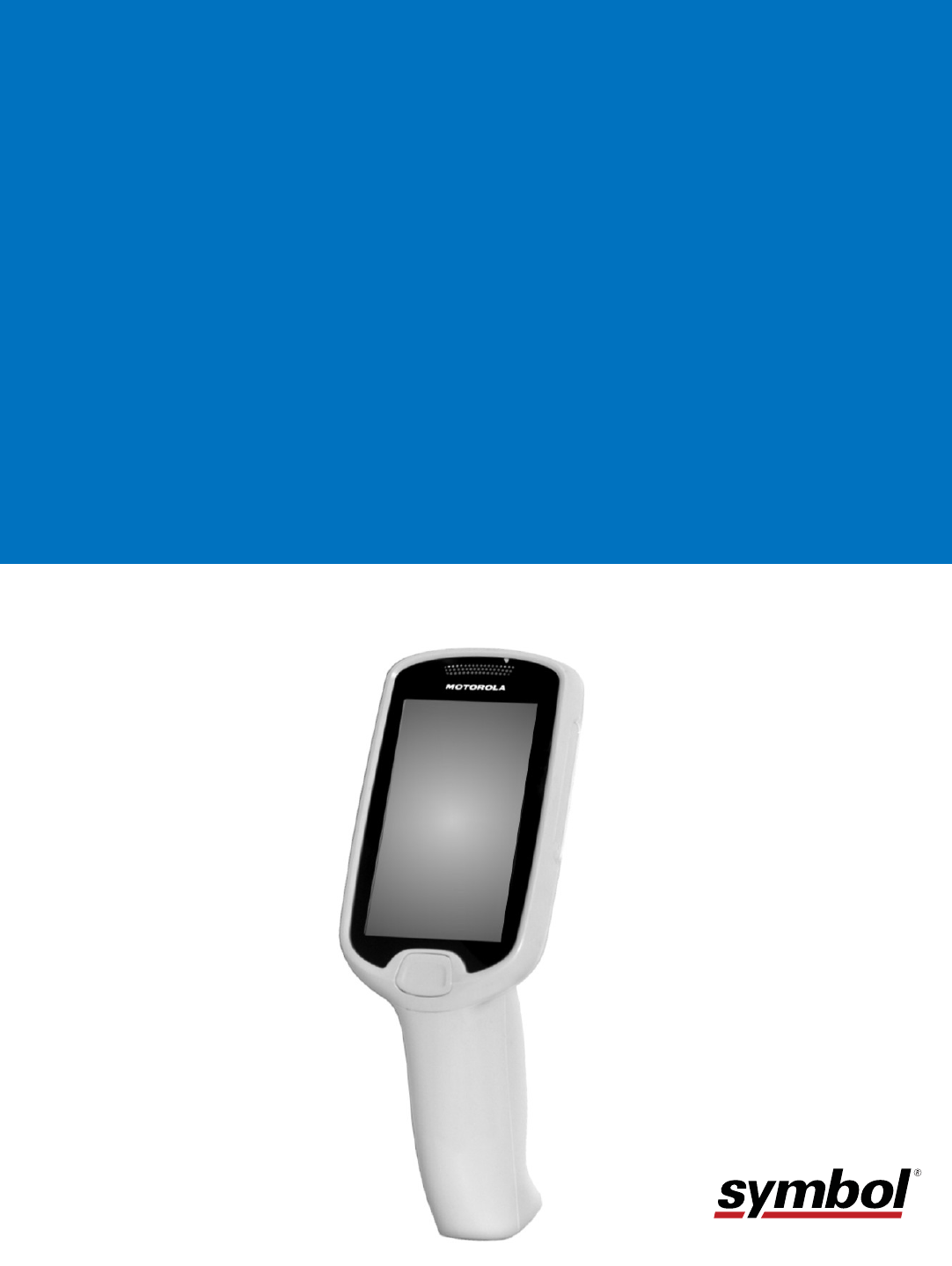
MC18
PRODUCT
REFERENCE GUIDE

MC18
Product Reference Guide
MN000834A01
Rev. A
June 2014

ii MC18 Product Reference Guide
© 2014 by Symbol Technologies, Inc. All rights reserved.
No part of this publication may be reproduced or used in any form, or by any electrical or mechanical means,
without permission in writing from Symbol Technologies. This includes electronic or mechanical means, such
as photocopying, recording, or information storage and retrieval systems. The material in this manual is subject
to change without notice.
The software is provided strictly on an “as is” basis. All software, including firmware, furnished to the user is on
a licensed basis. Symbol Technologies grants to the user a non-transferable and non-exclusive license to use
each software or firmware program delivered hereunder (licensed program). Except as noted below, such
license may not be assigned, sublicensed, or otherwise transferred by the user without prior written consent of
Symbol Technologies. No right to copy a licensed program in whole or in part is granted, except as permitted
under copyright law. The user shall not modify, merge, or incorporate any form or portion of a licensed program
with other program material, create a derivative work from a licensed program, or use a licensed program in a
network without written permission from Symbol Technologies. The user agrees to maintain Symbol
Technologies copyright notice on the licensed programs delivered hereunder, and to include the same on any
authorized copies it makes, in whole or in part. The user agrees not to decompile, disassemble, decode, or
reverse engineer any licensed program delivered to the user or any portion thereof.
Symbol Technologies reserves the right to make changes to any software or product to improve reliability,
function, or design.
Symbol Technologies does not assume any product liability arising out of, or in connection with, the application
or use of any product, circuit, or application described herein.
No license is granted, either expressly or by implication, estoppel, or otherwise under any Symbol
Technologies, Inc., intellectual property rights. An implied license only exists for equipment, circuits, and
subsystems contained in Symbol Technologies products.

iii
Revision History
Changes to the original manual are listed below:
Change Date Description
01 Rev. A 06/27/14 Initial release.

iv MC18 Product Reference Guide

TABLE OF CONTENTS
Revision History.............................................................................................................................. ii
About This Guide
Introduction ..................................................................................................................................... xi
Documentation Set ................................................................................................................... xi
Configurations................................................................................................................................. xii
Software Versions..................................................................................................................... xiii
OEM Software........................................................................................................................... xiii
Fusion Software........................................................................................................................ xiii
Chapter Descriptions ...................................................................................................................... xiv
Notational Conventions................................................................................................................... xv
Related Documents and Software .................................................................................................. xv
Service Information......................................................................................................................... xvi
Chapter 1: Getting Started
Introduction .................................................................................................................................... 1-1
Unpacking ...................................................................................................................................... 1-1
Features ......................................................................................................................................... 1-2
Accessories ................................................................................................................................... 1-4
LED Indicators ............................................................................................................................... 1-5
Keypad ........................................................................................................................................... 1-5
Getting Started ............................................................................................................................... 1-6
Connecting the Battery ................................................................................................................. 1-6
Charging the Battery ................................................................................................................ 1-9
Manual Release of MC18 from the Cradle ............................................................................... 1-10
Software Release of MC18 from the Cradle ............................................................................ 1-11
Starting the MC18 .......................................................................................................................... 1-12
Touch Screens ............................................................................................................................... 1-13
Data Capture ................................................................................................................................. 1-13
Scanning Considerations ......................................................................................................... 1-13
Scanning Bar Codes ................................................................................................................ 1-13
Scanning Tips .................................................................................................................... 1-14
LED Indications ........................................................................................................................ 1-14

vi MC18 Product Reference Guide
Resetting the MC18 ....................................................................................................................... 1-15
Performing a Warm Boot ......................................................................................................... 1-15
Performing a Cold Boot ............................................................................................................ 1-15
Replacing the Bezel ....................................................................................................................... 1-16
Chapter 2: Staging and Provisioning
Introduction .................................................................................................................................... 2-1
Staging ........................................................................................................................................... 2-1
Bar Code Staging ..................................................................................................................... 2-2
On-Demand Staging ................................................................................................................ 2-4
ActiveSync Connection Mode ............................................................................................ 2-4
Already existing IP Connection Mode ................................................................................ 2-4
Well-known WLAN Connection Mode ................................................................................ 2-4
RD Client Main Menu ............................................................................................................... 2-6
Client Info ........................................................................................................................... 2-6
Log Menu ........................................................................................................................... 2-7
View Log ............................................................................................................................ 2-7
View Job Log ..................................................................................................................... 2-8
Set Log Level ..................................................................................................................... 2-8
Set Job Log Level .............................................................................................................. 2-9
Package List ...................................................................................................................... 2-9
Provisioning ................................................................................................................................... 2-11
MSP Agent ............................................................................................................................... 2-11
MSP Agent Main Menu ............................................................................................................ 2-11
Monitor Processing ............................................................................................................ 2-12
Force Check-In .................................................................................................................. 2-12
Package List ...................................................................................................................... 2-12
Client Info ........................................................................................................................... 2-13
Log Menu ........................................................................................................................... 2-13
View Log ............................................................................................................................ 2-14
View Job Log ..................................................................................................................... 2-14
Set Log Level ..................................................................................................................... 2-15
Set Job Log Level .............................................................................................................. 2-15
Hide UI ............................................................................................................................... 2-16
Chapter 3: Wireless Applications
Introduction .................................................................................................................................... 3-1
802.11d Overview .......................................................................................................................... 3-1
Configuring My Country for Use with WLAN on an MC18 ............................................................. 3-1
Enabled 802.11d Network ........................................................................................................ 3-2
Disabled 802.11d Network ....................................................................................................... 3-2
Create WCS Options Registry File .................................................................................... 3-2
Update MC18 via 802.11d Enabled Staging Network ........................................................ 3-2
Connect to the Non-802.11d Network ................................................................................ 3-3
Wireless Application on the MC18T/MC18U ................................................................................. 3-3
Signal Strength Icon ...................................................................................................................... 3-4
Turning Off the Radio .................................................................................................................... 3-5

Table of Contents vii
Chapter 4: ActiveSync
ActiveSync ..................................................................................................................................... 4-1
Installing ActiveSync ...................................................................................................................... 4-1
MC18 Setup ................................................................................................................................... 4-2
Setting Up an ActiveSync Connection on the Host Computer ....................................................... 4-2
Setting up a Partnership .......................................................................................................... 4-3
Chapter 5: Using the Windows CE Desktop
Introduction .................................................................................................................................... 5-1
ActiveSync ..................................................................................................................................... 5-1
Remote Control Software ............................................................................................................... 5-1
Connection to Host Computer ........................................................................................................ 5-1
Programming Cable Removal .................................................................................................. 5-5
App Launcher Window ................................................................................................................... 5-6
Windows CE 7.0 Desktop .............................................................................................................. 5-7
Status Icons ............................................................................................................................. 5-7
Battery Unknown Icon .............................................................................................................. 5-8
Start Button .............................................................................................................................. 5-9
Programs Menu ....................................................................................................................... 5-9
Desktop Display Button ............................................................................................................ 5-10
Entering Information Using the Keyboard Input Panel ............................................................. 5-10
Task Bar and Start Menu Properties ........................................................................................ 5-10
Properties ........................................................................................................................... 5-10
Advanced Tab .................................................................................................................... 5-11
Screen Calibration ......................................................................................................................... 5-11
Waking the MC18 .......................................................................................................................... 5-12
Chapter 6: Special Considerations
Introduction .................................................................................................................................... 6-1
Fonts .............................................................................................................................................. 6-1
Asian Font Installation .............................................................................................................. 6-2
Software Development Considerations .......................................................................................... 6-2
Tips for Improving Battery Charge Time ........................................................................................ 6-2
Cradle-Backlight Feature ......................................................................................................... 6-3
Tips for Improving Battery Life ....................................................................................................... 6-3
Changing the Power Settings .................................................................................................. 6-4
Changing the Display Backlight Settings ................................................................................. 6-4
MC18U Support ....................................................................................................................... 6-5
Chapter 7: Pocket Browser
Introduction .................................................................................................................................... 7-1
Sample Application ........................................................................................................................ 7-1
Chapter 8: Cradle Installation
Introduction .................................................................................................................................... 8-1
Installation of the Cradle ................................................................................................................ 8-1
Removing the Front Cover ....................................................................................................... 8-1

viii MC18 Product Reference Guide
Mounting the Cradle ................................................................................................................. 8-2
Wiring ............................................................................................................................................. 8-4
Assembly ....................................................................................................................................... 8-5
Cradle Location Bar Code ........................................................................................................ 8-6
System Cabling .............................................................................................................................. 8-7
Mounting the Power Supply Housing ............................................................................................. 8-9
Chapter 9: Application Deployment
Software Installation on Development PC ..................................................................................... 9-1
Device Configuration Package ................................................................................................. 9-1
Platform SDK ........................................................................................................................... 9-2
Enterprise Mobility Developer Kits ........................................................................................... 9-2
Installing Other Development Software ................................................................................... 9-2
Deployment .................................................................................................................................... 9-3
ActiveSync ............................................................................................................................... 9-3
IPL ............................................................................................................................................ 9-4
Creating Hex Images ..................................................................................................................... 9-5
Starting Terminal Configuration Manager ................................................................................ 9-5
Defining Script Properties ........................................................................................................ 9-7
Creating the Script for the Hex Image ...................................................................................... 9-8
Opening a New or Existing Script ...................................................................................... 9-8
Updating TCM 1.X Scripts ................................................................................................. 9-8
Copying Components to the Script .................................................................................... 9-8
Saving the Script ................................................................................................................ 9-9
Building the Image ................................................................................................................... 9-9
Sending the Hex Image Using IPL ................................................................................................. 9-10
TCM Error Messages ............................................................................................................... 9-14
IPL Error Detection .................................................................................................................. 9-16
Creating a Splash Screen ........................................................................................................ 9-18
Splash Screen Format ............................................................................................................. 9-18
OS Update ..................................................................................................................................... 9-19
MC18 ....................................................................................................................................... 9-19
MC18 ....................................................................................................................................... 9-21
Flash Storage ................................................................................................................................ 9-23
FFS Partitions .......................................................................................................................... 9-23
Working with FFS Partitions ..................................................................................................... 9-23
RegMerge.dll ...................................................................................................................... 9-23
CopyFiles ........................................................................................................................... 9-24
Non-FFS Partitions .................................................................................................................. 9-24
Downloading Partitions to the MC18 ........................................................................................ 9-25
Chapter 10: Maintenance and Troubleshooting
Introduction .................................................................................................................................... 10-1
Maintaining the MC18 .................................................................................................................... 10-1
Battery Safety Guidelines .............................................................................................................. 10-1
Battery Management ..................................................................................................................... 10-2
Clearing the Battery ................................................................................................................. 10-2
Long Term Storage ........................................................................................................................ 10-3
Cleaning ......................................................................................................................................... 10-4

Table of Contents ix
Materials Required ................................................................................................................... 10-4
Cleaning the MC18 .................................................................................................................. 10-4
Housing .............................................................................................................................. 10-4
Display ............................................................................................................................... 10-4
Scanner Exit Window ......................................................................................................... 10-4
Connector ........................................................................................................................... 10-4
Cleaning Cradle Connectors .................................................................................................... 10-5
Cleaning Frequency ................................................................................................................. 10-5
Troubleshooting ............................................................................................................................. 10-6
MC18 ....................................................................................................................................... 10-6
Cradle ...................................................................................................................................... 10-9
Appendix A: Technical Specifications
Technical Specifications ................................................................................................................ A-1
Cradle ...................................................................................................................................... A-3
Cable Specifications ...................................................................................................................... A-6
Power Supply Cable, Y-type .................................................................................................... A-6
Cradle Interconnection Cable .................................................................................................. A-6
Appendix B: AirBEAM Smart Client
Introduction .................................................................................................................................... B-1
AirBEAM Package Builder ............................................................................................................. B-1
AirBEAM Smart Client .................................................................................................................... B-2
AirBEAM License ..................................................................................................................... B-2
Configuring the AirBEAM Smart Client .................................................................................... B-2
Packages(1) Tab ................................................................................................................ B-2
Packages(2) Tab ................................................................................................................ B-3
Server Tab ......................................................................................................................... B-4
Misc(1) Tab ........................................................................................................................ B-4
Misc(2) Tab ........................................................................................................................ B-5
Misc(3) Tab ........................................................................................................................ B-6
Misc(4) Tab ........................................................................................................................ B-7
Synchronizing with the Server ............................................................................................ B-8
Manual Synchronization ..................................................................................................... B-9
Automatic Synchronization ................................................................................................. B-9
AirBEAM Staging ..................................................................................................................... B-9
Appendix C: App Launcher Configuration
Configuration .................................................................................................................................. C-1
Glossary
Index

x MC18 Product Reference Guide

ABOUT THIS GUIDE
Introduction
This guide provides information about setting up and configuring MC18 mobile computers and installing its
accessories.
Documentation Set
The documentation set for the MC18 is divided into guides that provide information for specific user needs.
MC18 documentation includes:
•
MC18 Quick Reference Guide - describes basic set up and operation of the MC18 and it’s cradles. The
guide also includes regulatory and safety information.
•
MC18 Product Reference Guide (this guide) - describes how to set up, operate and program the MC18 and
it’s accessories.
•
Microsoft Applications for Windows Mobile and WinCE 7.0 User Guide - describes how to use Microsoft
developed applications.
•
Application Guide for Symbol Technologies Enterprise Mobility Devices - describes how to use Symbol
Technologies developed applications.
•
EMDK Help File - provides API information for writing applications.
Software Versions
This guide covers various software configurations and references are made to operating system or software
versions.
OEM Software
Use this procedure to determine the OEM software version on the MC18:
NOTE Some screens or windows shown in this guide may differ from the actual screens shown on the MC18.
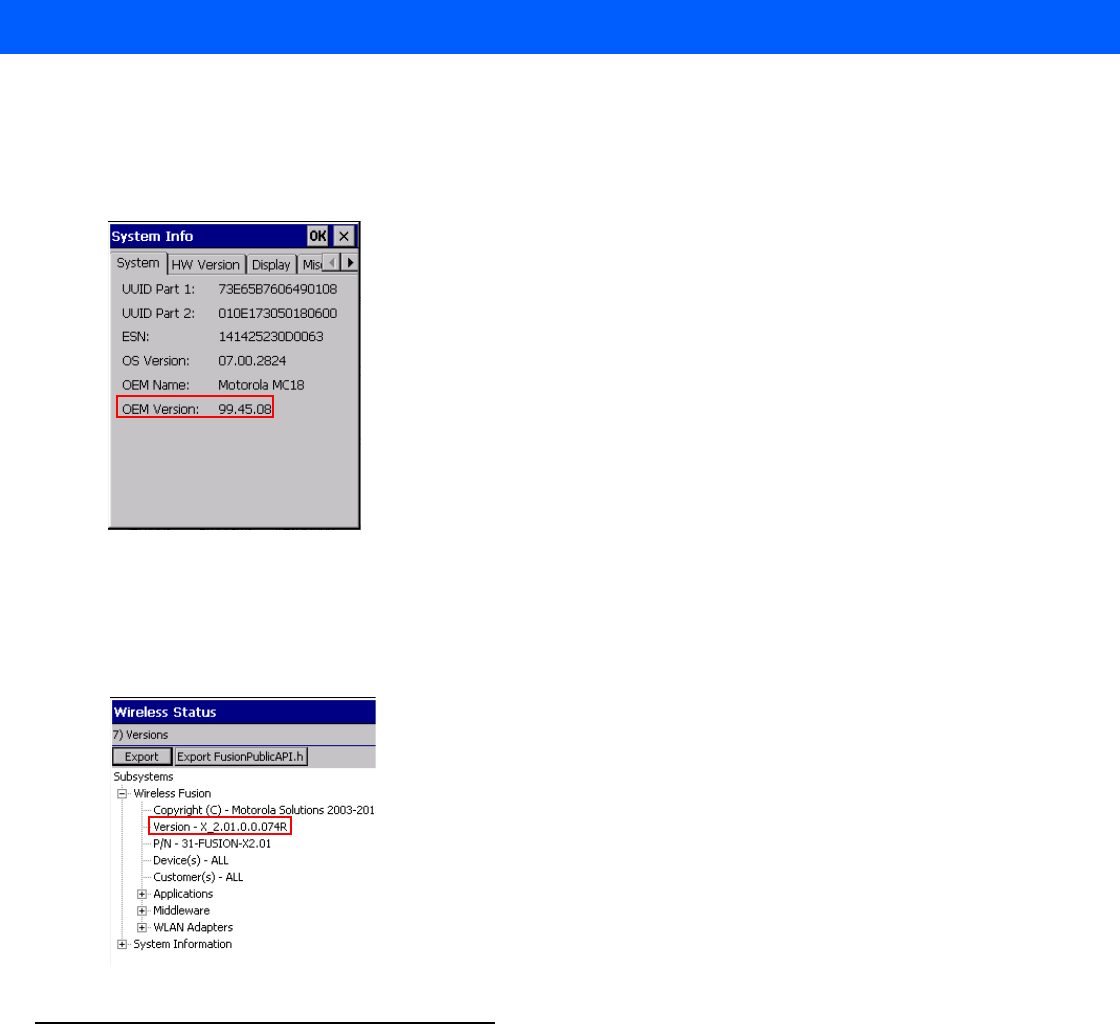
xii MC18 Product Reference Guide
1. Connect the MC18 to a host computer (see Connecting the MC18 to a Host Computer on page 4-2).
2. Click Start > Settings > Control Panel > System Info icon.
3. Make sure that the OEM software version on the MC18 is 99.42.00 or greater:
Fusion Software
To determine the Fusion software version on MC18 with OEM version X_2.01.0.0.062R or greater:
Start > Programs > Fusion > Wireless status > Versions.
Chapter Descriptions
Topics covered in this guide are as follows:
•
Chapter 1, Getting Started, describes the features and basic operation of the MC18, lists the accessories
for the MC18 and explains how to install and charge the batteries and start the MC18 for the first time.
•
Chapter 2, Staging and Provisioning, provides information for staging and provisioning the MC18 using
Mobility Software Platform (MSP).
•
Chapter 3, Wireless Applications, provides instructions for configuring the wireless adapter.
•
Chapter 4, Sync with Host Computer, provides instructions on installing a sync application and setting up
a partnership between the MC18 and a host computer.
•
Chapter 5, Using the Windows CE Desktop, provides instructions for connecting the MC18 to a host
computer and using the OS desktop of the MC18.

About This Guide xiii
•
Chapter 6, Special Considerations, provides information to consider when using and developing
applications for the MC18.
•
Chapter 7, Pocket Browser, provides information on Sample Pocket Browser (mobile application
development tool) provided with the MC18.
•
Chapter 8, Cradle Installation, provides installation instructions for the MC18 cradles and other
accessories.
•
Chapter 9, Application Deployment, provides instructions for installing the Device Configuration Package
(DCP) for MC18 and the EMDK for C on the host computer and downloading software and files to the
MC18.
•
Chapter 10, Maintenance and Troubleshooting, includes instructions on cleaning and storing the MC18,
and provides troubleshooting solutions for potential problems during MC18 operation.
•
Appendix A, Technical Specifications, includes a table listing the technical specifications for the MC18
and accessories.
•
Appendix B, App Launcher Configuration, provides information for configuring the App Launcher
application.
Notational Conventions
The following conventions are used in this document:
•
“Mobile computer” refers to the Symbol Technologies MC18 of mobile computers.
•
Italics are used to highlight the following:
•Chapters and sections in this guide
•Related documents
•
Bold text is used to highlight the following:
•Dialog box, window and screen names
•Drop-down list and list box names
•Check box and radio button names
•Icons on a screen
•Key names on a keypad
•Button names on a screen.
•
Bullets (•) indicate:
•Action items
•Lists of alternatives
•Lists of required steps that are not necessarily sequential.
Sequential lists (e.g., those that describe step-by-step procedures) appear as numbered lists.
NOTE This symbol indicates something of special interest or importance to the reader. Failure to read the note
will not result in physical harm to the reader, equipment or data.
CAUTION This symbol indicates that if this information is ignored, the possibility of data or material damage
may occur.

xiv MC18 Product Reference Guide
Related Documents and Software
The following documents provide more information about the MC18 mobile computers.
•
MC18 Quick Reference Guide, p/n MN000835A01
•
Microsoft Applications for Windows Mobile and CE 7.0 User Guide, p/n 72E-78456-xx
•
Enterprise Mobility Developer Kits, available at:
•
Device Configuration Package (DCP for MC18 v99.45.00xx) and Platform SDK for MC18 with Windows
CE 7.0, available at: http://www.motorolasolutions.com/support
•
Latest ActiveSync (Windows xp) or Windows Mobile Device Center (Windows 7) software, available at:
http://www.microsoft.com.
For the latest version of this guide and all guides, go to: http://www.motorolasolutions.com/support
Service Information
If you have a problem with your equipment, contact Symbol Technologies Global Customer Support for your
region. Contact information is available at: http://www.motorolasolutions.com/support.
When contacting Symbol Technologies Global Customer Support, please have the following information
available:
•
Serial number of the unit
•
Model number or product name
•
Software type and version number.
Symbol Technologies responds to calls by E-mail, or telephone within the time limits set forth in support
agreements.
If your problem cannot be solved by Symbol Technologies Global Customer Support, you may need to return
your equipment for servicing and will be given specific directions. Symbol Technologies is not responsible for
any damages incurred during shipment if the approved shipping container is not used. Shipping the units
improperly can possibly void the warranty.
If you purchased your Symbol Technologies business product from a Symbol Technologies business partner,
contact that business partner for support.
WARNING!This symbol indicates that if this information is ignored the possibility that serious personal
injury may occur.

CHAPTER 1 GETTING STARTED
Introduction
This chapter describes the features of the MC18 and explains how to install and charge the battery, how to
capture data using the integrated Imager and how to reset the MC18.
Unpacking
Carefully remove all protective material from the MC18 and save the shipping container for later storage and
shipping.
Verify that box contains all the equipment listed below:
•
MC18
•
Lithium-ion battery
•
Quick Reference Guide
Inspect the equipment for damage. If you are missing any equipment or if you find any damaged equipment,
contact Symbol Technologies Support immediately. See Service Information on page xiv for contact
information.
Removing the Screen Protection Film
A screen protection film is applied to the MC18 screen to protect the screen during shipping. To remove the
screen protector, carefully lift the thin film off the display.
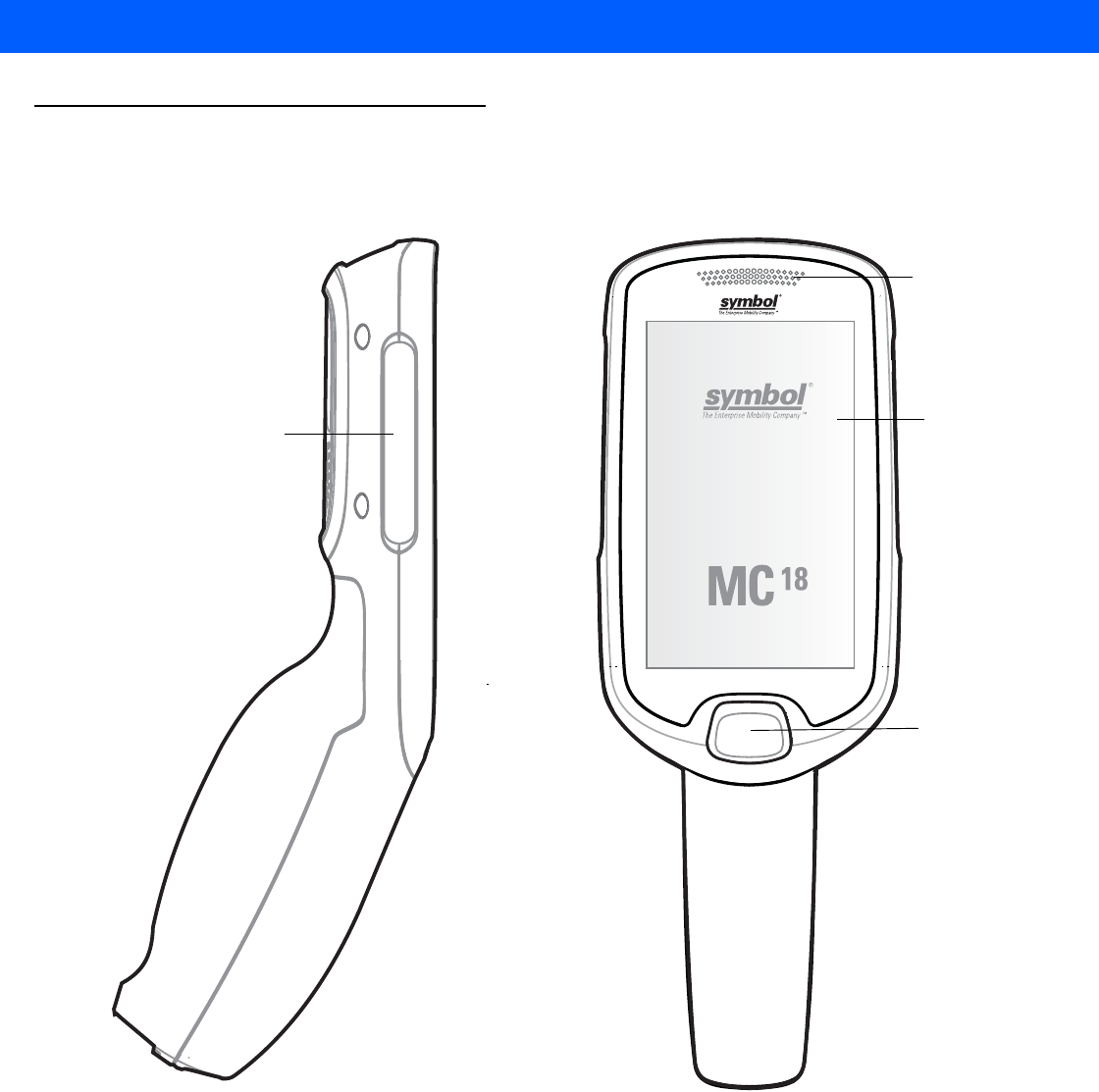
1 - 2 MC18 Product Reference Guide
Features
Figure 1-1
Front View
Mobile Computer Series
Status LED
Display
Scan Key
Branding Plate Slot

Special Considerations 1 - 3
Figure 1-2
Back View
Battery Cover
Speaker
Power Connector
Scan Exit Window
Branding Plate Slot
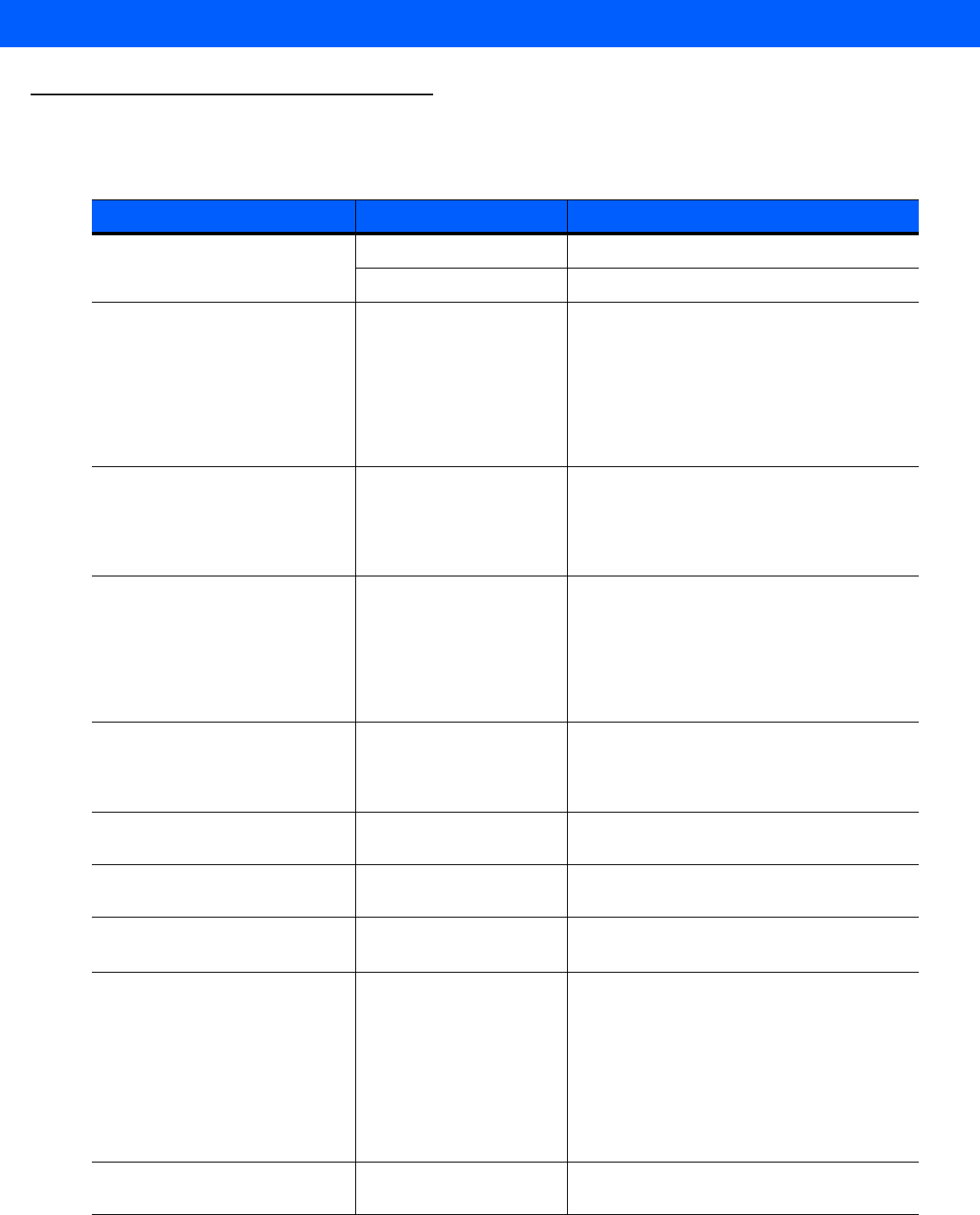
1 - 4 MC18 Product Reference Guide
Accessories
Table 1-1
Accessories
Accessory Part Number Description
MC18 Lithium Ion Battery BTRY-MC18-27MAG-01 MC18 Lithium Ion Battery.
BTRY-MC18-27MAG-10 MC18 Lithium Ion Battery (
QTY-10
).
High Density (HD) Three Slot
Cradle (Locking).
CRD-MC18-3SLCKH-01
The cradle is used for docking up to three
MC18 units in HD installation configuration.
The cradle slots are equipped a mechanism
that locks the MC18 units inside the slots.
Three Slot Cradle Requires
PWRS-14000-241R, DC line cord and
Country Specific AC line cord sold
separately.
High Density (HD) Three Slot
Cradle (Non-Locking)
CRD-MC18-3SLOTH-01
The cradle is used for docking up to three
MC18 units in HD installation configuration.
Requires PWRS-14000-241R, DC line cord
and country specific AC line cord (sold
separately).
Super High Density (SHD) Three
Slot Cradle (Locking)
CRD-MC18-3SLCKS-01
The cradle is used for docking up to three
MC18 units in SHD installation configuration.
The cradle slots are equipped a mechanism
that locks the MC18 units inside the slots.
Requires PWRS-14000-241R, DC line cord
and country specific AC line cord sold
separately.
Single Slot Cradle
CRD-MC18-1SLOT-01
The cradle is used for docking a single MC18.
Requires power supply unit
(PWRS-14000-241R), DC line cord and
country specific AC line cord sold separately.
Release Key. KT-MC18-CKEY-20 Tool used to mechanically unlock the MC18
from a Three Slot Cradle.
MC18 Terminal Reboot Tool KT-MC18-REBOOT-05 Tool used for cold reboot of the MC18
(QTY-5).
Three Slot Cradle Front Panel
Removing Tool
KT-MC18-CTOOL-01 Tool used for removing the cradle cover.
Deployment Kit
KT-MC18-CSTKIT-01 Includes:
•
20-pack of Release Key
(KT-MC18-CKEY-20)
•
5-pack of Terminal Reboot Tool
KT-MC18-REBOOT-05)
•
One Three Slot Cradle Front Panel
Removing Tool (KT-MC18-CTOOL-01)
Single Slot Cradle Release Key PSS-3KY01-00R
Key used to mechanically unlock the MC18
from a single slot cradle (QTY-20)
.
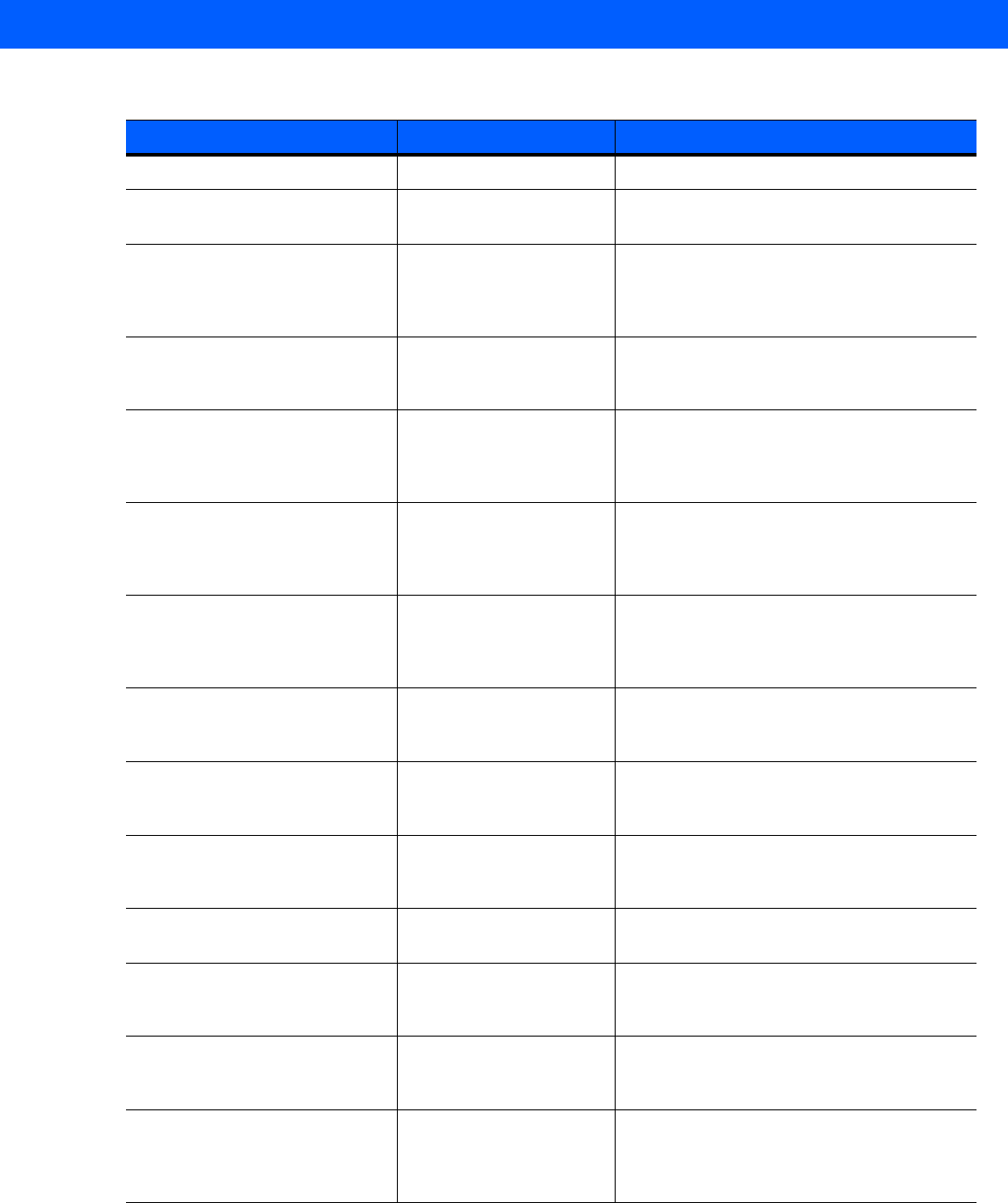
Special Considerations 1 - 5
Cart Holder Mounting Kit PSS-3SH01-00R Kit
for mounting the MC18 on a shopping cart.
Programming Cable CBL-MC18-USB1-01
USB communication cable for connecting the
MC18 to a host computer.
Interconnection Cable 25-66431-01R
An extension cable (12.6 Inch / 32 centimeter)
for connection three slot cradle to
DC “Y”
charging cable that is connected to
power
supply unit (PWRS-14000-241R).
Power Extension Cable CBL-MC18-EXINT1-01
Cable (12.6 Inch / 32 centimeter) for daisy
chain connection of two Three Slot Cradles to
one power supply unit (PWRS-14000-241R).
DC Charging Cable 25-66420-01R
DC charging cable (19.5 Inch / 49.5
centimeter) used to connect a power supply
unit (PWRS-14000-241R) to one single-slot
cradle.
DC “Y” Charging Cable Long 25-67592-01R
DC “Y” charging cable (39.7 Inch / 1 meter).
Connects a power supply unit
(PWRS-14000-241R) to two separate Three
Slot Cradles.
DC “Y” Charging Cable Short 25-66210-01R
DC “Y” charging cable (19.5 Inch / 1 meter).
Connects a power supply unit
(PWRS-14000-241R) to two separate Three
Slot Cradles.
Power Supply Unit
PWRS-14000-241R
100-240VAC, 12VDC, 9A. Requires country
specific AC line cord and DC cable - all sold
separately.
AC Line Cord
23844-00-00R
AC Line Cord, 7.5 feet long, grounded, three
wire for power supplies. Associated Country:
United States
AC Line Cord
50-16000-221R
AC Line Cord, 1.8 meter, meter grounded,
three wire, USA NEMA 5-15P. Associated
Country: United States
AC Line Cord
50-16000-671R
AC Line Cord, 1.8 meter, grounded, three wire,
CIE 23-16 plug. Associated Country: Italy.
AC Line Cord
50-16000-217R
AC Line Cord, 1.9 meter, grounded, three wire,
AS 3112 plug. Associated Country: Australia,
New Guinea
AC Line Cord
50-16000-218R
AC Line Cord, 1.8 meter, grounded, three wire,
NEMA 1-15P plug. Associated Country:
Japan.
AC Line Cord
50-16000-219R
AC Line Cord, 1.8 meter, grounded three wire,
BS1363 plug. Associated countries: Hong
Kong, Iraq, Malaysia, Singapore, United
Kingdom.
Table 1-1
Accessories
Accessory Part Number Description
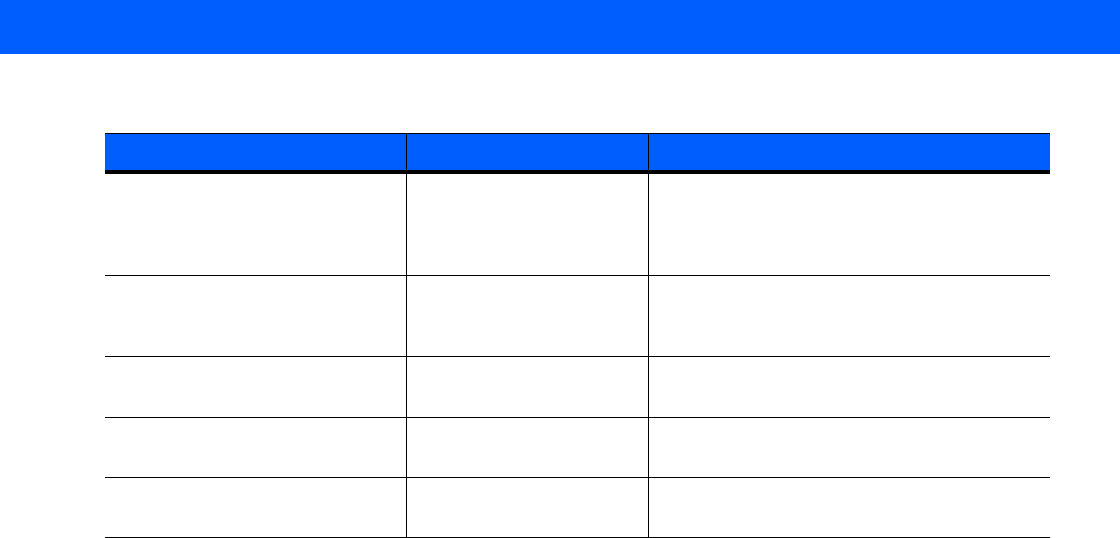
1 - 6 MC18 Product Reference Guide
AC Line Cord
50-16000-220R
AC Line Cord, 1.8 meter, grounded three wire
CEE 7/7plug. Associated countries: Europe,
Abu Dhabi, Bolivia, Dubai, Egypt, Iran, Russia,
Vietnam.
AC Line Cord
50-16000-257R
AC Line Cord, 1.8 meter, grounded three wire,
IEC 60320 C13 plug. Associated Country:
China.
AC Li nd Cord
50-16000-669R
1.9 meter grounded three wire, BS 546 Plug.
Associated country: India.
AC Li nd Cord
50-16000-672R
1.9 meter grounded three wire, S132 Plug.
Associated country: Israel.
AC Li nd Cord
50-16000-678R
36 Inch grounded three wire.
Associated country: United States
Table 1-1
Accessories
Accessory Part Number Description
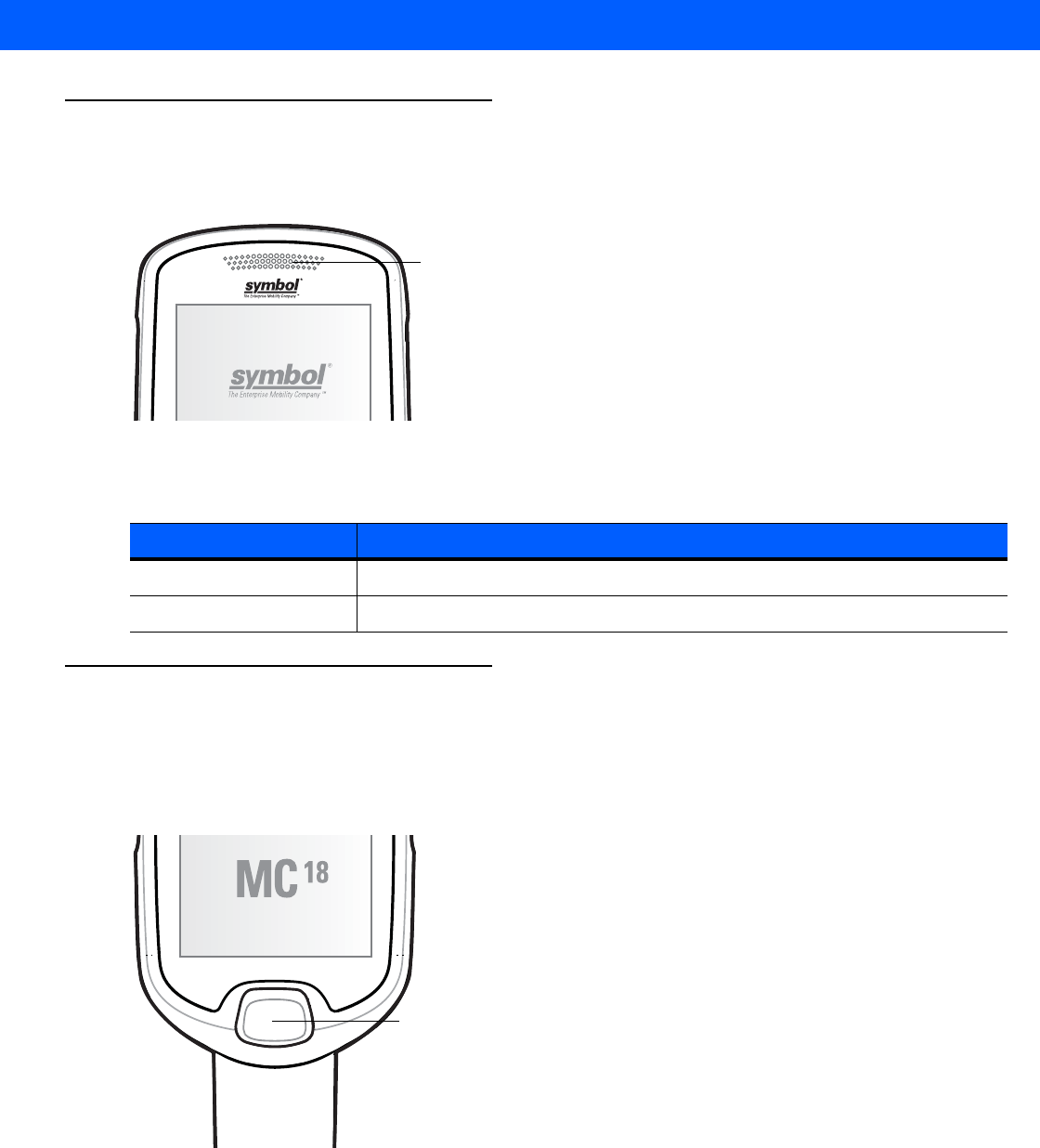
Special Considerations 1 - 7
Status LED
The Status LED indicates the condition of the MC18. Table 1-2 describes the Status LED indications.
Figure 1-3
MC18 Status LED
Scan Key
The scan key operates the imager camera when a scanning application is active. When turned off, pressing
the scan key powers on the MC18.
Note that Scan Key functions can be changed by an application so the MC18’s Scan Key may not function
exactly as described. Refer to the EMDK Help file for detailed information for programming the Scan Key.
Figure 1-4
Scan Key
Table 1-2
Status LED Indications
LED State Indication
Off
Normal operation or MC18 is turned off.
Single Green blink
Successful Decode.
Status LED
Mobile Computer Series
Scan Key
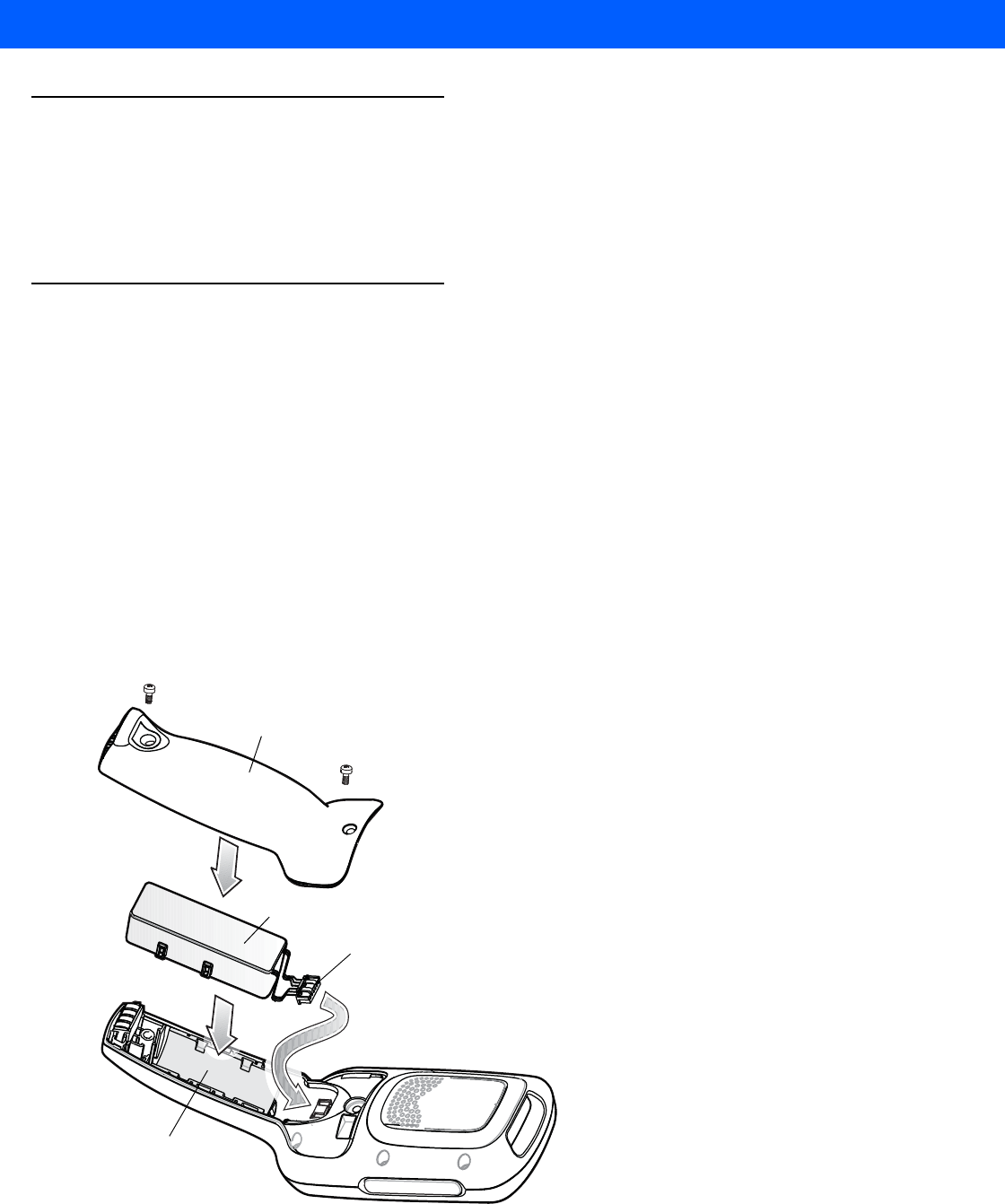
1 - 8 MC18 Product Reference Guide
Getting Started
To start using the MC18 for the first time:
•
Install the battery
•
Charge the battery.
Installing the Battery
To start using the MC18, the battery must be installed and charged.
To install the battery:
1. Using Torx T8 drive, remove two screws that secure the battery cover.
2. Lift the battery cover from the handle.
3. Guide and press the battery cable connector into the female connector inside the battery compartment.
The connector is designed to only fit one way.
4. Place the battery inside the battery compartment.
5. Place the battery cover onto the handle.
6. Secure the battery cover with the two Torx screws using a T8 Torx drive. Torque the screws to 3.6 Kgf-cm
(3.1 in-lb).
Figure 1-5
Installing the Battery
Battery Cover
Battery
Battery
Compartment
Battery
Cable
Connector
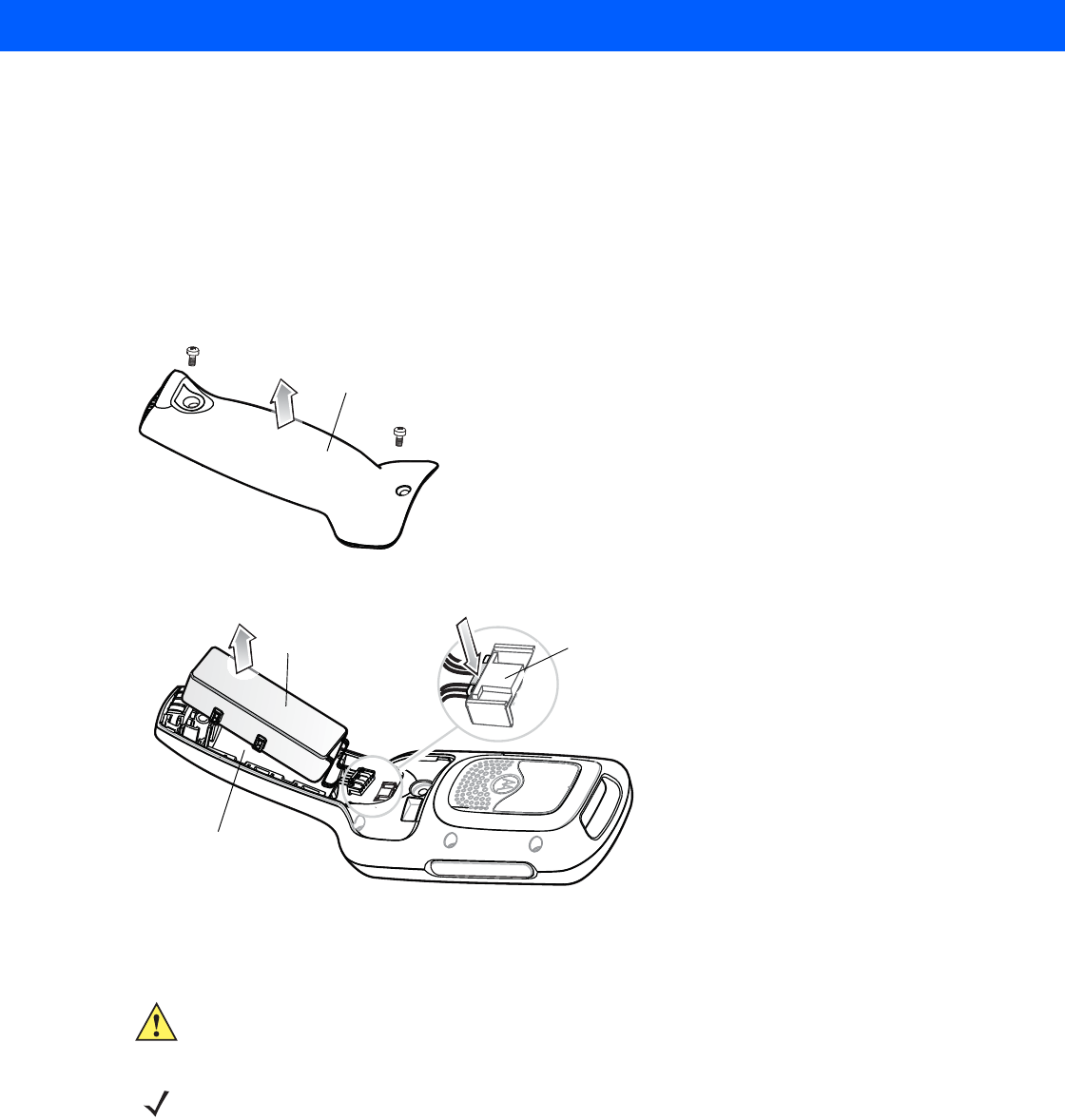
Special Considerations 1 - 9
Removing the Battery
To remove the battery:
1. Use T8 Torx drive to remove the two screws that secure the battery cover.
2. Lift the battery cover from the handle.
3. Inside the battery compartment, press down the plastic tab of the Battery cable connector and slide it out of
the female connector.
4. Remove the battery from the battery compartment.
Figure 1-6
Removing the Battery
Charging the Battery
Before using the MC18 for the first time, charge the battery. The battery fully charges in approximately four
hours.
Use this procedure to charge the battery:
1. Ensure the cradle is connected to the appropriate power source. See Chapter 8, Cradle Installation for
more information.
Battery Cover
Battery
Battery Compartment
Battery Cable Connector
Press down plastic tab to release
CAUTION Ensure that you follow the guidelines for battery safety described in Battery Safety Guidelines on page
10-1.
NOTE Battery life is based upon the following; MC18 usage, WLAN radio is set to maximum power mode, WLAN
is associated with an Access Point and display backlight set to 25% brightness.
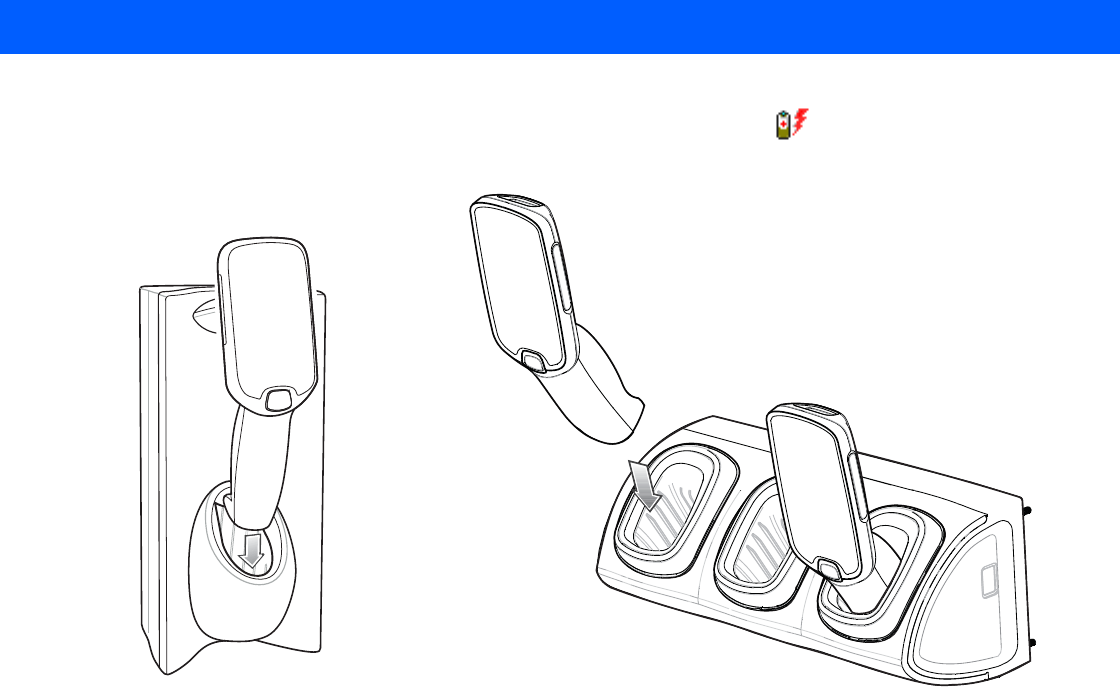
1 - 10 MC18 Product Reference Guide
2. Dock the MC18 in a cradle. The MC18 starts to charge automatically and is shown on the taskbar.
Figure 1-7
Docking MC18 into Cradle
Three Slot Cradle
Single Slot Cradle
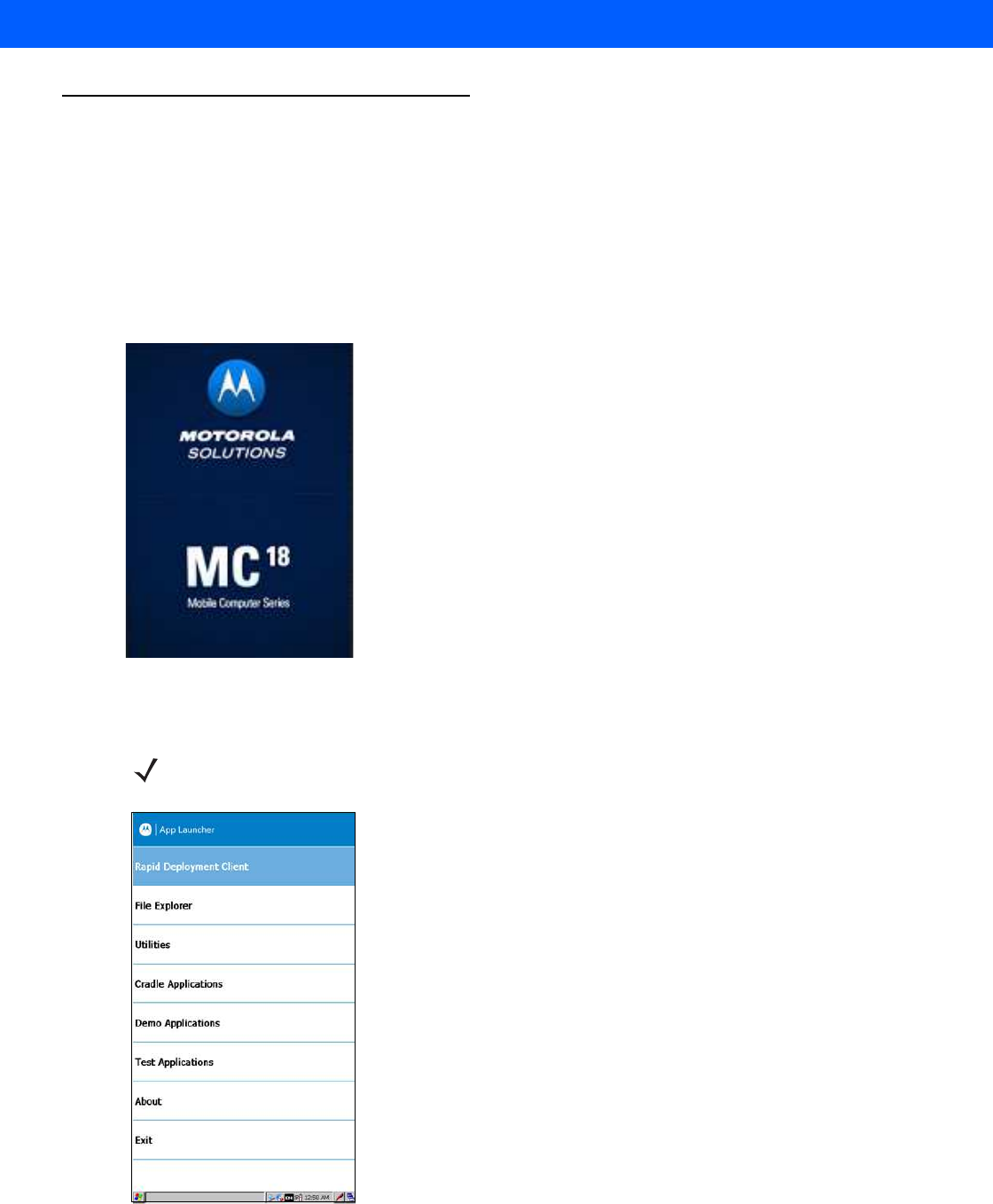
Special Considerations 1 - 11
Starting the MC18
The MC18 starts automatically as soon as power is applied; either with a charged battery installed or when
inserted into the cradle.
If charged battery is installed and the MC18 is turned off, hold the scan key pressed for five seconds to turn on.
If the MC18 does not power on, perform a cold boot (see Performing a Cold Boot on page 1-17).
When the MC18 is powered on for the first time, it initializes its system. The splash screen appears for a short
period of time.
Figure 1-8
Splash Screen
On the MC18, the splash screen is followed by the App Launcher window.
Figure 1-9
App Launcher Window
NOTE App Launcher window may vary depending upon the MC18 operating system version.
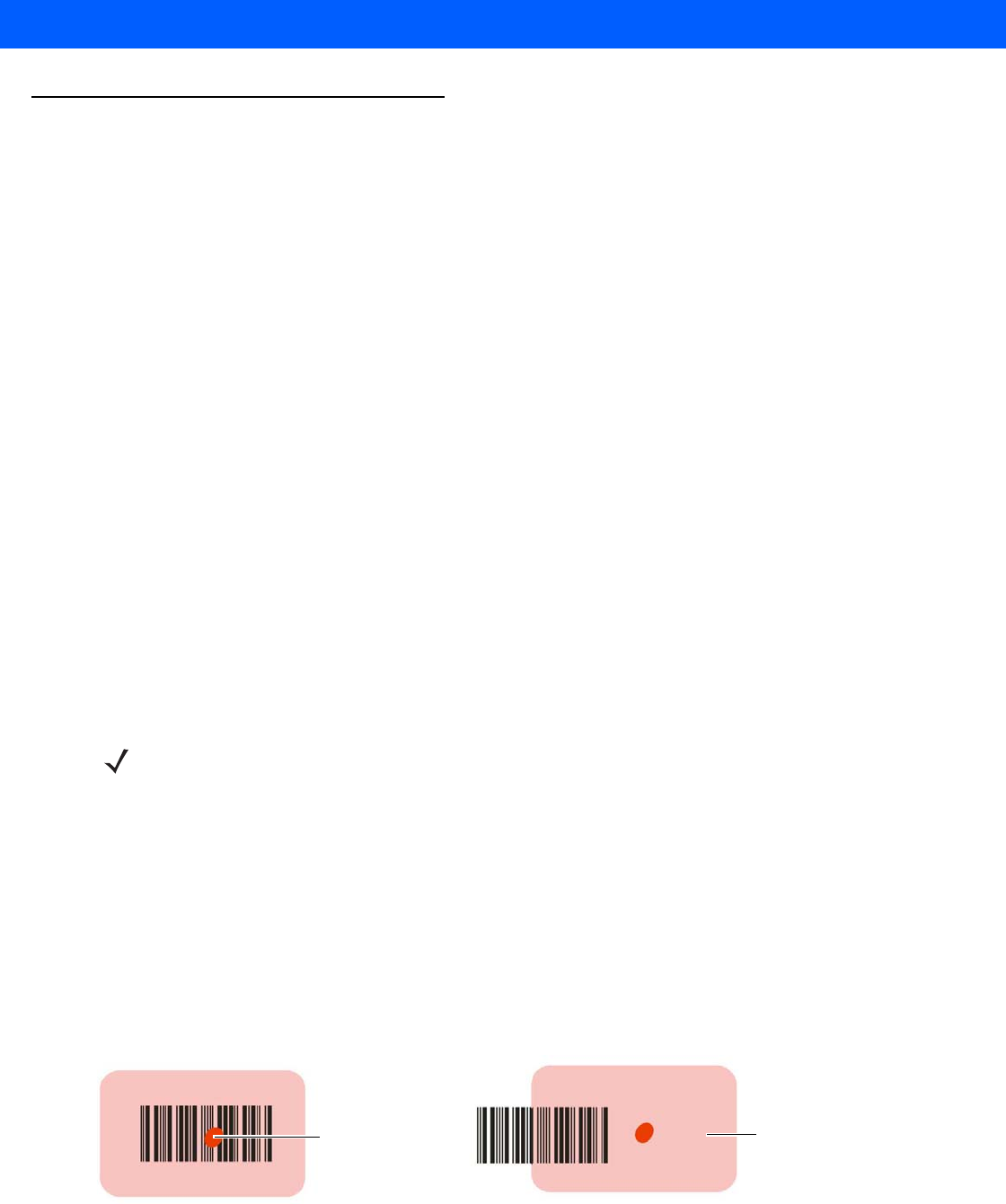
1 - 12 MC18 Product Reference Guide
Data Capturing
The MC18 uses a imager to allow collection of data by scanning bar codes.
The scanner has the following features:
•
Reads a variety of bar code symbologies, including the most popular linear, postal, and 2-D code types
(see Appendix , Technical Specifications).
•
Contains advanced intuitive aiming light for easy point-and-shoot operation.
Scanning Considerations
Typically, scanning is a simple matter of aim, scan/decode and a few quick trial efforts master it. However, two
important considerations can be used to optimize any scanning performance:
•
Range
Any scanning device decodes well over a particular working range — minimum and maximum distances
from the bar code. This range varies according to bar code density and scanning device optics.
Scanning within range brings quick and constant decodes; scanning too close or too far away prevents
decodes. Move the MC18 closer and further away to find the right working range for the bar codes being
scanned. However, the situation is complicated by the availability of various integrated scanning modules.
The best way to specify the appropriate working range per bar code density is through a chart called a
decode zone for each scan module. A decode zone simply plots working range as a function of minimum
element widths of bar code symbols.
•
Angle
Don’t scan at too sharp an angle; the scanner needs to collect scattered reflections from the scan to make
a successful decode. Practice quickly shows what tolerances to work within.
Scanning Bar Codes
1. Ensure that a scan enabled application (for example: Scanning Sample) is loaded and enabled on the
MC18.
2. From the App Launcher screen, touch Demo Applications > Scanning Sample.
3. Aim the scan exit window at the bar code.
4. Press the scan key.
Ensure the red aiming dot is at the center of the bar code. The LED changes from red to green and audible
beep sounds if bar code was decoded successfully.
Figure 1-10
Imager Aiming Pattern
NOTE Contact the Symbol Technologies Global Customer Support if chronic scanning difficulties develop.
Decoding of properly printed bar codes should be quick and effortless.
Wrong
Right
Red Illumination Light
Red Aiming Dot
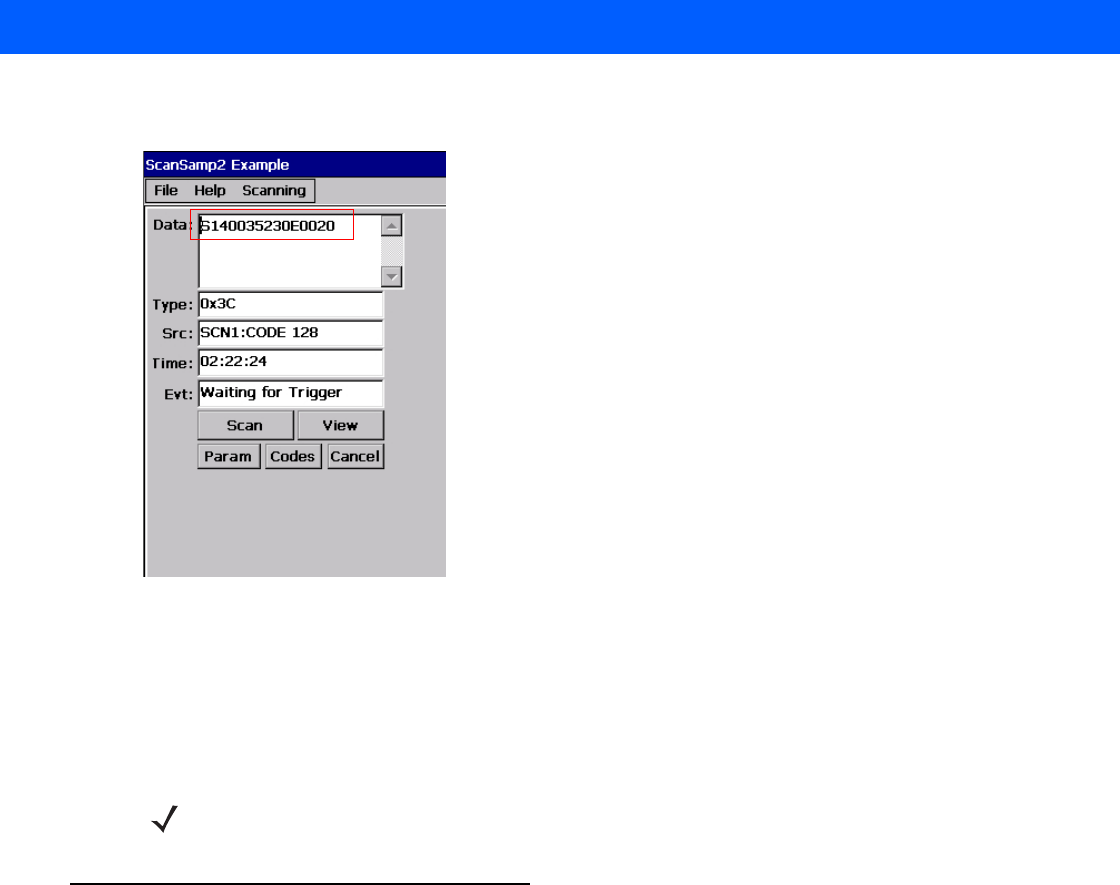
Special Considerations 1 - 13
5. Release the Scan key. The bar code data is displayed on the screen.
Figure 1-11
Scanning Sample Application Screen
Scanning Tips
Optimal scanning distance varies with bar code density and scanner optics.
•
Hold the scanner farther away for larger symbols.
•
Move the scanner closer for symbols with bars that are close together.
DataWedge
DataWedge is an application that reads data from a scanning source, processes the data and sends the data
to an application as if the user is entering it on a keyboard. By default, DataWedge is disabled. To use
DataWedge Enable DataWedge.
Enable DataWedge
Use this procedure to enable DataWedge:
1. Select Start > Settings > Control Panel > DataWedge icon.
2. Select Basic Configuration.
3. Select 1. Scanner input.
4. Select Low cost Imager:
5. Select 1. Enabled.
6. Click 0. Back.
7. Click 0. Back.
NOTE Scanning procedures depend on the application and MC18 configuration. An application may use
different scanning procedures from the one listed above.
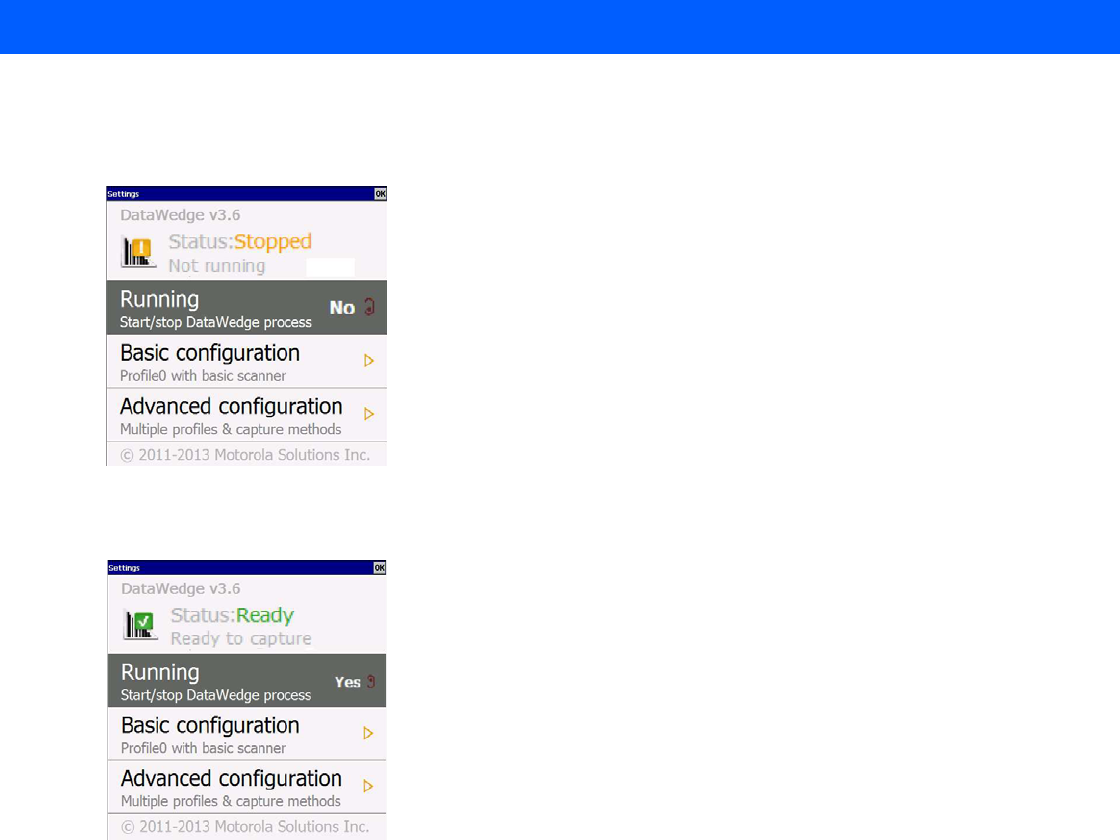
1 - 14 MC18 Product Reference Guide
8. Click 0. Back.
9. Click 0. Exit.
Figure 1-12
DataWedge Stopped
10. Select Running to start the DataWedge process. The DataWedge Status changes to Ready.
Figure 1-13
DataWedge Running
11. Click OK to exit.
Disable DataWedge
Use this procedure to disable DataWedge:
1. Select Start > Settings > Control Panel > DataWedge icon.
2. Select the Running option to end the DataWedge process. The DataWedge Status changes to Stopped.
3. Select OK.
Using DataWedge to Read bar Codes
To read bar codes with DataWedge:
1. Enable DataWedge.
2. Open an application and select a text box or field for entering the bar code data.
3. Use one of the optional scanners and capture the bar code data. The data appears in the text box.
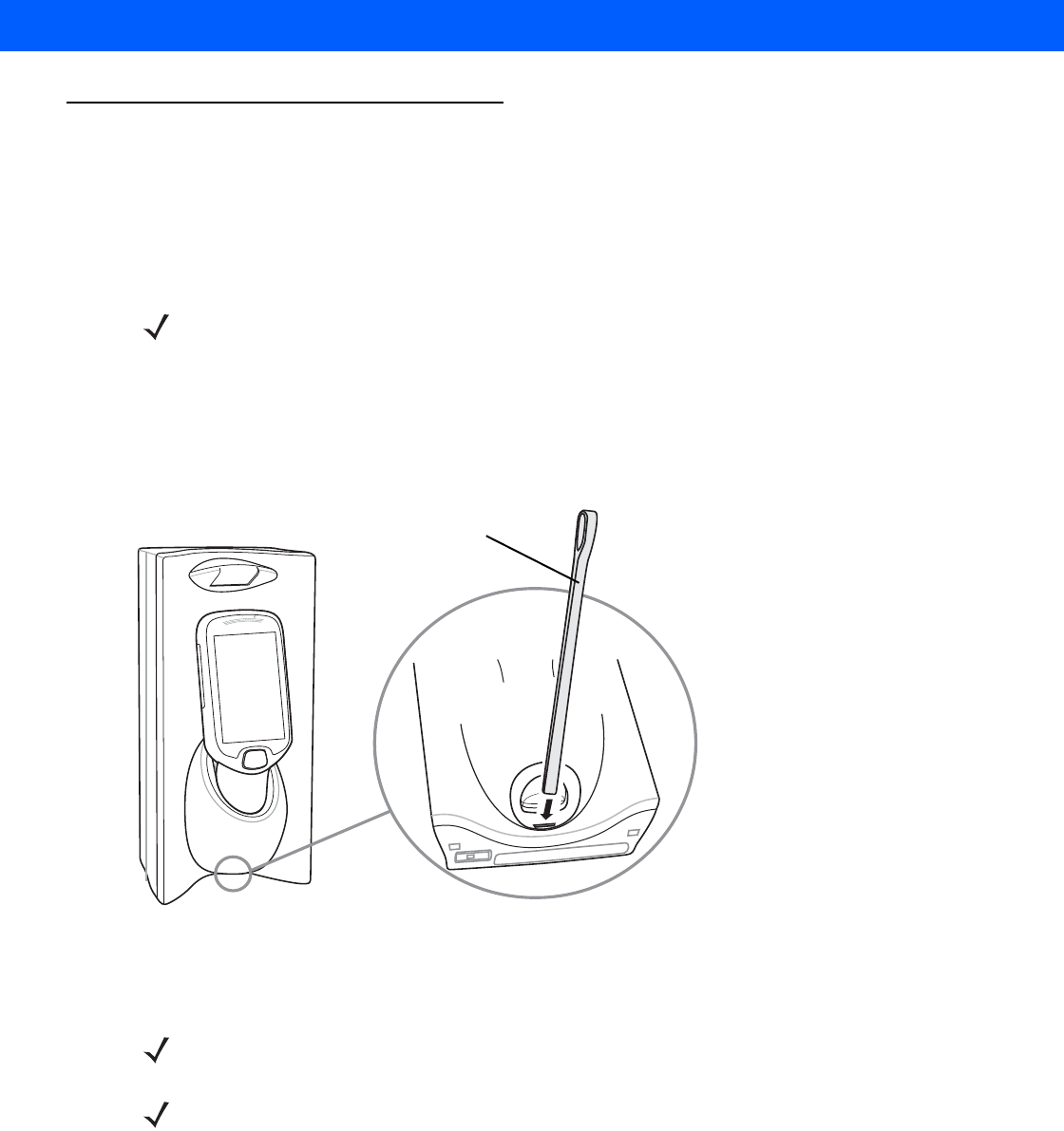
Special Considerations 1 - 15
Manual Release of MC18 from Cradles
The MC18 cradles contain a locking mechanism that locks the MC18 inside the cradle when docked. The
MC18 releases from the cradle when a software command is received from the system. If the MC18 fails to
un-lock during normal operation, use a release key to un-lock the MC18.
Manual Release of MC18 from the Single-Slot Cradle
To release a locked MC18 from a single slot cradle:
1. Insert the release key into the slot located at the bottom side of the cradle.
2. While pressing the release key all the way into the slot, remove the MC18 from the cradle
Figure 1-14
Manual Release of MC18 from a Single Slot Cradle
Three Slot Cradles
To release a locked MC18 from a three slot cradle:
1. Insert the release key straight into the slot, to a point where the bend stops.
2. Hold the release key pressed inside the slot and remove the MC18 from the slot.
NOTE The MC18 also can be released by software command using the PocketBrowser application (see Sample
Application on page 7-1).
AB
Release Key
NOTE The cradle includes models that do not have locking mechanism. To identify the model of cradle, refer to
Table 1-1 on page 1-4.
NOTE The MC18 also can be released by software command using the Cradle Utility application (see Setting
and Controlling the Cradle on page 6-9).
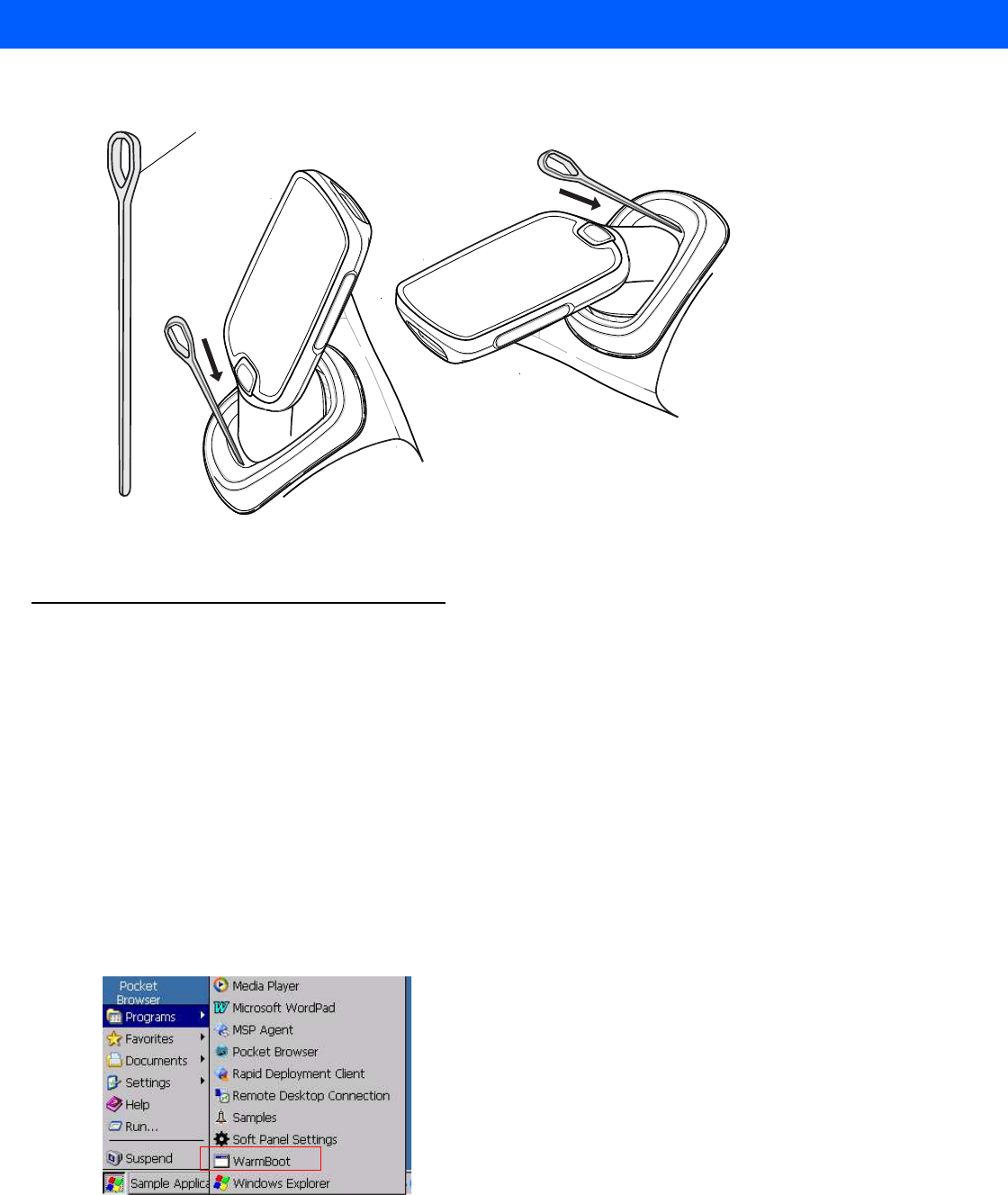
1 - 16 MC18 Product Reference Guide
Figure 1-15
Manual Release of MC18 from a Three Slot Cradle
Resetting the MC18
There are two types of resets, warm boot and cold boot. A warm boot restarts the MC18 by closing all running
programs.
A cold boot also restarts the MC18, but erases all stored records and entries in RAM. In addition it returns
formats, preferences and other settings to the factory default settings.
Perform a warm boot first. This restarts the wearable terminal and saves all stored records and entries. If the
wearable terminal still does not respond, perform a cold boot.
Performing a Warm Boot
Use this procedure to perform a warm boot:
1. From the Start menu, click Programs to launch the Programs menu.
2. Click Warm Boot.
Figure 1-16
Performing a Warm Boot
Release Key
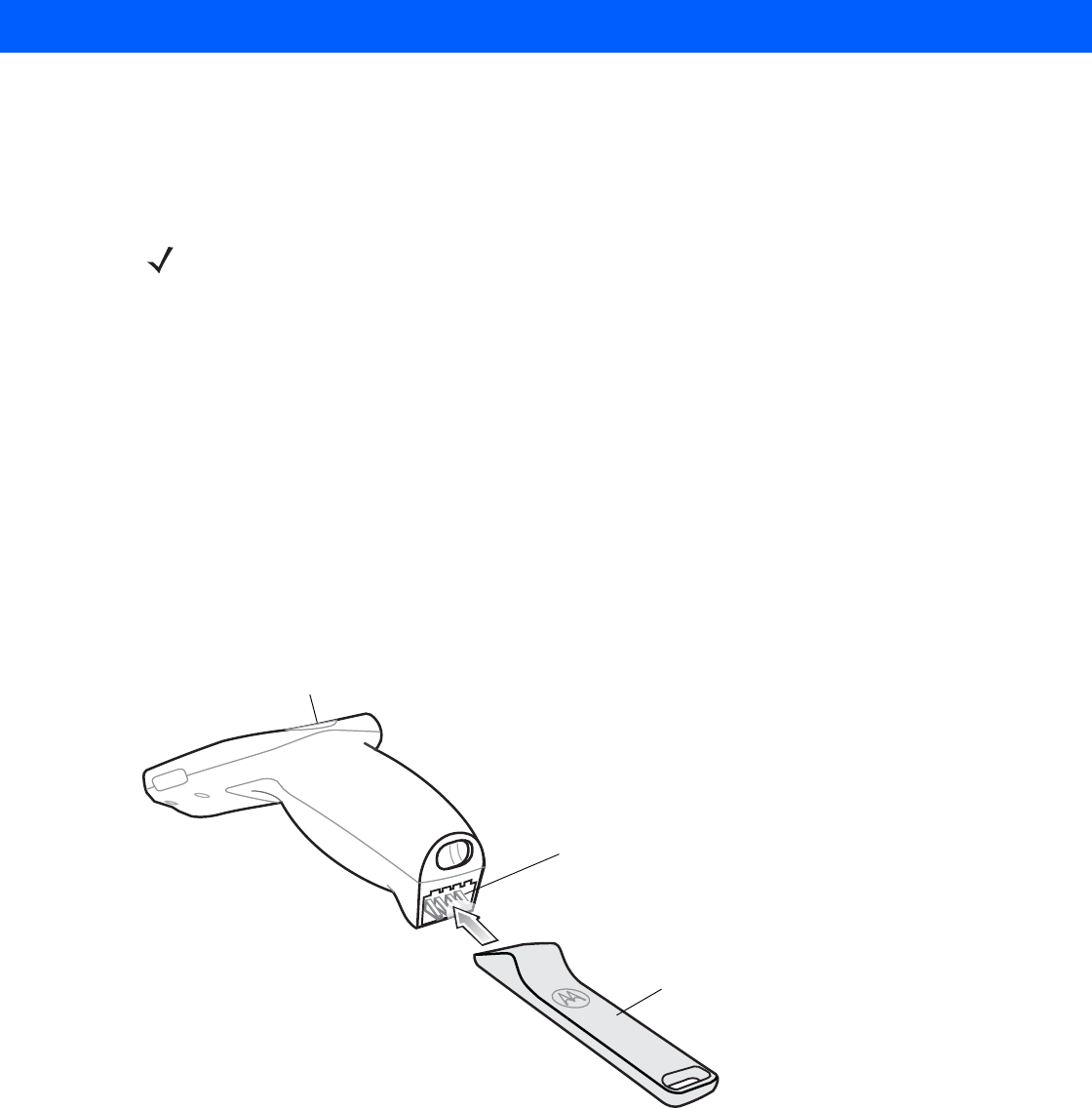
Special Considerations 1 - 17
Performing a Cold Boot
A cold boot restarts the MC18 and erases all user stored records and entries that are not saved in flash
memory (Application and Platform folders). Never perform a cold boot unless a warm boot does not solve the
problem.
Performing Cold Boot when the MC18 is Docked Inside the Cradle
Use this procedure to perform a cold boot when the MC18 is docked inside the cradle:
1. Press and hold the scan key for 10 seconds until the display powers off.
2. Release the scan key when the MC18 re-boots.
Performing Cold Boot when MC18 is Out of the Cradle
Use this procedure to perform a cold boot when the MC18 is out of the cradle:
1. Insert the terminal reboot tool into the MC18 power connector and then press and hold the scan key for 10
seconds until the display powers off - the MC18 reboots.
2. Release the scan key and remove the terminal reboot tool from the MC18.
Figure 1-17
Terminal Reboot Tool
NOTE Any data previously synchronized with a computer can be restored during the next ActiveSync operation.
Terminal Reboot Tool
Scan Key
Power Connector

1 - 18 MC18 Product Reference Guide

CHAPTER 2 STAGING AND PROVISIONING
Introduction
This chapter describes how to stage and provision the MC18 mobile computers using Mobility Services
Platform (MSP) 3.X.
Staging
Staging is the process of setting up the MC18 to download packages for provisioning. The MC18 uses the
Rapid Deployment (RD) Client for staging.
The RD Client enables simple and rapid provisioning of new (out of the box) mobile computers and simplifies
the out-of-box provisioning by scanning bar codes or connecting to a profile server. The RD Client acts as a
frontend for wireless radio configuration and AirBEAM Smart components, automating the manual
configurations that would normally be required to use these tools.
An MSP Administrator uses the MSP Console for the creation of an RD profile that contains all the wireless
network and security information (for example, ESSID, WEP Keys, etc.) required to get a MC18 onto the
wireless network. The profile also contains FTP server access information needed to connect to the
provisioning MSP and the list of software packages to be provisioned to the MC18 from the provisioning MSP.
The RD profile can then be encoded into an RD bar code sheet and printed from the MSP Console or loaded
onto a profile server.
NOTE The MSP 3.0 Rapid Deployment Client enables staging by scanning staging profiles encoded into staging
bar code sheets. It also enables staging to be performed without scanning bar codes through the use of
On-Demand Staging.
When using On-Demand Staging, the RD Client pulls staging profiles directly from an On-Demand Profile
Server over some form of pre-configured or automatically-configured IP connection.
For detailed information about the MSP 3.X, refer to the Mobility Services Platform 3.X User’s Guide.
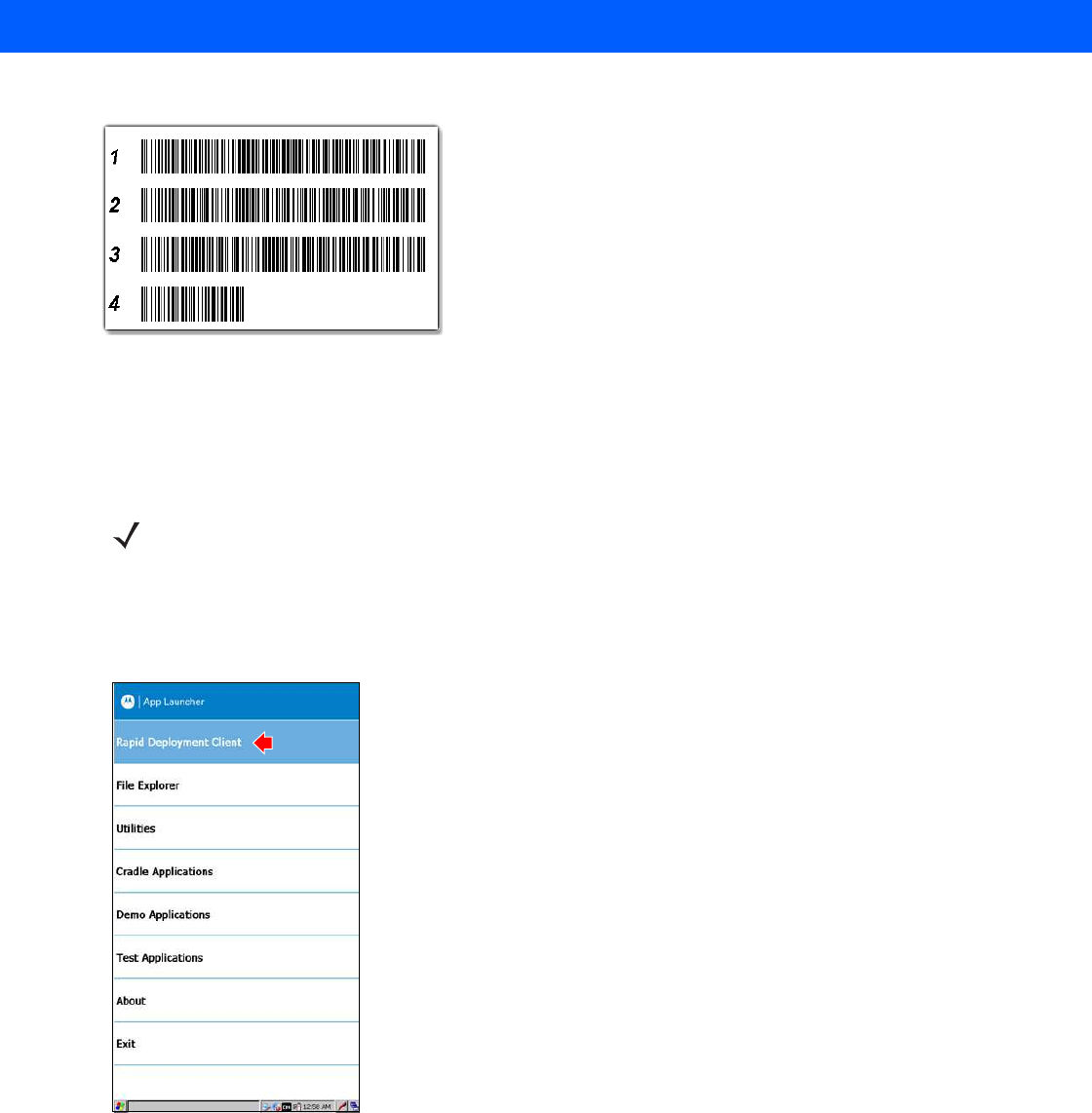
2 - 2 MC18 Product Reference Guide
Figure 2-1
RD Bar Code Printout Sample
Bar Code Staging
When the MC18 boots for the first time (or after a cold boot) the App Launcher window appears. The RD Client
option is highlighted.
Use this procedure to set bar code:
1. Obtain the appropriate RD bar code sheet from the MSP Administrator.
2. On the App Launcher screen, click Rapid Deployment Client.
3. Result: The Scan Barcodes To Deploy window displays.
NOTE If the App Launcher screen does not display see your administrator.
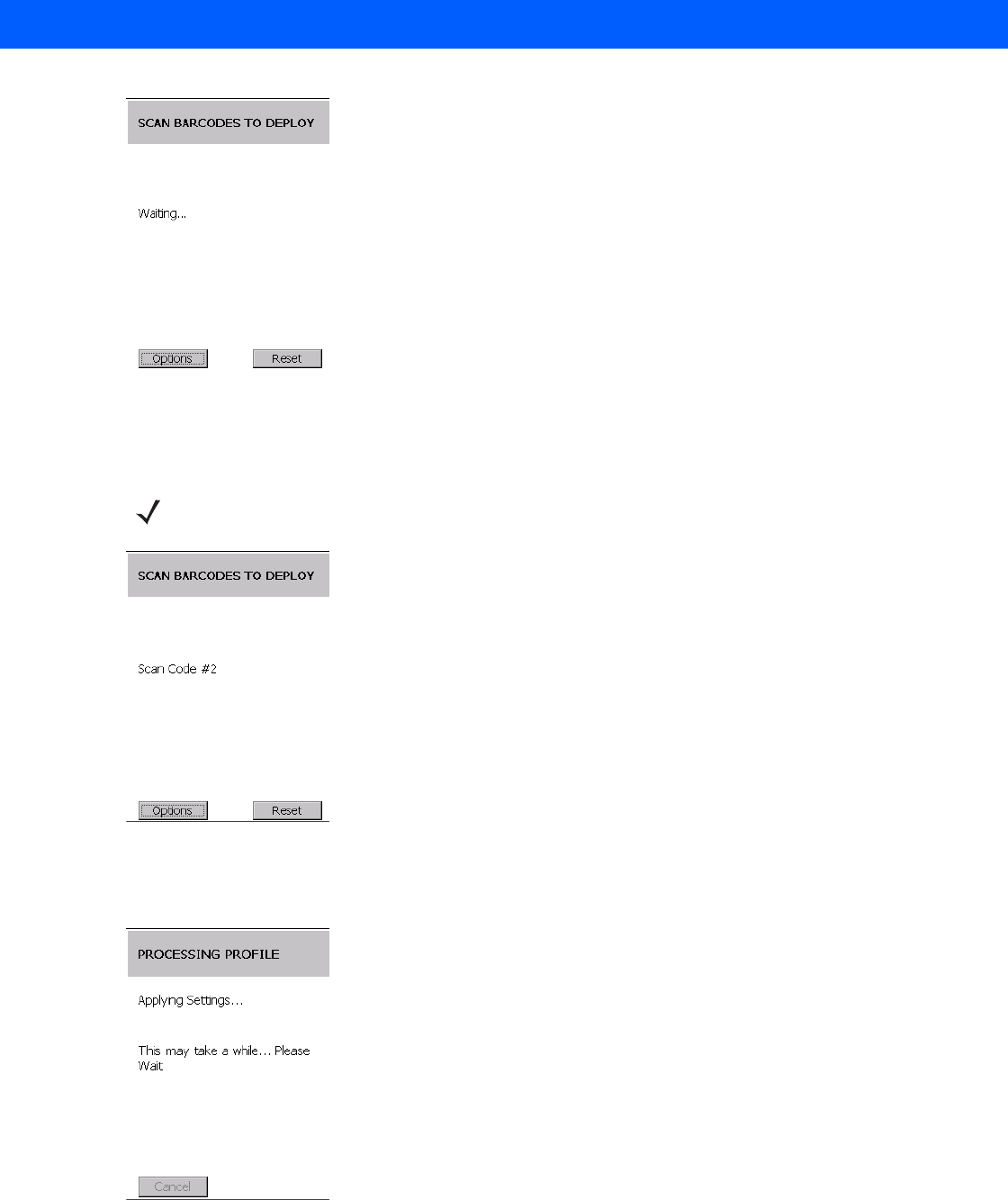
Staging and Provisioning 2 - 3
Figure 2-2
Scan Barcodes To Deploy window
The RD Client waits for the first bar code scan.
4. Scan the first bar code. The window indicates which bar code to scan next.
Figure 2-3
Rapid Deployment Window - Scanning Bar Codes
5. After all the bar codes are scanned successfully, the MC18 connects to the server and the PROCESSING
PROFILE window displays while network settings are configured.
Figure 2-4
Rapid Deployment Window - Processing Profile
NOTE Multi-part linear bar codes (1-D bar codes) can require scanning several bar codes. Bar codes can be
scanned in any order. The display indicate the bar code to scan.
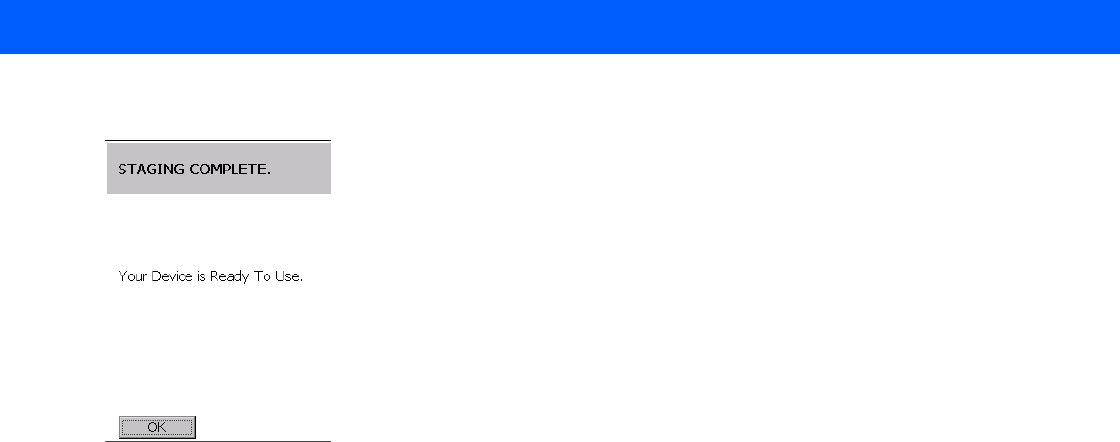
2 - 4 MC18 Product Reference Guide
6. When staging is complete the STAGING COMPLETE window displays.
Figure 2-5
Staging Complete Window
7. Use Options > Exit button in RD client application to exit.
On-Demand Staging
The MSP 3.0 RD Client also enables staging without having to scan bar codes through the use of On-Demand
Staging (Electronic Staging).
When using On-Demand Staging, the RD Client pulls staging profiles directly from an On-Demand Profile
Server over some form of pre-configured or automatically-configured IP connection. The following types of IP
connection modes are currently supported for Electronic Staging:
ActiveSync Connection Mode
This mode uses the IP connection that is established when the MC18 is directly connected (via a USB cable,
serial cable or cradle) to a host computer running ActiveSync. The most common scenario would be where the
On-Demand Profile Server is running on the host computer to which the MC18 is connected via ActiveSync. It
would, however, also work with the On-Demand Profile Server running on any other host computer that is on
the same subnet as the host computer to which the MC18 is connected via ActiveSync.
Already existing IP Connection Mode
This mode uses any IP connection that is already active on the MC18. This could be a direct Ethernet port (if
available), or a WLAN connection that was configured and established before the RD Client was launched. It
could also be any other form of IP connection that might be available on the MC18. The RD Client does not do
anything to configure or establish such connections, but uses them if they exist. The On-Demand Profile
Server must be running on a host computer that is on the same subnet that is accessible from the connection.
Well-known WLAN Connection Mode
This mode works only on supported Symbol Technologies WLAN adapters. The RD Client attempts to
configure and establish WLAN IP connections using pre-defined Symbol Technologies WLAN settings. If the
RD Client is able to successfully configure and establish such a connection, and if an On-Demand Profile
Server is running on a host computer that is on the same subnet that is accessible from the connection, then
Electronic Staging proceeds using that connection.
Use this procedure to perform On-Demand Staging:
1. In the App Launcher menu, launch the RD Client. The Scan Barcodes To Deploy window displays.
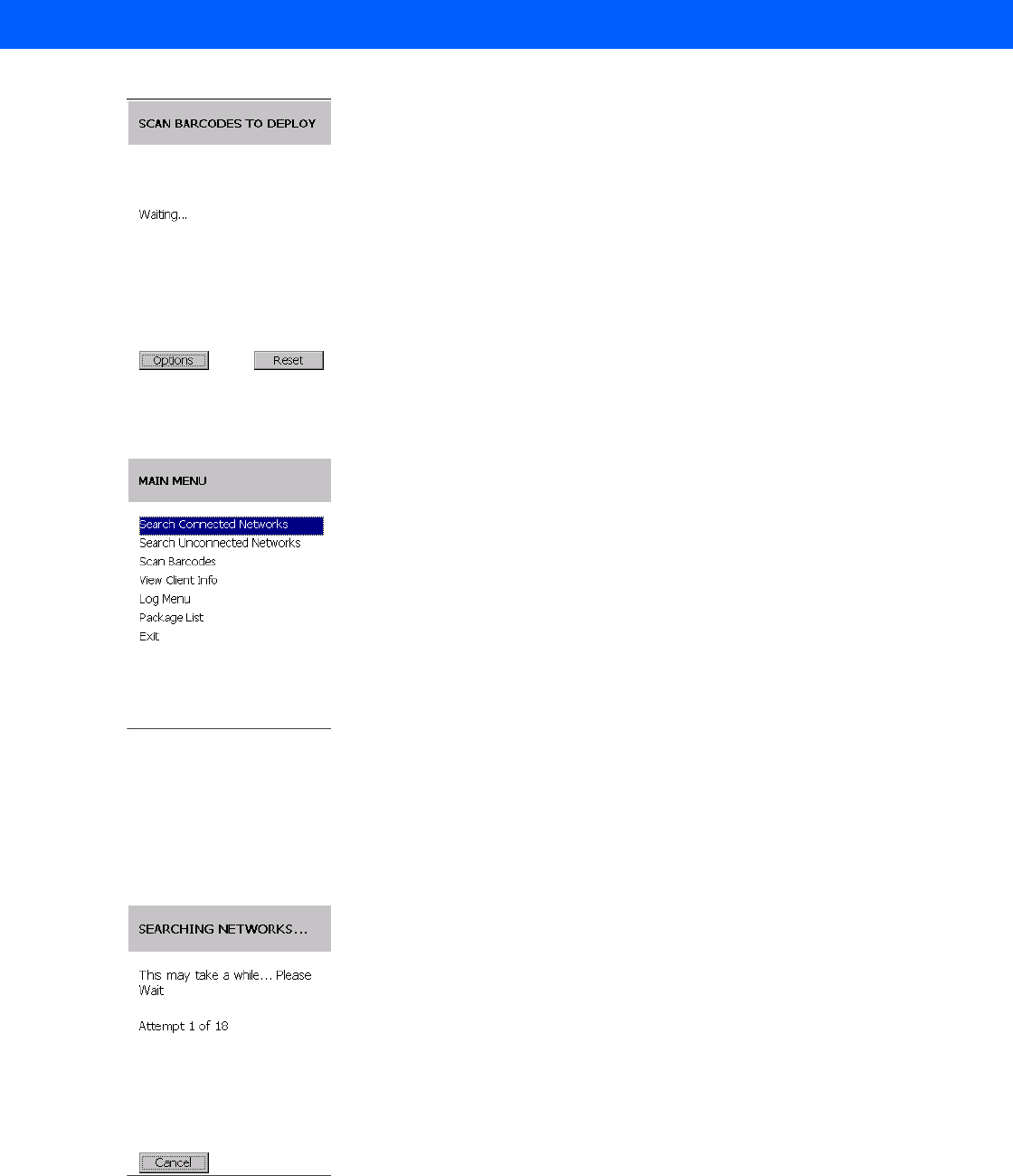
Staging and Provisioning 2 - 5
Figure 2-6
Waiting for Bar Codes
2. Use Options > Exit button in RD client application to exit. The Main Menu window appears.
Figure 2-7
RD Client Main Menu
3. Select Search Connected Networks or Search Unconnected Networks. The SEARCHING NETWORKS
window appears.
Connected networks are networks that are already connected and can be checked to see if a Staging
Server can be found. Unconnected Networks are the well-known WLAN connections that are automatically
configured and established to see if a Staging Server can be found.
Figure 2-8
RD Client Searching for On-Demand Profile Server
4. When complete, the STAGING COMPLETE window displays.
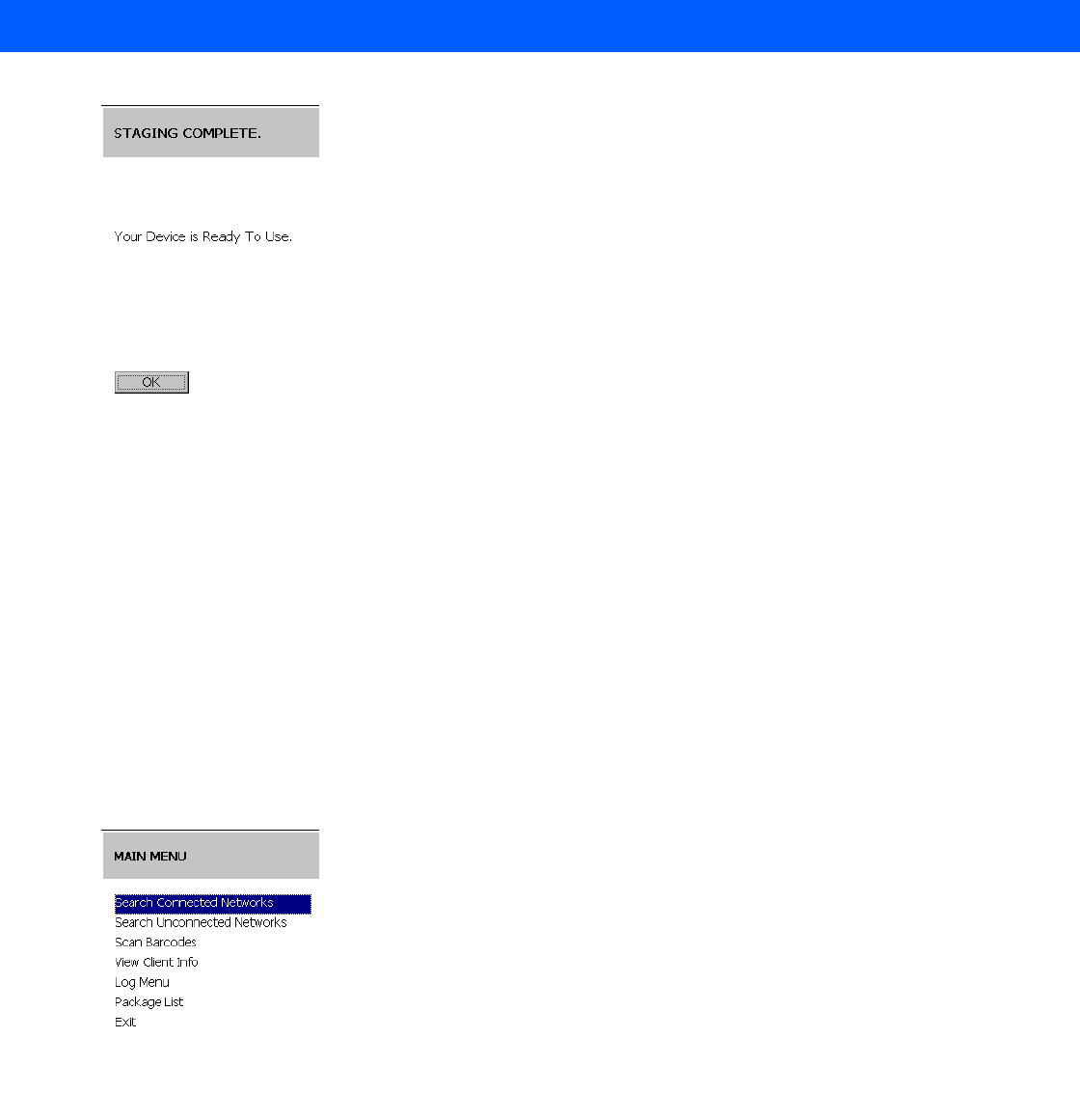
2 - 6 MC18 Product Reference Guide
Figure 2-9
Staging Complete Window
Use Options > Exit button in RD client application to exit.
RD Client Main Menu
The RD Client Main Menu contains the following options:
•
Search Connected Networks. See On-Demand Staging on page 2-4 for detailed information.
•
Search Unconnected Networks. See On-Demand Staging on page 2-4 for detailed information.
•
Scan Barcodes See Bar Code Staging on page 2-2 for detailed information.
•
View Client Info
•
Log Menu
•
Package List
•
Exit - Closes the RD Client application.
Figure 2-10
RD Client Main Menu
Client Info
Use the Client Info window to view the following information:
•
RD Client version
•
Product name
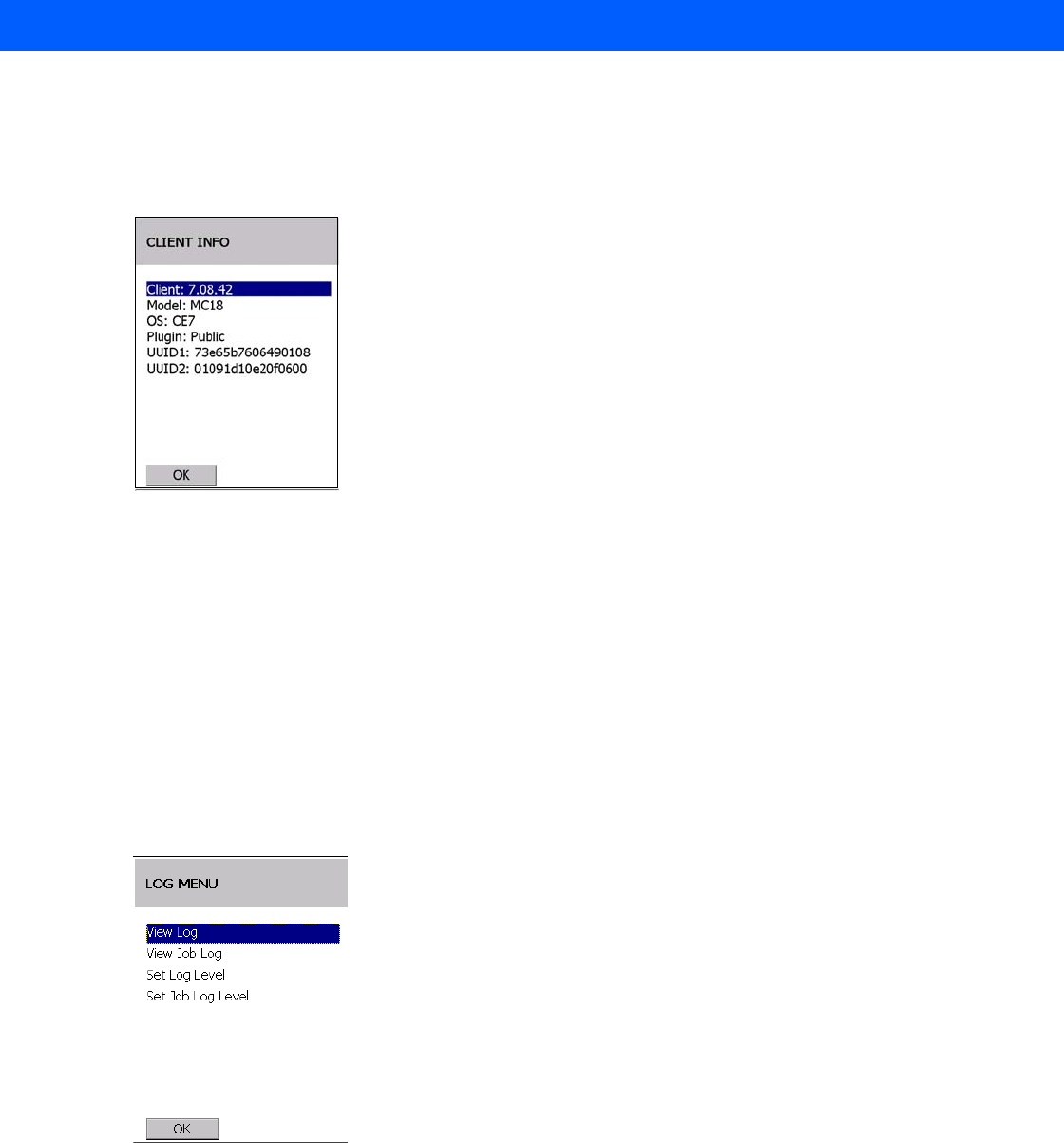
Staging and Provisioning 2 - 7
•
Operating system type
•
Plug-in type.
Select View Client Info option.
Figure 2-11
Client Info Window
Press the OK to return to the Main Menu.
Log Menu
The Log Menu contains the following options:
•
View Log
•
View Job Log
•
Set Log Level
•
Set Job Log Level.
Select Log Menu option.
Figure 2-12
Log Menu Window
Press OK to return to the Main Menu.
View Log
Use the View Log option to display a list of events that have occurred.
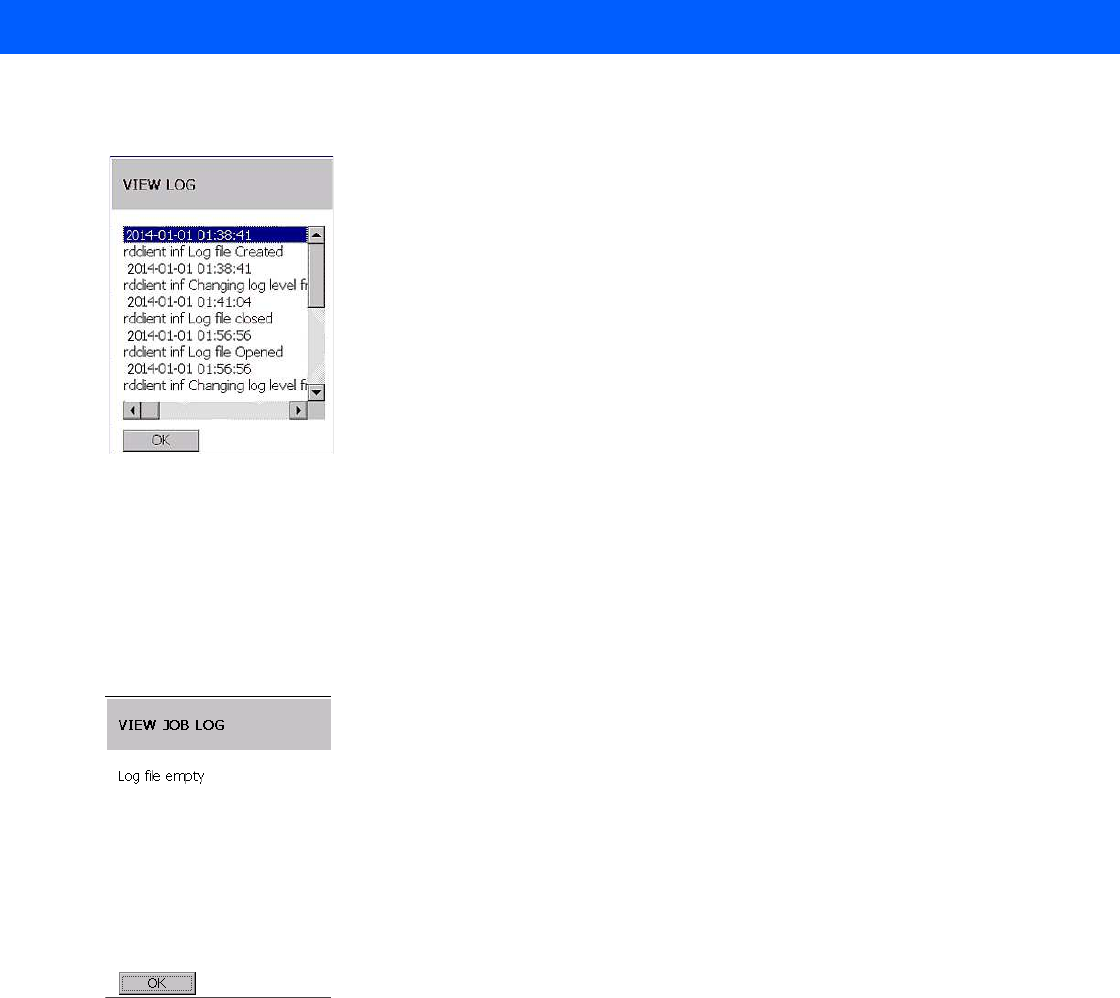
2 - 8 MC18 Product Reference Guide
Select View Log option.
Figure 2-13
View Log Window
Return to the Log Menu.
View Job Log
Use the View Job Log option to display a list of jobs that have be processed.
Select View Job Log option.
Figure 2-14
View Job Log Window
Return to the Log Menu.
Set Log Level
Use the Set Log Level option to set the level of the information that appears in the log.
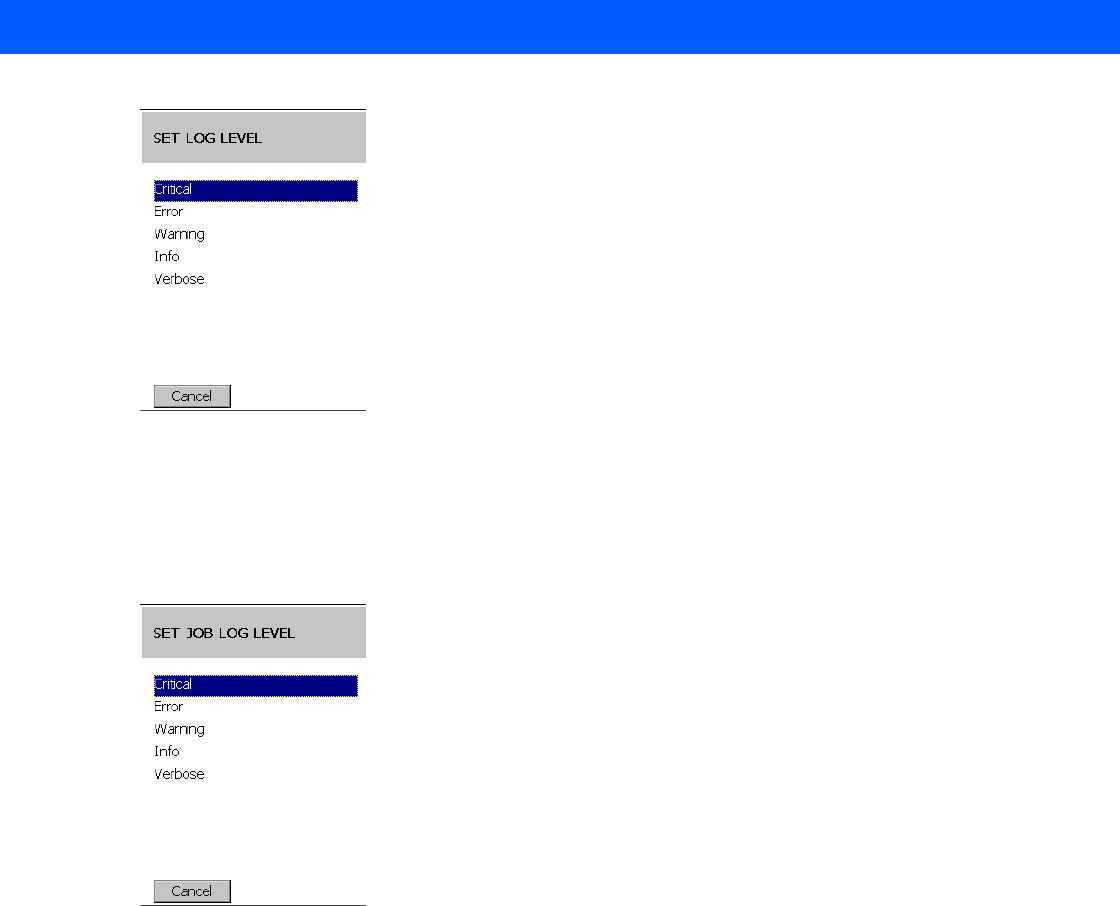
Staging and Provisioning 2 - 9
Figure 2-15
Set Log Level Window
Select a level option.
Set Job Log Level
Use the Set Job Log Level option to set the level of the information that appears in the Job log.
Figure 2-16
Set Job Log Level Window
Select a level option.
Package List
Use the Package List option to display the packages that have been installed on the MC18.
Select the Package List option.
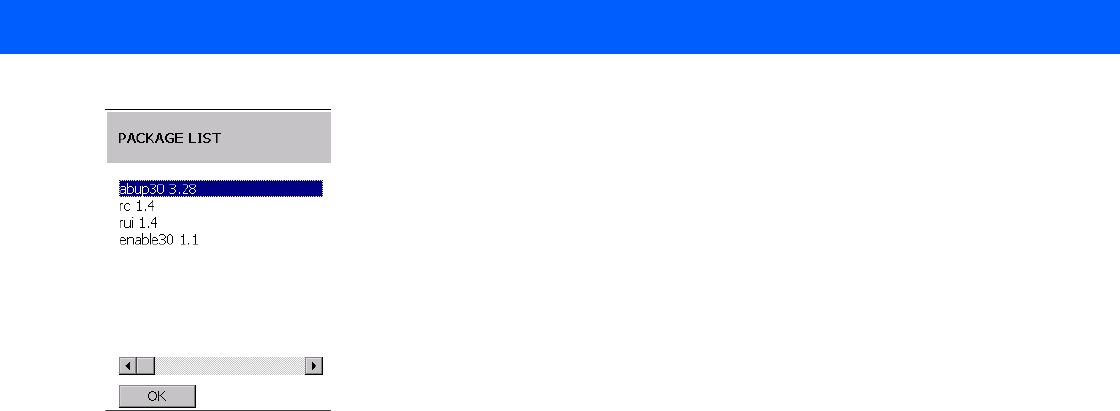
2 - 10 MC18 Product Reference Guide
Figure 2-17
Package List Window
Return to the Main Menu.
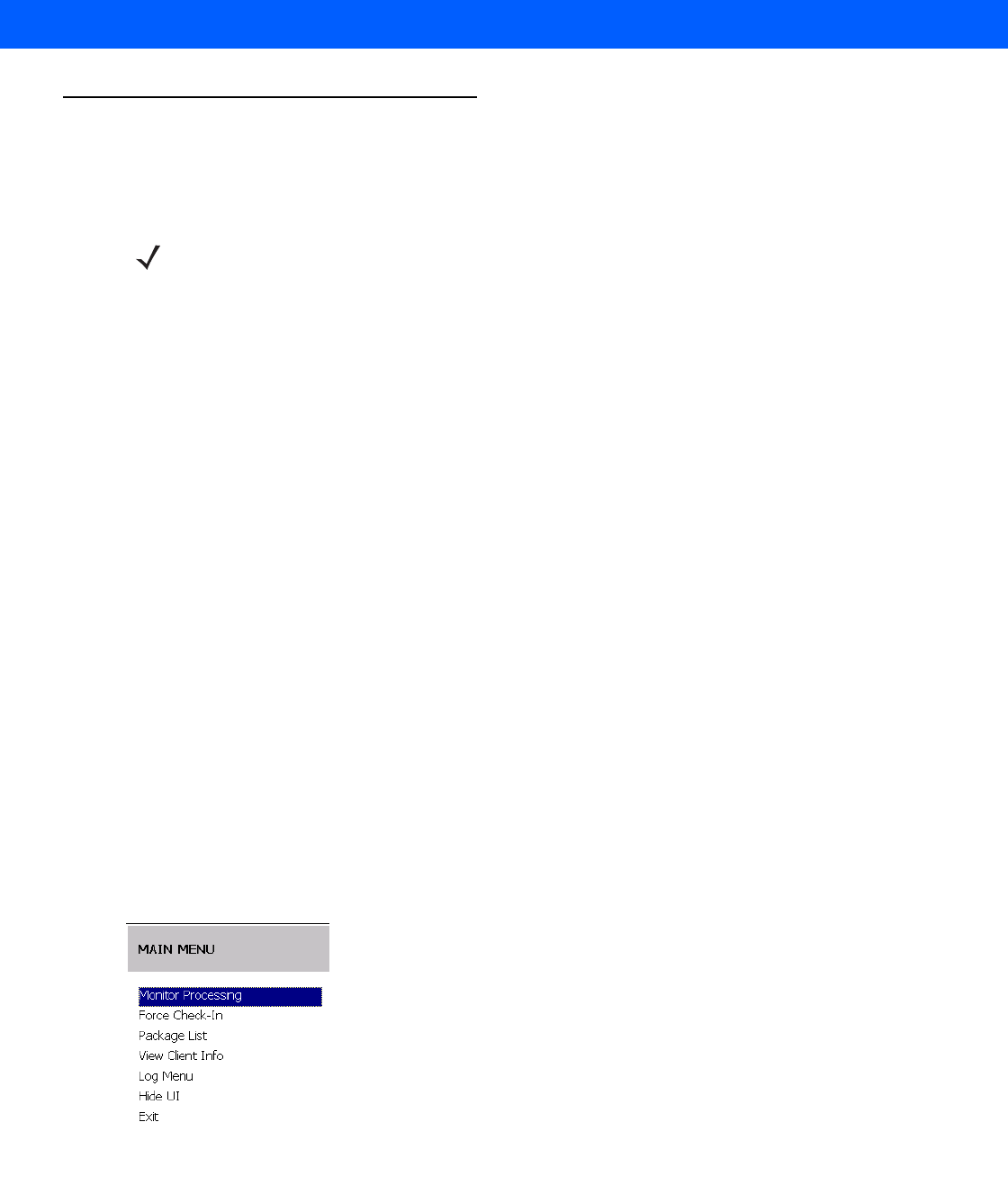
Staging and Provisioning 2 - 11
Provisioning
Provisioning is the process of installing software packages onto the MC18 mobile computers.
MSP Agent
The Provisioning Client is responsible for implementing device-side provisioning activities as defined by a
policy. A policy is evaluated on the MSP 3.X system and delivered to mobile computers as job documents via
relay servers.
The MSP 3.X Provisioning Client is 100% backward compatible to prior versions of the AirBEAM Client.
Existing AirBEAM Smart users can use the MSP 3.X Provisioning Client as a 100% backward compatible
replacement for prior versions of AirBEAM Client, when used in classic AirBEAM mode with existing FTP
servers.
Existing MSP 2.X users can use the new Provisioning Client as a 100% backward compatible replacement for
previous versions of AirBEAM Client, when used in Level 2 Agent and Level 3 Agent modes with existing MSP
2.X Appliances.
For more detailed information on MSP Agent (Provisioning Client), refer to the MSP 3.X User's Guide (p/n
72E-100158-xx).
MSP Agent Main Menu
The MSP Agent Main Menu contains the following options:
•
Monitoring Processing
•
Force Check-In
•
Package List
•
View Client info
•
Log Menu
•
Hide UI
•
Exit - exits the MSP Agent application.
Figure 2-18
MSP Agent Main Menu
NOTE MSP Agent is also known as MSP 3.X Provisioning Client.
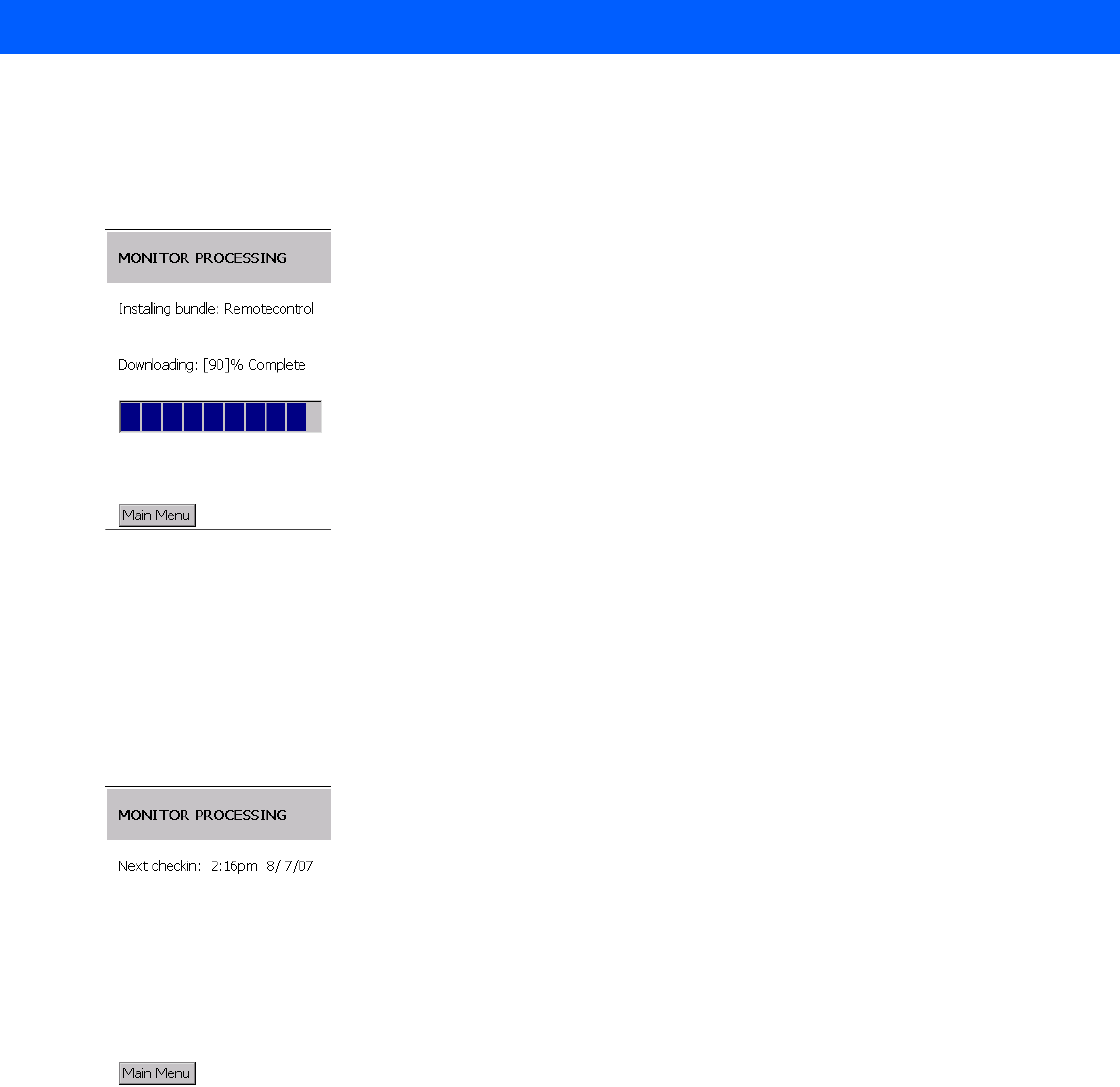
2 - 12 MC18 Product Reference Guide
Monitor Processing
Use the Monitor Processing option to view the status of packages being processed.
Select the Monitor Processing option.
Figure 2-19
Monitor Processing Window
Press Main Menu to return to the Main Menu.
Force Check-In
Use the Force Check-In option to check instantly for pending package downloads instead of waiting for the next
automatic check that the client performs.
Select the Force Check-In option.
Figure 2-20
Force Check-in Window
Press Main Menu to return to the Main Menu.
Package List
Use the Package List option to display the packages that have been installed on the MC18.
Select the Package List option.
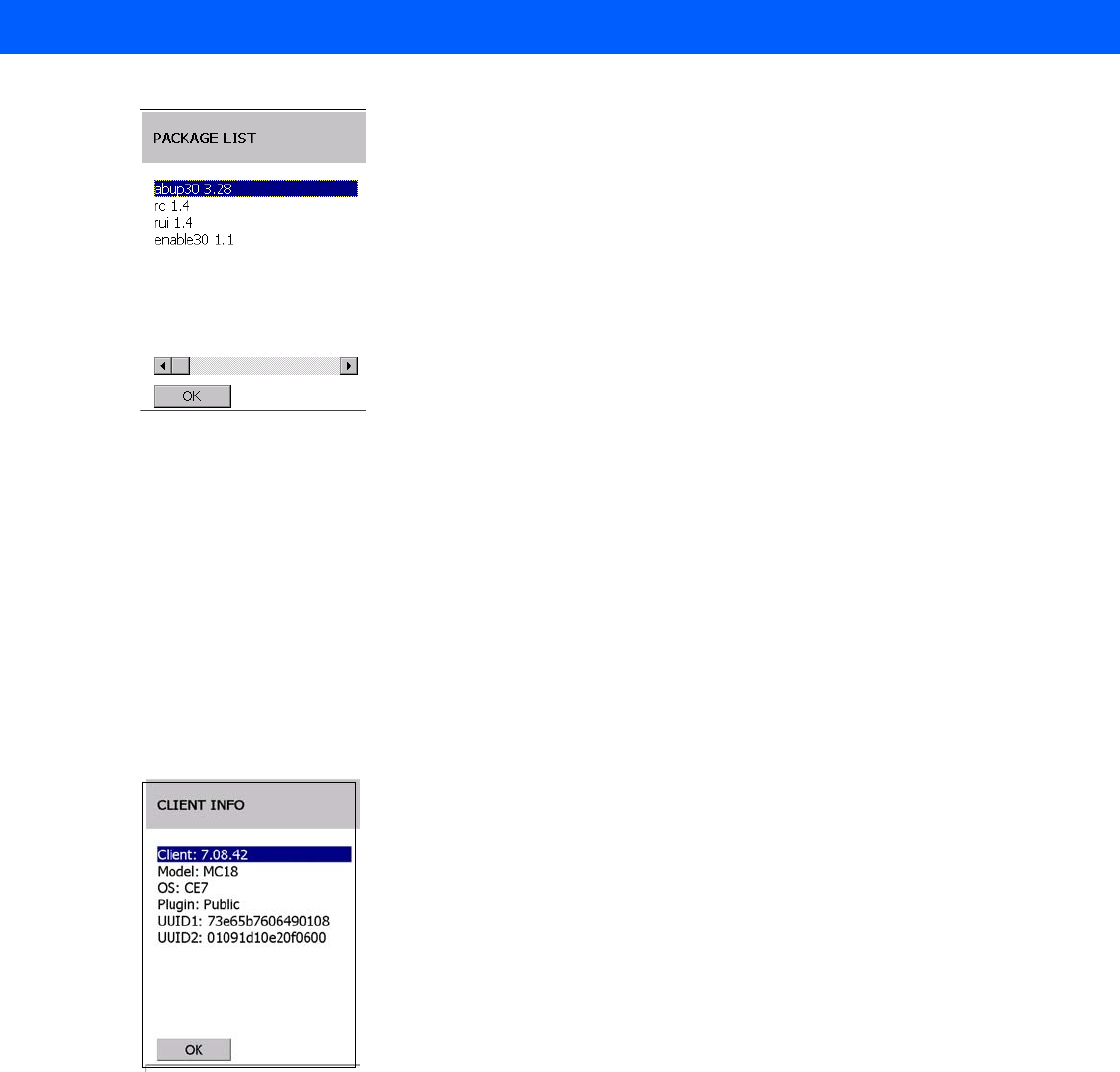
Staging and Provisioning 2 - 13
Figure 2-21
Package List Window
Press OK to return to the Main Menu.
Client Info
Use the Client Info window to view the following information:
•
RD Client version
•
Product name
•
Operating system type
•
Plug-in type.
Select View Client Info option.
Figure 2-22
Client Info Window
Press OK to return to the Main Menu.
Log Menu
The Log Menu contains the following options:
•
View Log
•
View Job Log
•
Set Log Level
•
Set Job Log Level.
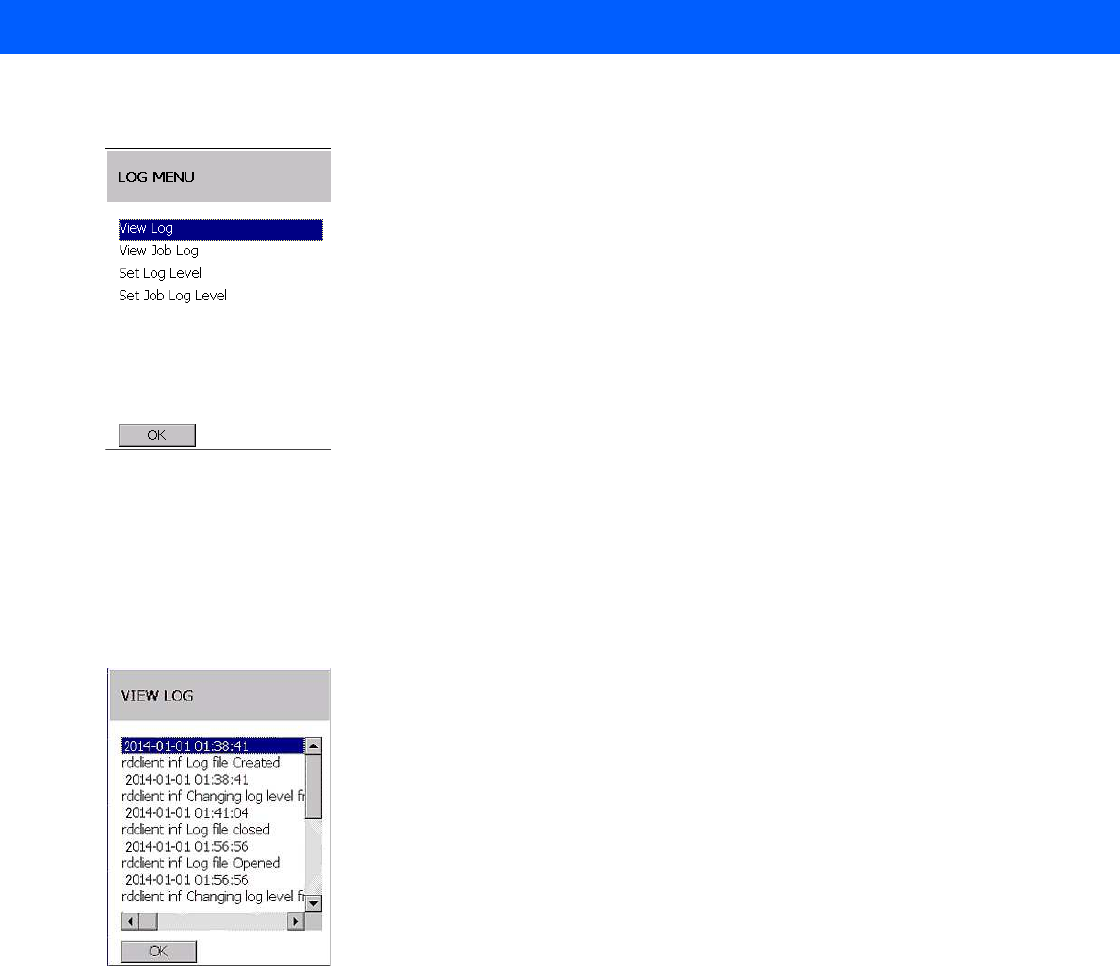
2 - 14 MC18 Product Reference Guide
Select Log Menu option.
Figure 2-23
Log Menu Window
Press OK to return to the Main Menu.
View Log
Use the View Log option to display a list of events that have occurred.
Select View Log option.
Figure 2-24
View Log Window
Press OK to return to the Log Menu.
View Job Log
Use the View Job Log option to display a list of jobs that have be processed.
Select View Job Log option.
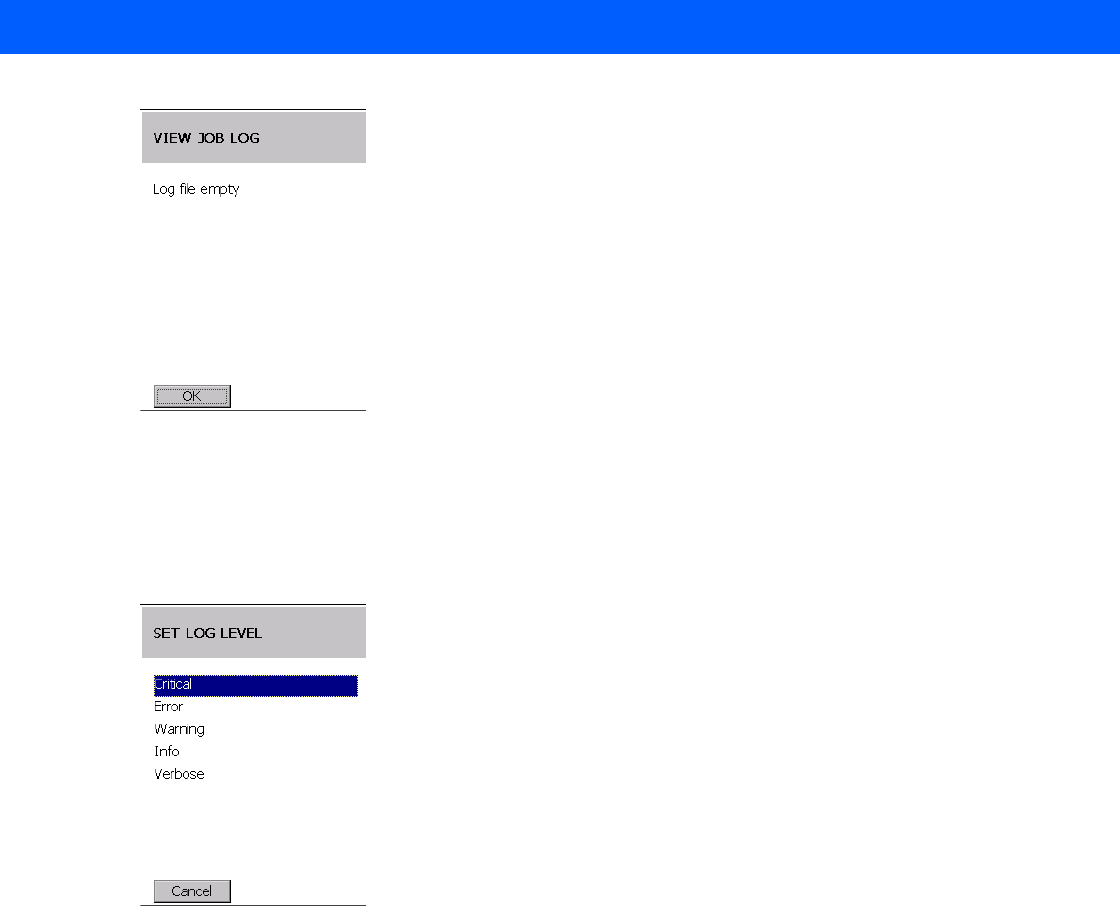
Staging and Provisioning 2 - 15
Figure 2-25
View Job Log Window
Press OK to return to the Log Menu.
Set Log Level
Use the Set Log Level option to set the level of the information that appears in the log.
Figure 2-26
Set Log Level Window
Select a level option.
Set Job Log Level
Use the Set Job Log Level option to set the level of the information that appears in the Job log.
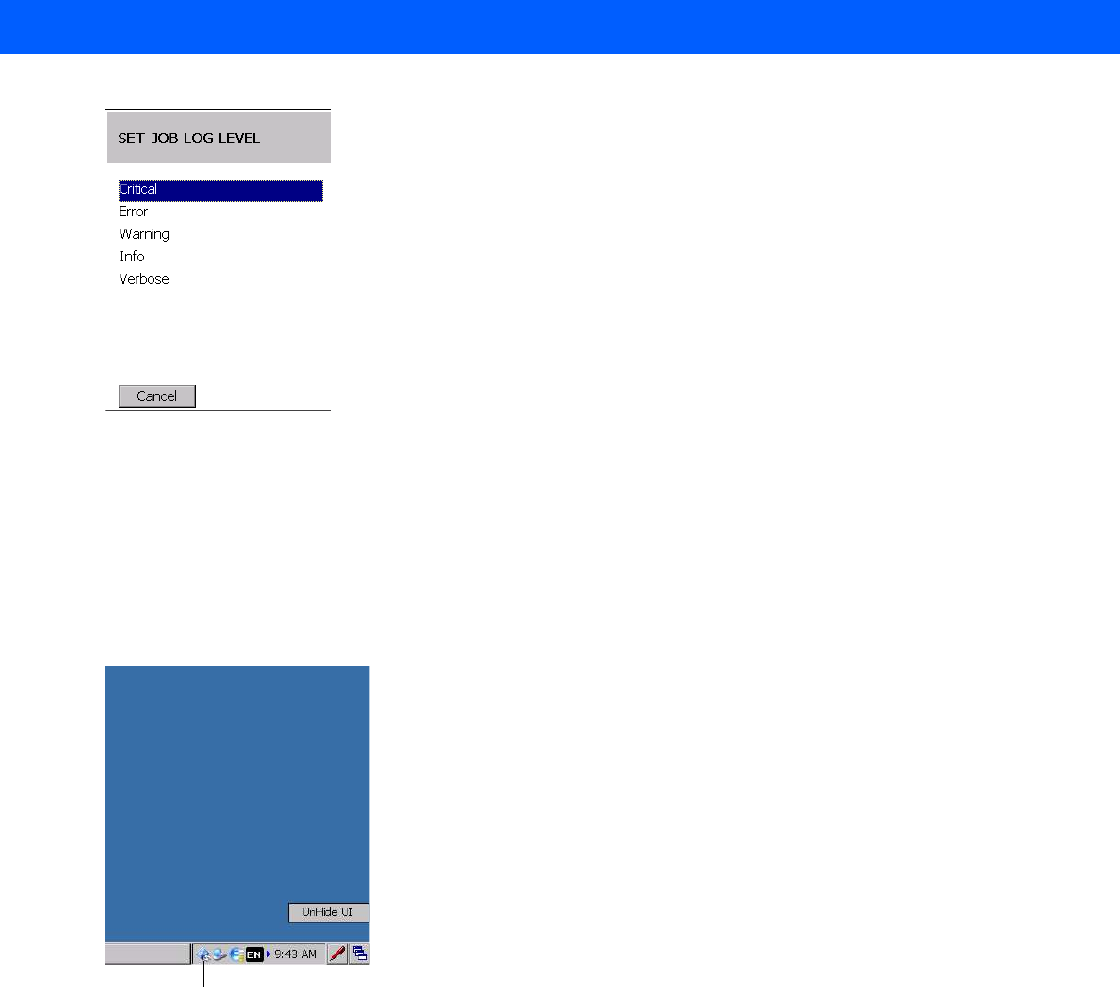
2 - 16 MC18 Product Reference Guide
Figure 2-27
Set Job Log Level Window
Select a level option.
Hide UI
Use the Hide UI option to minimize the MSP Agent application. The MSP Agent application runs in the
background while minimized.
To un-hide the application, select the MSP Agent icon in the task tray and select the UnHide UI menu item.
Figure 2-28
UnHide UI Selection
MSP Agent Icon

CHAPTER 3 WIRELESS APPLICATIONS
Introduction
Wireless Local Area Networks (WLANs) allow the MC18 mobile computers to communicate wirelessly and
send captured data to a host device in real time. The MC18 supports the 802.11a, 802.11b, 802.11g and
802.11n standards. Before using the MC18 on a WLAN, the facility must be set up with the required hardware
to run the wireless LAN and the MC18 must be configured. Refer to the documentation provided with the
access points (APs) for instructions on setting up the hardware.
To configure the radio in the MC18, use the Fusion APIs in the Enterprise Mobility Developer’s Kit (EMDK).
Refer to the EMDK Help file for detailed information.
The MC18 contain the Wireless Applications to allow configuration of the WLAN radio. On the MC18, use the
touch screen to access the Wireless Application. MC18 requires the use of remote control software. See
Chapter 4, Sync with Host Computer for more information.
802.11d Overview
IEEE 802.11d, is an amendment to the IEEE 802.11 specification that adds support for additional regulatory
domains. This includes additional country information to beacons, probe requests, and probe responses. The
country information simplifies the creation of 802.11 wireless access points (APs) and clients that meet the
different regulations enforced in various parts of the world.
Fusion fully supports 802.11d for Regulatory purposes. By using 802.11d, the MC18 can easily connect to a
wireless network and use only the valid channels for the country specified in the AP's beacons. By default, the
MC18 software enables 802.11d mode to determine regulatory requirements.
Configuring My Country for Use with WLAN on the MC18
Configuration can be done on:
•
an enabled 802.11d network
•
a disabled 802.11d network.

3 - 2 MC18 Product Reference Guide
Enabled 802.11d Network
There is no need to configure a country if 802.11d is used by the Access Point (AP). Verify that the wireless
network infrastructure has 802.11d enabled.
Use this procedure to connect to a network with 802.11d enabled:
1. Use Mobility Services Platform (MSP) to generate bar codes that contain a Fusion wireless network profile
for use with Rapid Deployment (RD). This profile should match the network that is being connected to (a
properly configured ESSID).
2. On the MC18, use RD to scan the MSP Fusion Profile bar codes.
3. RD imports the Fusion Profile into the Fusion Database and attempts to connect to the network configured
in the profile. Fusion uses the country code information provided in the AP's beacon (802.11d) to
determine the regulatory requirements and connect to the network using a valid WLAN channel.
Disabled 802.11d Network
If the network does not have 802.11d enabled, it is necessary to create:
A Fusion Options gpdexport file on another device, running Fusion X2.00 or above o a new staging network
dedicated to the transition from 802.11d to using a specific country code.
This staging network needs to have 802.11d enabled. This staging network could be as simple as an AP
connected to a host computer and multiple MC18s. A separate non-MC18 Fusion based device (MC67,
MC92N0, VC70, etc.) is needed to create the Fusion Options gpdexport file.
Create Fusion Options gpdexport File
To export a the Fusion Options to a gpdexport file that contains the proper settings for the network, perform the
following steps:
1. Obtain another device that has Fusion applications on it. This device should have Fusion X2.00 or later
version on it.
2. On this device, tap the Wireless icon in the system tray and select Options from the menu. The Options
window appears.
3. In the Options drop-down list, select Regulatory.
a. In the Settings drop-down list, select the country code to use.
b. Un-check the Enable 802.11d checkbox.
c. Tap S a ve .
4. In the Options drop-down list, select Import/Export.
a. Tap the Export Options button. The Export File Wizard window appears.
b. Select Fusion Options and Overwrite conflicting records checkboxes. Uncheck all other checkboxes
and tap on Export to file button.
c. The Save As window appears.
d. Save the Fusion Options gpdexport file to the device (name the file as desired).
5. Tap X to close the Options window.
6. Using a Sync application, copy the Fusion Options gpdexport file to a host computer. This file will be
downloaded to configure MC18 devices with the correct country and 802.11d mode.

Wireless Applications 3 - 3
Update MC18 via 802.11d Enabled Staging Network
Use the staging network to configure all devices with the correct country code and 802.11d mode:
1. Configure RD to download packages from a FTP server that is accessible from the staging network. This
may require MSP bar codes, etc.
2. The Out of Box magic profile for the MC18 devices automatically attempts to connect to a wireless network
with an ESSID of "101". This should be the same ESSID of the staging network.
3. Place the Fusion Options gpdexport file (created using the alternate Fusion based device), on the staging
network's FTP server.
4. The MC18 should download the Fusion Options gpdexport file from the staging network to and configure
802.11d mode and the country code.
5. The MC18 should perform a cold boot so that the new configuration takes effect.
Connect to the Non-802.11d Network
Since the MC18 is now setup to not use 802.11d and is configured with the correct country code for the
network, the normal RD procedure should be used from this point forward.
Wireless Application on the MC18
To configure the MC18, a set of wireless applications provide the user with the tools to configure and test the
wireless radio embedded the MC18. The following wireless applications are available on the task tray from the
Wireless Application menu:
•
Wireless Status
•
Wireless Diagnostics
•
Find WLANs
•
Manage Profiles
•
Options
•
Log On/Off
•
Enable/Disable Radio.
Refer to the Wireless Fusion Enterprise Mobility Suite User Guide for Version X.XX, for information on
configuring wireless profiles, where X.XX indicates the Fusion version. To determine the Fusion version see
Fusion Software on page xii.
By default, the task tray is displayed below the screen. If the taskbar is set to be hidden, display the task tray by
placing your finger over the portion of the task tray that is visible (a thin gray line at the bottom of the screen).
The task tray automatically appears.
Touch the Signal Strength icon to display the Wireless Application menu.
NOTE The Windows CE 7.0 desktop may not be visible because the App Launcher application is active. To view
the desktop, close all running applications.
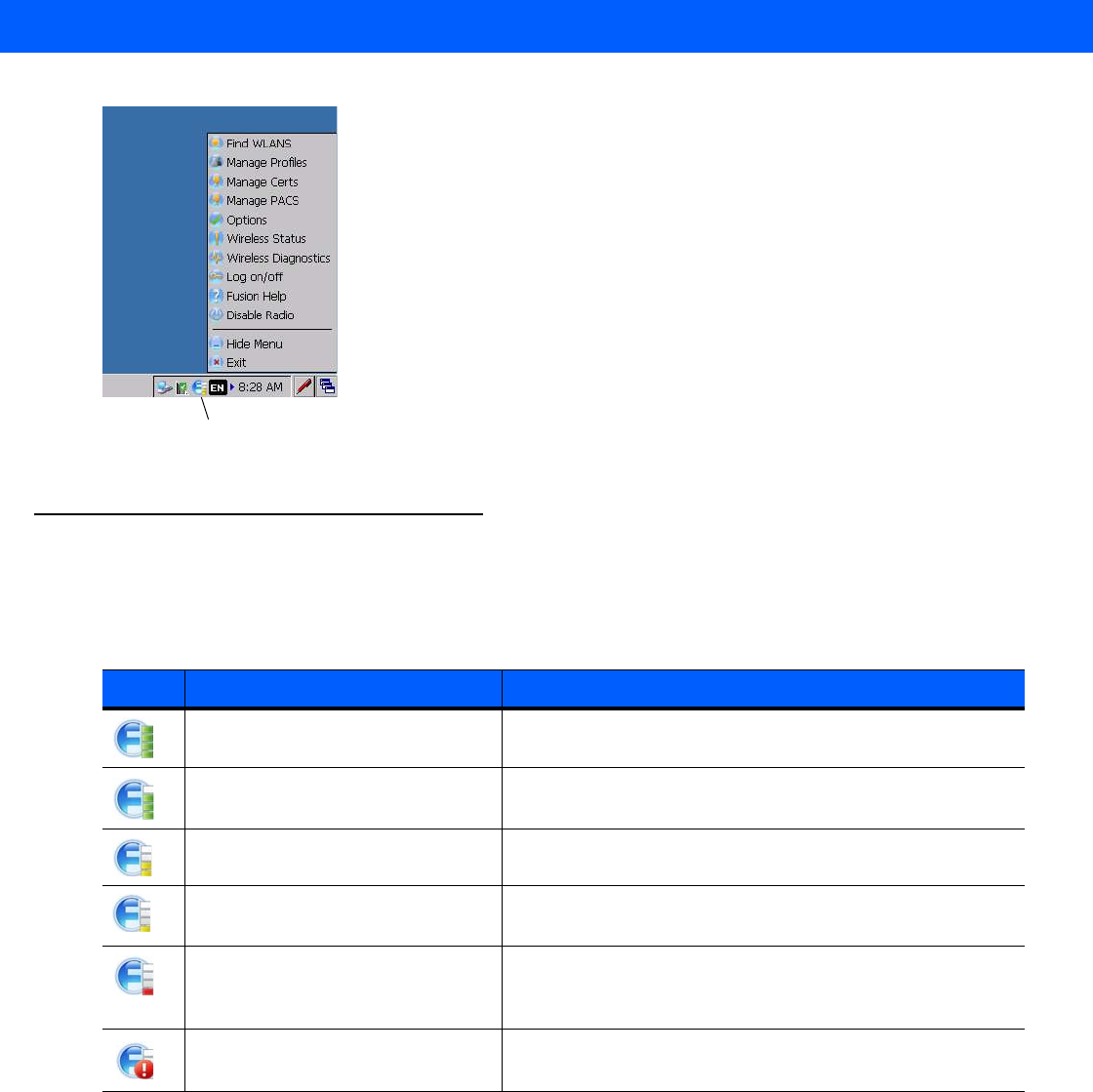
3 - 4 MC18 Product Reference Guide
Figure 3-1
Wireless Applications Menu
Signal Strength Icon
The Signal Strength icon in the task tray indicates the MC18 wireless signal strength as follows:
Signal Strength Icon
Table 3-1
Wireless Applications Icons, Signal Strength Descriptions
Icon Status Action
Excellent signal strength Wireless LAN network is ready to use.
Very good signal strength Wireless LAN network is ready to use.
Good signal strength Wireless LAN network is ready to use.
Fair signal strength Wireless LAN network is ready to use. Notify the network
administrator that the signal strength is only “Fair”.
Poor signal strength Wireless LAN network is ready to use. Performance may not
be optimum. Notify the network administrator that the signal
strength is “Poor”.
Out-of-network range (not
associated)
No wireless LAN network connection. Notify the network
administrator.
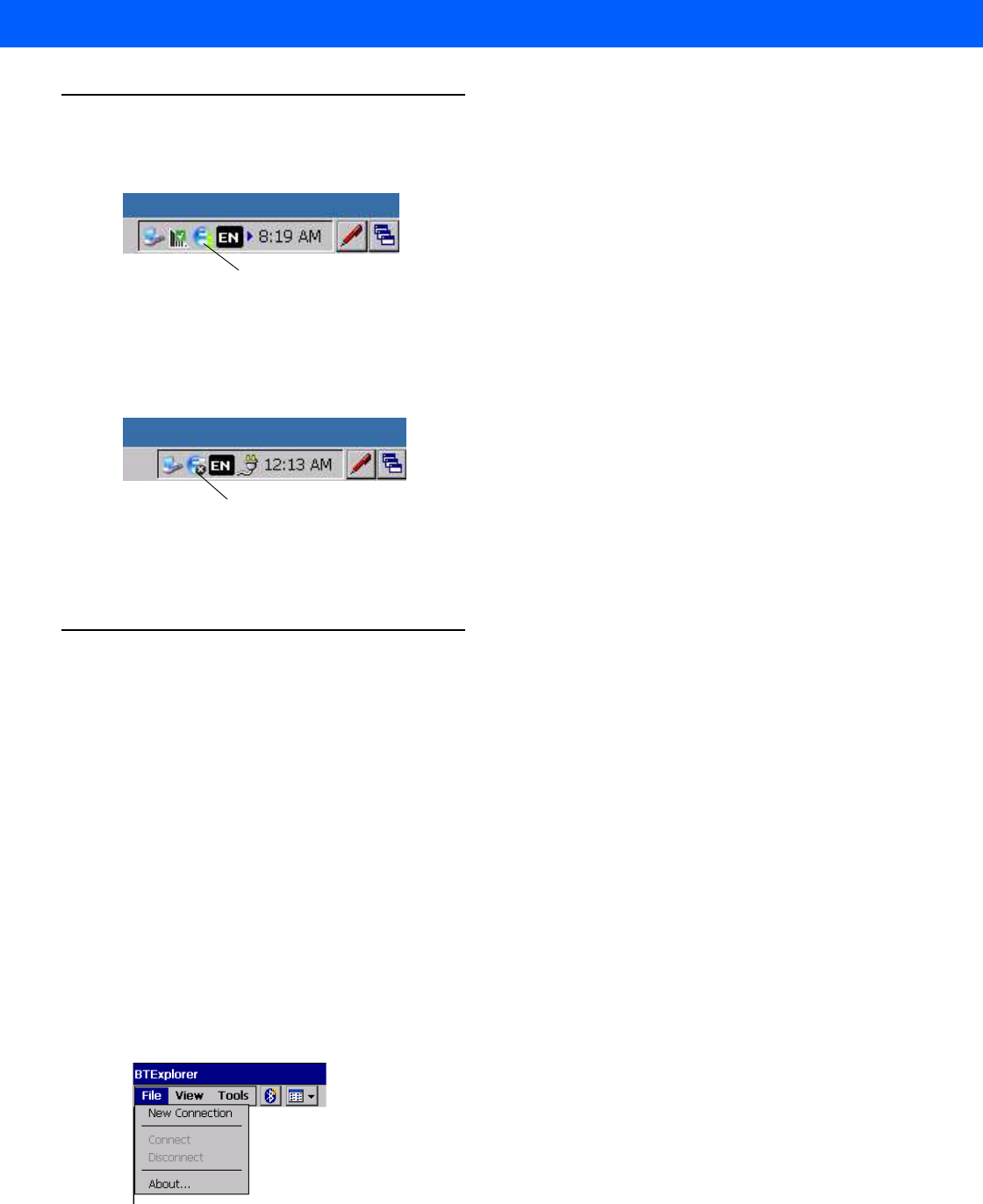
Wireless Applications 3 - 5
Turning Off the Radio
To turn off the WLAN radio click the Wireless Connection Status icon on the task tray and select Disable Radio.
Figure 3-2
Wireless Connection Status Icon - Radio On
A red i appears at the bottom of the icon indicating that the radio is disabled (off).
To turn the radio back on, click the Wireless Connection Status icon on the task tray and select Enable Radio.
Figure 3-3
Wireless Connection Status Icon - Radio On
The red X disappears from the icon indicating that the radio is enabled (on).
Bluetooth
Microsoft Bluetooth stack only for printing use case Version 2.1 with EDR compliance Maximum theoretical
bandwidth of 921.6Kbps.
The MC18 supports the following Bluetooth profiles:
•
Generic Access Profile - GAP
•
Service Discovery Access Profile - SDAP
•
Serial Port Profile – SPP
•
Wake on BT
Bluetooth Printing
Use this procedure to pair the MC18 to a Bluetooth printer:
1. Launch BT Explorer by clicking the BT Icon in notification area.
2. Click File -> New Connection.
Wireless Connection Status Icon
Wireless Connection Status Icon
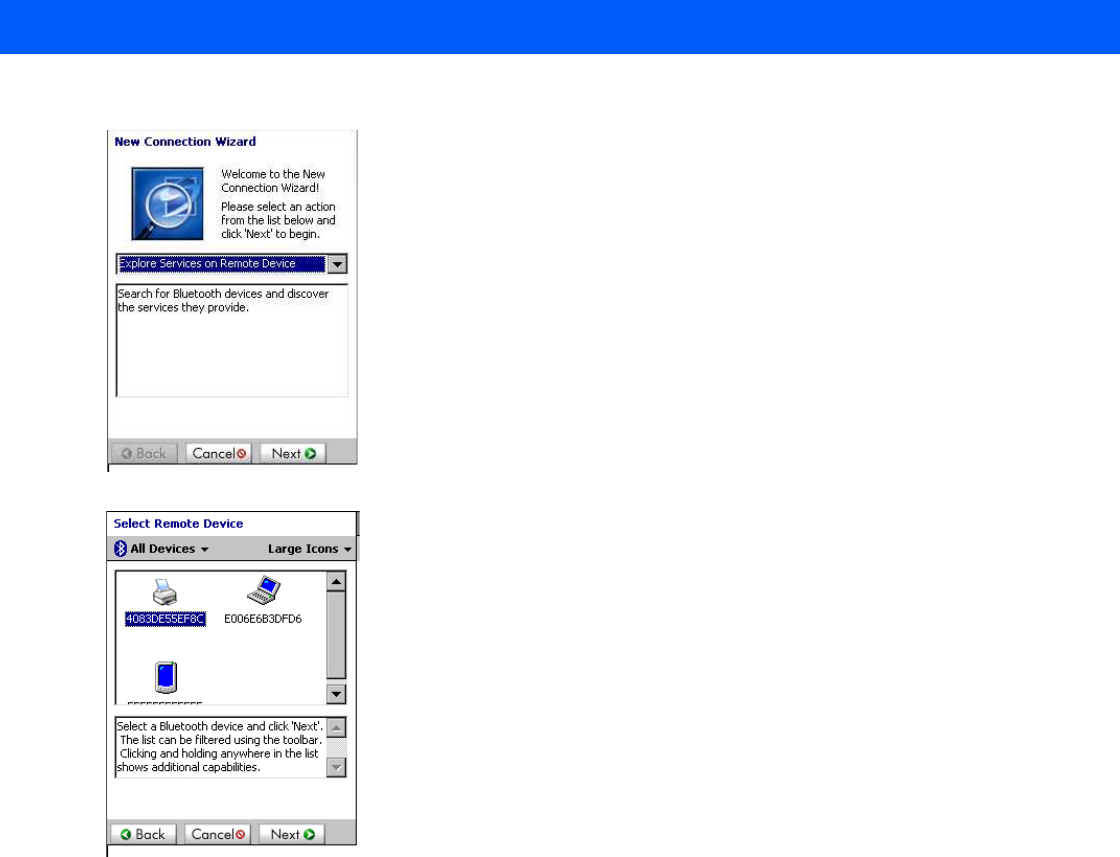
3 - 6 MC18 Product Reference Guide
3. Click Next on New Connection wizard to start device discovery.
4. Select the printer and choose next to start pairing process.
5. Enter the PIN. Once the printer is paired with MC18, services of printer are listed.
6. Choose serial printer service and connect.
7. Select the port MC18 to connect to printer.

CHAPTER 4 SYNC WITH HOST COMPUTER
To communicate with a host computer, the host computer requires a synchronization program. After
synchronizing the MC18 with a host computer, changes made on the MC18 or host computer appear in both
places.
To communicate with a host computer running Windows XP, install Microsoft ActiveSync (version 4.5 or
higher).
To communicate with a host computer running Windows 7, install Windows Mobile Device Center (WMDC
version 6.1 or higher).
Using a synchronization software:
•
Allows working with MC18-compatible host applications on the host computer. The synchronization
software replicates data from the MC18 so the host application can view, enter, and modify data on the
MC18.
•
Synchronizes files between the MC18 and host computer, converting the files to the correct format.
•
Backs up the data stored on the MC18. Synchronization is a one-step procedure that ensures the data is
always safe and up-to-date.
•
Copies (rather than synchronizes) files between the MC18 and host computer.
•
Controls when synchronization occurs by selecting a synchronization mode, e.g., set to synchronize
continually while the MC18 is connected to the host computer, or set to only synchronize on command.
•
Selects the types of information to synchronize and controls how much data is synchronized.
Installing the Synchronization Software
To install ActiveSync or Windows Mobile Device Center software on the host computer, logon to Microsoft web
site at http://www.microsoft.com. Refer to the installation instructions included with the software.
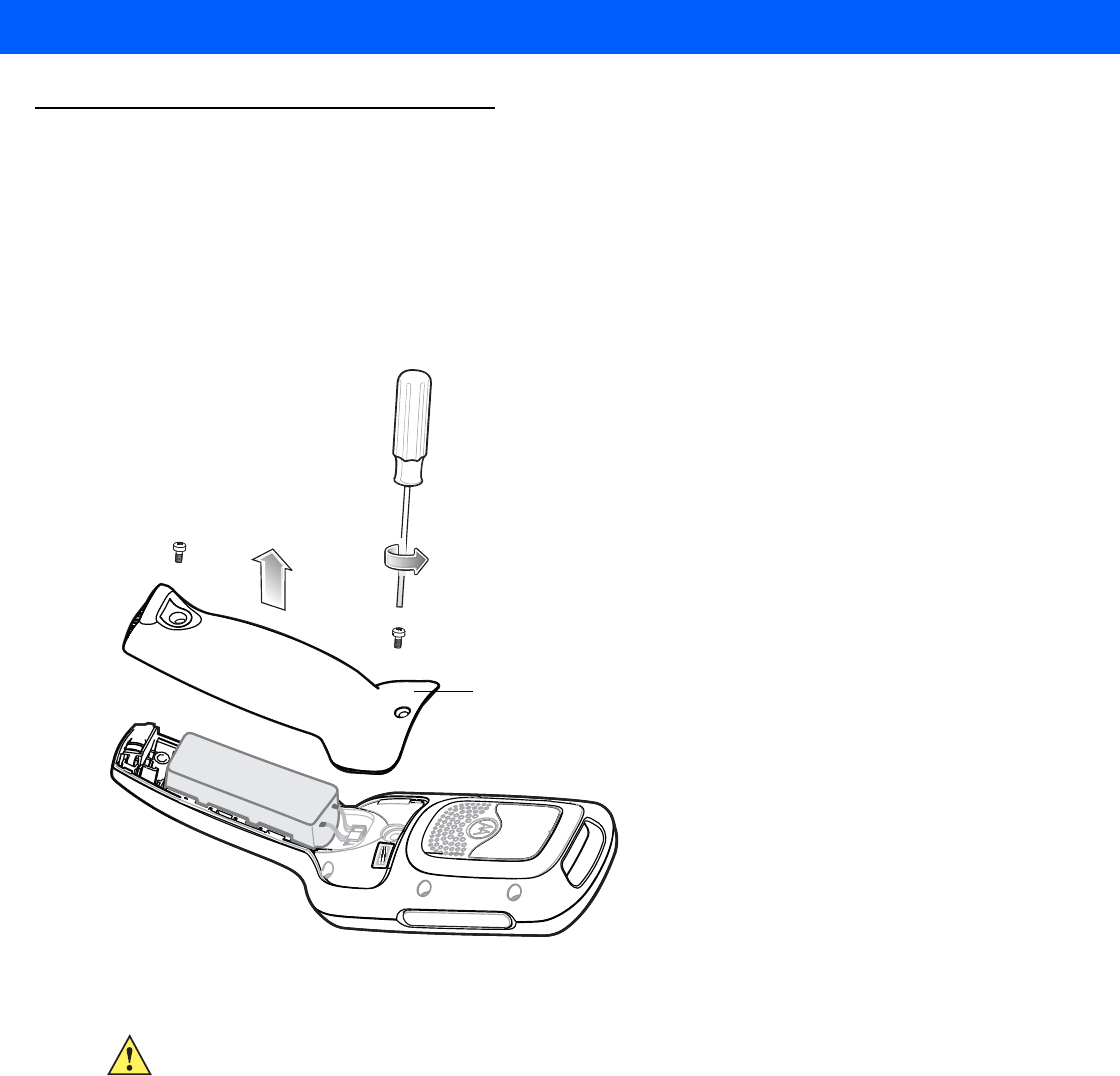
4 - 2 MC18 Product Reference Guide
Connecting the MC18 to a Host Computer
Perform this procedure to connect the MC18 to a host computer:
1. Ensure that synchronization program (ActiveSync for Windows XP or Windows Mobile Device Center for
Windows 7) is installed properly on the host computer.
2. Using a T8 Torx drive, remove the two Torx screws securing the battery cover to the back housing of the
MC18 (see Figure 4-1).
Figure 4-1
Remove Battery Cover
3. Align the connector on the programming cable panel with the sync connector on the MC18 and lower the
panel to fit on the MC18.
4. Hand-tighten the two T8 Torx screws securing the programming cable panel to the MC18.
Battery Cover
CAUTION Do not remove the battery cover while the MC18 is on and do not operate the MC18 with the battery
cover removed. Follow proper Electro-Static Discharge (ESD) precautions to avoid damaging the
MC18. Proper ESD precautions include, but are not limited to, working on an ESD mat and ensuring
that the operator is properly grounded.
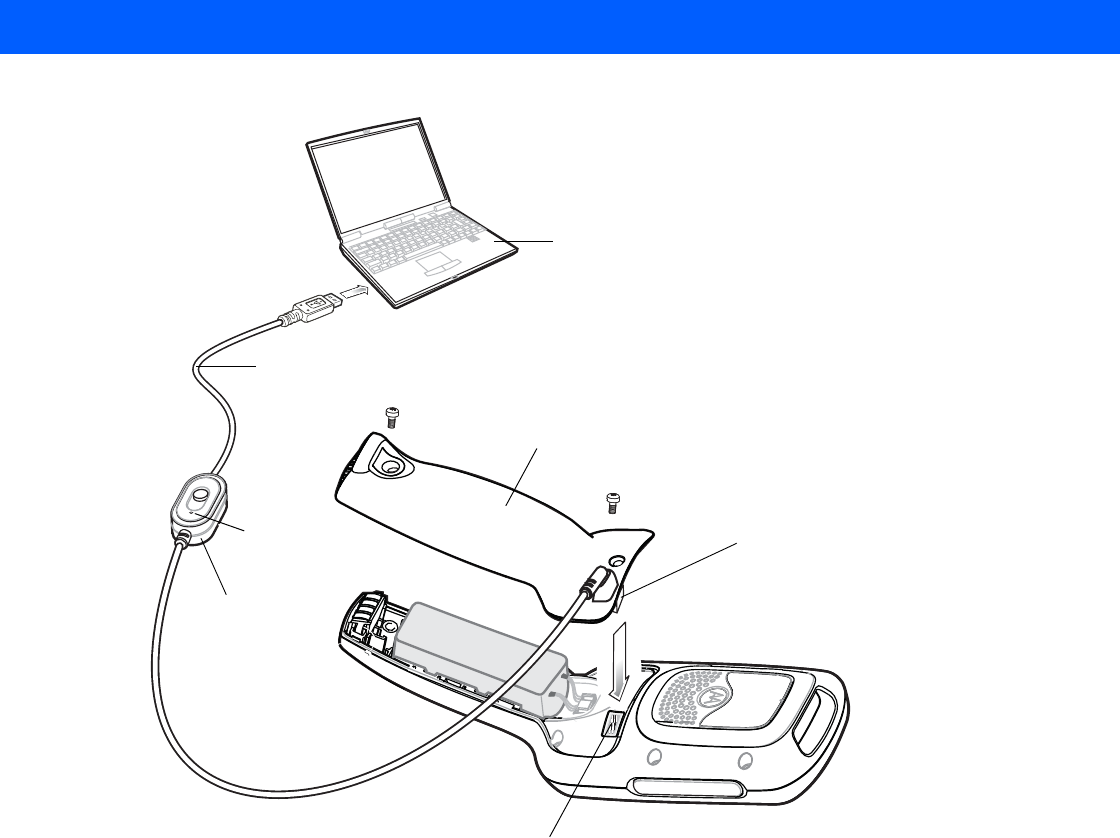
Sync with Host Computer 4 - 3
Figure 4-2
Installing the Programming Cable
5. Set the switch on programming cable of the programming cable panel to the side marked with a dot (see
Figure 4-2).
6. Connect the USB connector of the programming cable panel to the Host Computer. The host computer
automatically detects the MC18 and starts ActiveSync or Windows Mobile Device Center - the
synchronization program window appears on the host computer screen.
Dot Connector
Programming Cable
Programming Cable Panel
Host Computer
Sync Connector
Switch
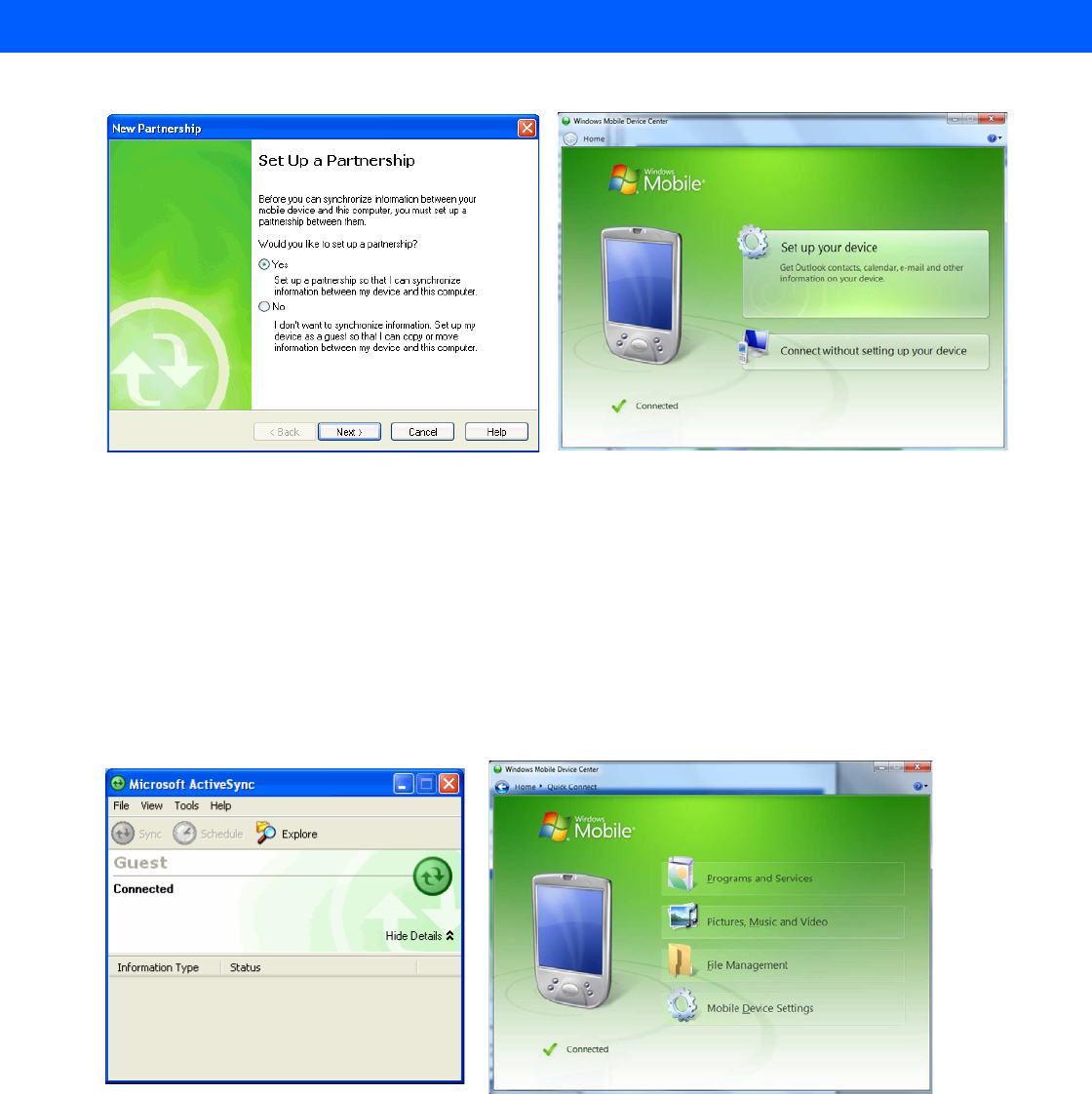
4 - 4 MC18 Product Reference Guide
Figure 4-3
Synchronization Program Windows
7. For ActiveSync, select the Yes radio button to create a partnership with the host computer or No radio
button to connect as a guest.
For Mobile Device Center, select Set up your device or select Connect without setting your device to
connect as a guest.
8. For ActiveSync, click Next. The Microsoft ActiveSync window indicates that it is connected to the MC18.
For Windows Mobile Device Center, select the required option.
Figure 4-4
ActiveSync / Windows Mobile Device Center Connected Window
Windows Mobile Device Center
ActiveSync
Windows Mobile Device Center
ActiveSync
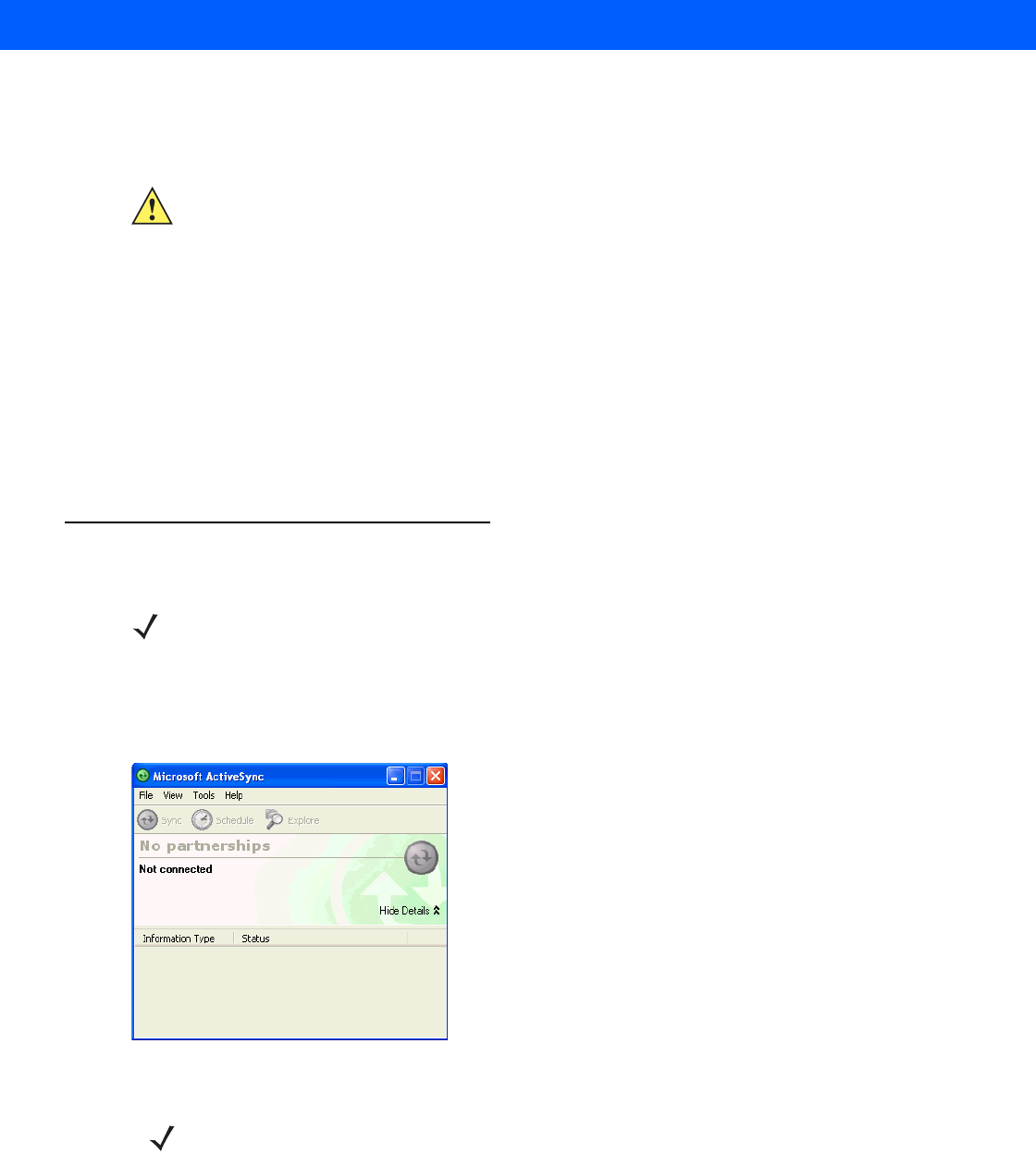
Sync with Host Computer 4 - 5
Removing the Programming Cable Panel
Perform this procedure to remove the programming cable panel.
1. Using a T8 Torx drive, loosen the two screws securing the programming cable panel to the MC18.
2. Lift the programming cable panel straight up.
Installing the Battery Cover
1. Align the battery cover on the MC18 and lower the panel to fit on the MC18.
2. Using a T8 Torx drive, secure with battery cover to the MC18 using the two Torx screws. Torque the screws
to 3.6 kgf/cm (3.1 in-lbs).
Setting Up an ActiveSync Connection on the Host Computer (with Windows XP)
Use this procedure to start ActiveSync:
1. Select Start > Programs > Microsoft ActiveSync on the host computer. The ActiveSync window displays.
Figure 4-5
ActiveSync Window
2. In the ActiveSync window, select File > Connection Settings. The Connection Settings window appears.
CAUTION Follow proper Electro-Static Discharge (ESD) precautions to avoid damaging the MC18. Proper ESD
precautions include, but are not limited to, working on an ESD mat and ensuring that the operator is
properly grounded.
NOTE The normal function of the product may be disturbed by Strong Electro Magnetic Interference (for example,
static electricity). If so, simply remove and re-insert the MC18 to resume normal operation. In case the
function does not resume, please use the product in another location.
NOTE Assign each MC18 a unique device name. Do not try to synchronize more than one MC18 to the same
name.
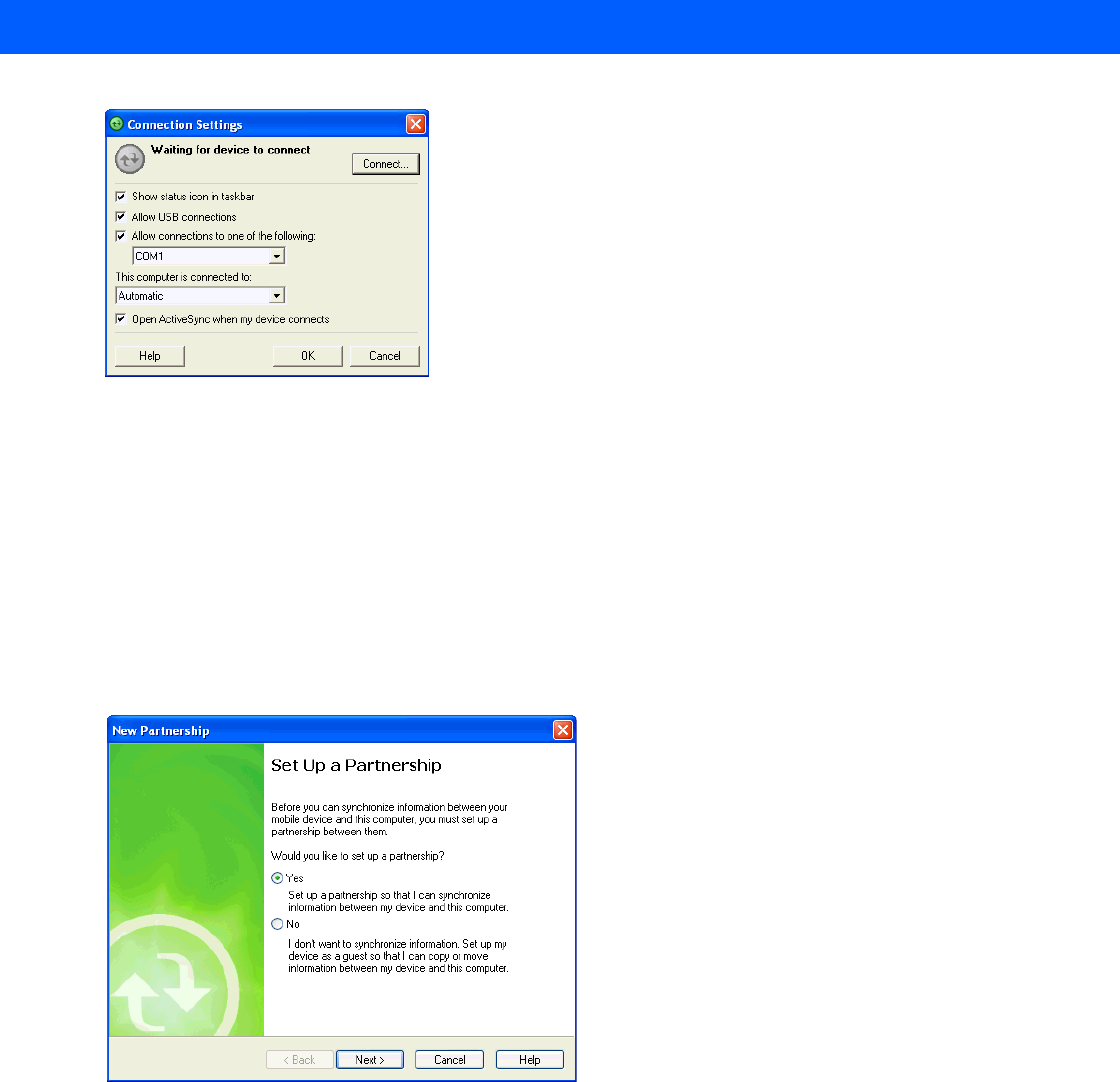
4 - 6 MC18 Product Reference Guide
Figure 4-6
Connection Settings Window
3. Select Allow USB connections check box.
4. Select the Show status icon in Taskbar check box.
5. Select OK to save any changes made.
Setting up a Partnership
Use this procedure to set up a partnership:
1. If the Get Connected window does not appear on the host computer, select Start > All Programs > Microsoft
ActiveSync.
Figure 4-7
New Partnership Window
2. Select if you want to set up a partnership. Select either the Yes or No radio button.
3. Click Next.
4. If No is selected, skip to step 7.
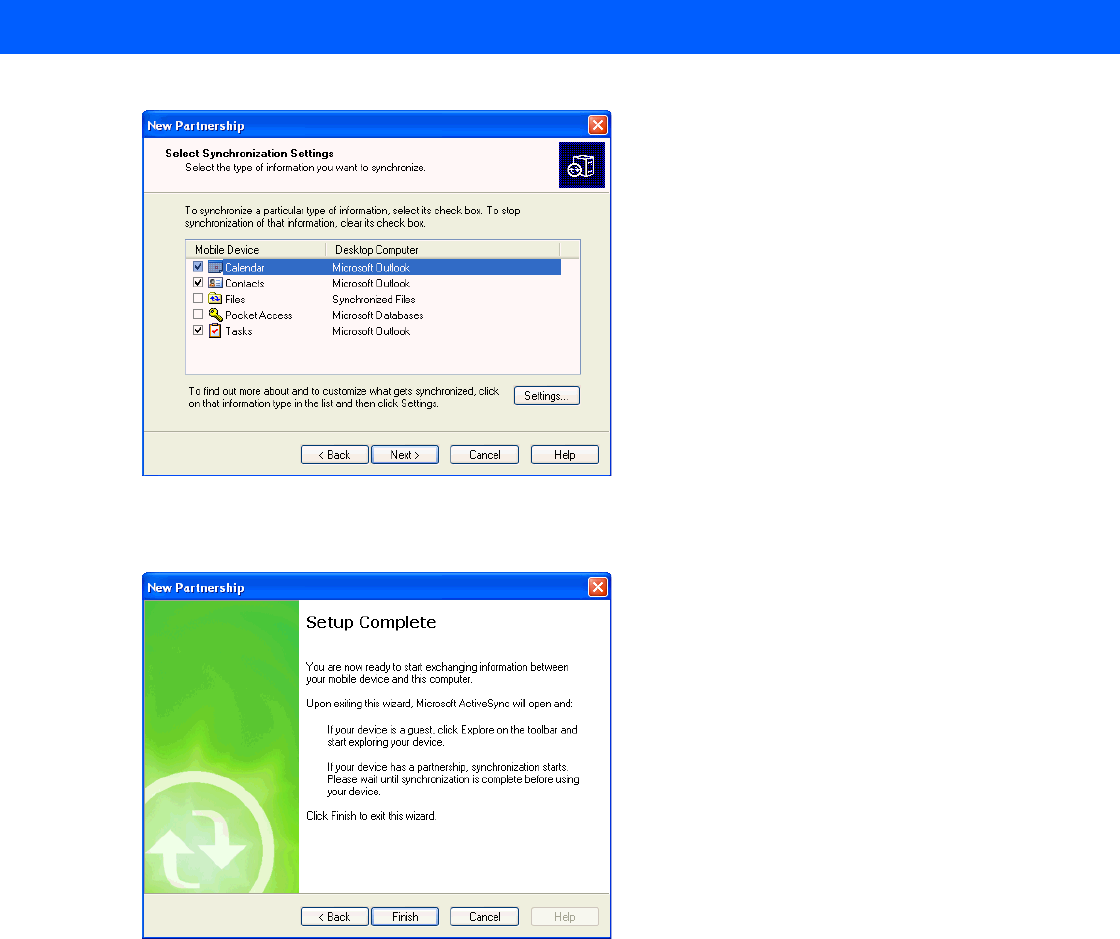
Sync with Host Computer 4 - 7
Figure 4-8
Select Synchronization Setting Window
5. Select the appropriate settings and click Next.
Figure 4-9
Setup Complete Window
6. Click Finish.
7. The Microsoft ActiveSync window displays.
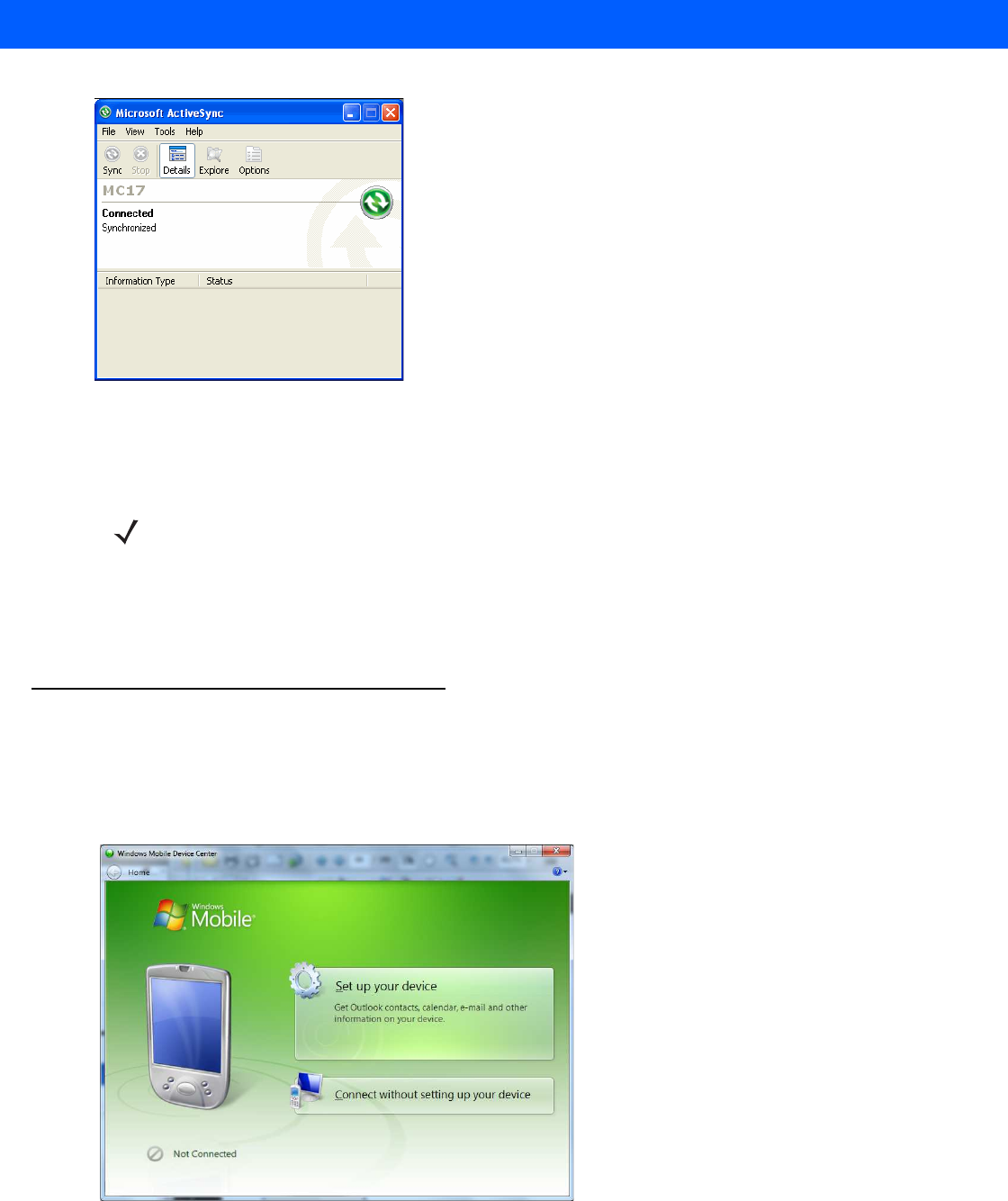
4 - 8 MC18 Product Reference Guide
Figure 4-10
ActiveSync Connected Window
During the first synchronization, information stored on the MC18 is copied to the host computer. When the copy
is complete and all data is synchronized, the MC18 can be disconnected from the host computer.
For more information about using ActiveSync, start ActiveSync on the host computer, then see ActiveSync
Help.
Setting Up a Windows Mobile Device Center Connection on the Host Computer
(with Windows 7)
To set up a Sync connection using Windows 7:
1. Select Start > All Programs > Windows Mobile Device Center on the host computer.
Figure 4-11
Windows Mobile Device Center (WMDC) Window
NOTE The first ActiveSync operation must be performed with a local, direct connection. To retain partnerships
after a cold boot, capture partnership registry information in a .reg file and save it in the Flash File
System, See the detailed information provided in the EMDK Windows CE Help File for Mobile
Computers.
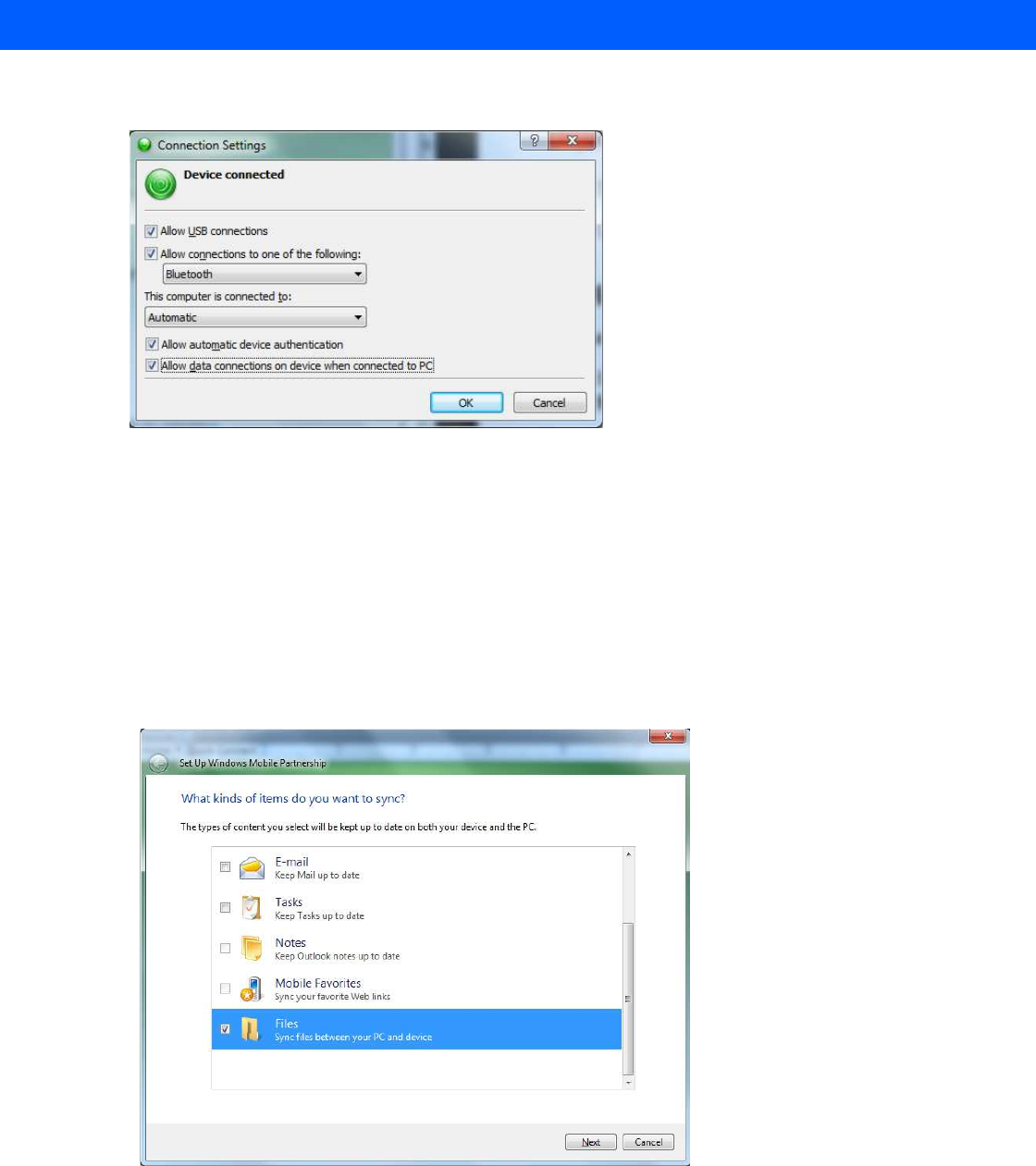
Sync with Host Computer 4 - 9
2. In the WMDC window, under Mobile Device Settings, click Connection settings.
Figure 4-12
Connection Settings Window
3. Select Allow USB connections and adjust any additional settings as needed.
4. Click OK to save your settings.
Setting up a Partnership
To set up a partnership:
1. In the WMDC window, under Mobile Device Settings, click Set up your device.
2. Check the Files check box and click Next.
Figure 4-13
Select Synchronization Setting Window
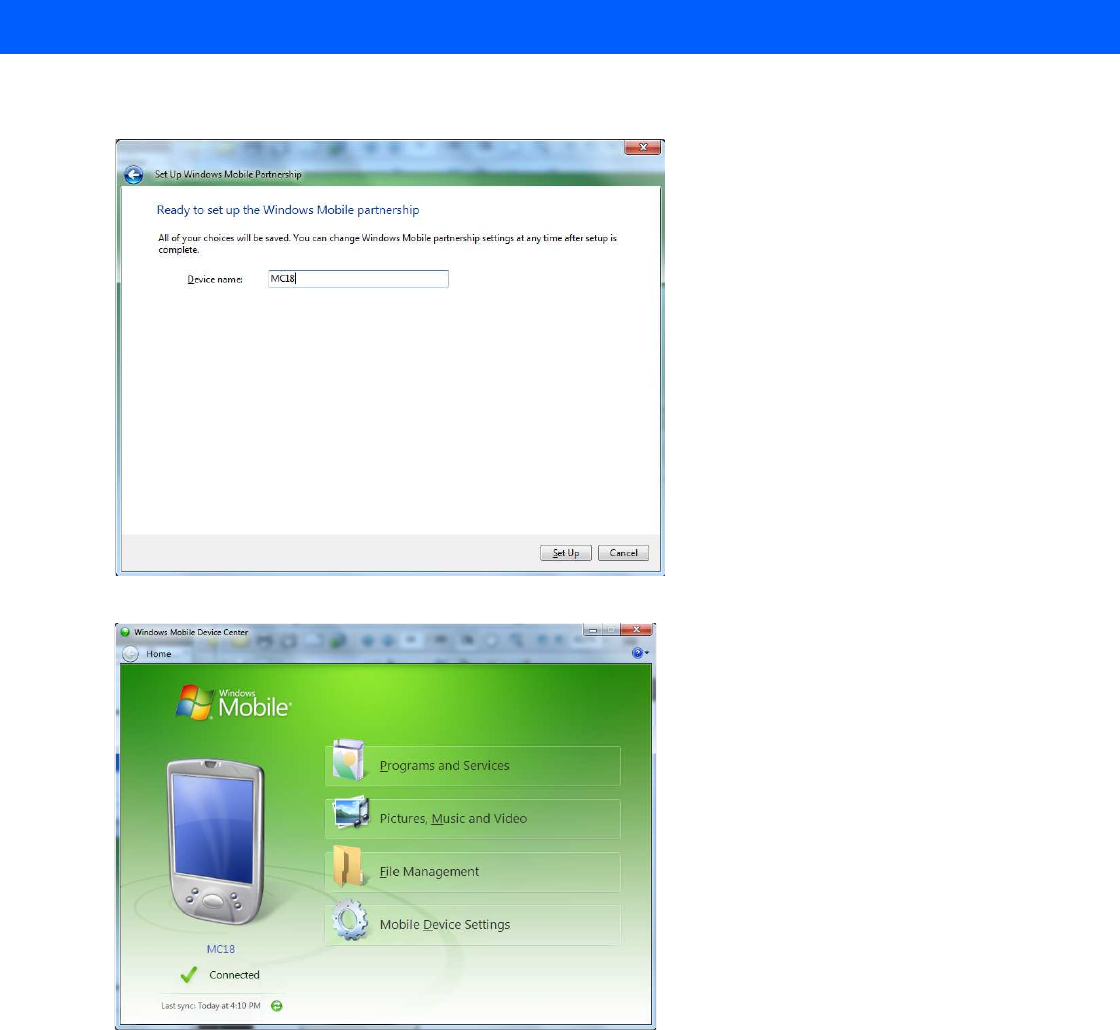
4 - 10 MC18 Product Reference Guide
3. Set your device name and click Set Up - the Connected Window will display.
Figure 4-14
Setup Complete Window
Figure 4-15
Connected Window
During the first synchronization, information stored on the MC18 is copied to the host computer. When the copy
is complete and all data is synchronized, the MC18 can be disconnect from the host computer.
For more information about using WMDC, start the application on the host computer, then see Help.

CHAPTER 5 USING THE WINDOWS CE
DESKTOP
Introduction
The MC18 runs Windows CE 7.0 operating system and the operating system is only available for configuration
when connected to a host computer via sync program.
The MC18 enabled device is available using the user interface (UI).
App Launcher Window
The App Launcher window allows the user to launch specific applications by tapping on a menu an item. If the
App Launcher window is closed, launch the App Launcher window by touching the App Launcher shortcut
on the MC18 desktop or selecting AppLauncher.exe in the Start > Programs > Windows Explorer directory.
See Appendix B, App Launcher Configuration for instructions on modifying the App Launcher menu.
NOTE App Launcher window may vary depending upon the operating system version.
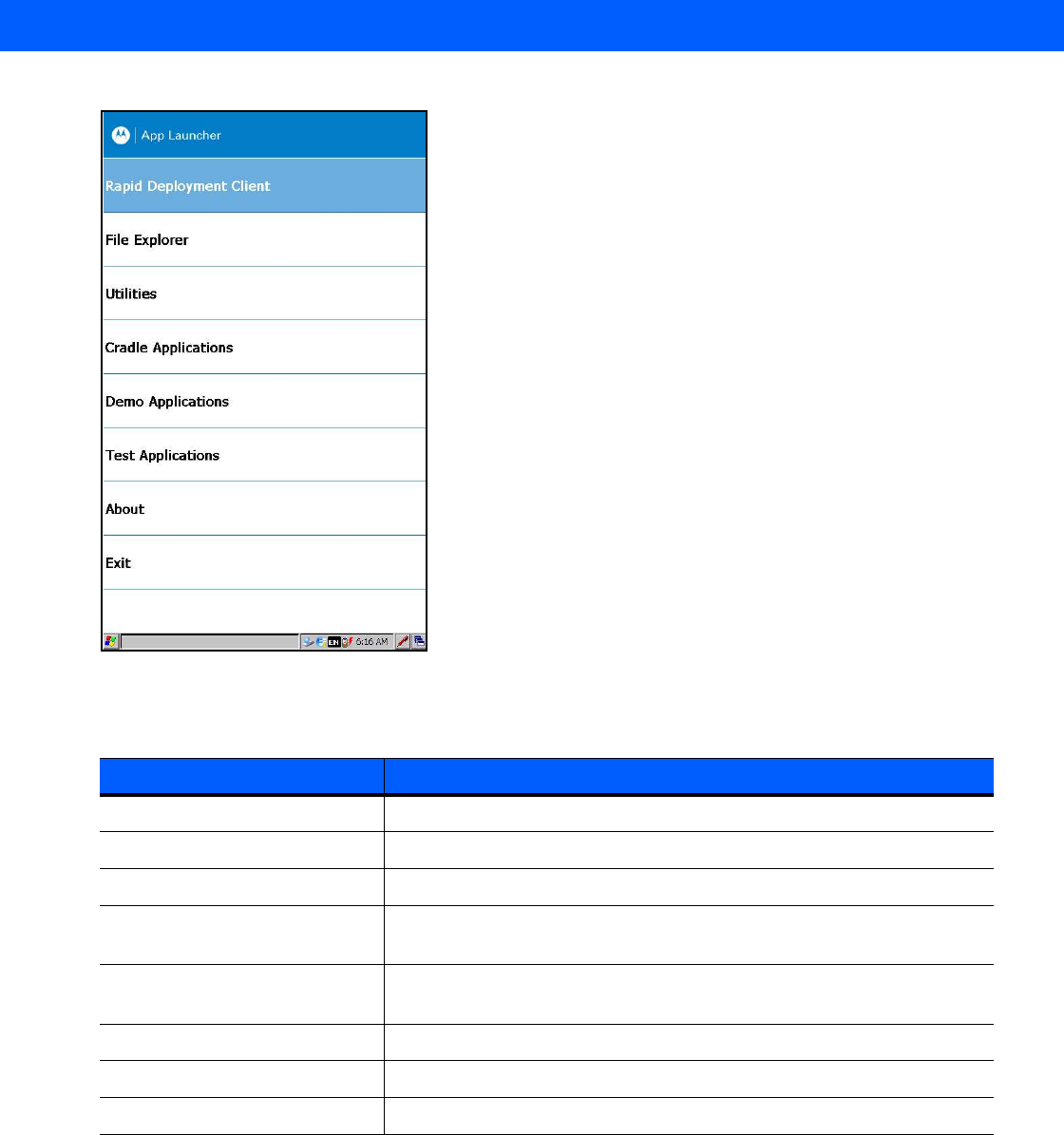
5 - 2 MC18 Product Reference Guide
Figure 5-1
App Launcher Window
Table 5-1
App Launcher Item Descriptions
Item Description
Rapid Deployment Client
Launches the Rapid Deployment application.
File Explorer
File Explorer enables working with files, folders and network on the MC18.
Utilities
Provides easy access to most used applications such as Internet Explorer.
Cradle Applications
Provides for cradle software update, control and settings and diagnostics
applications.
Demo Applications
Provides applications that demonstrate the operation of the MC18 such as
scan application.
Test Applications
Provides applications for performing diagnostics and testing of the MC18.
About
Displays information about the App Launcher.
Exit
Closes the Up Launcher window.
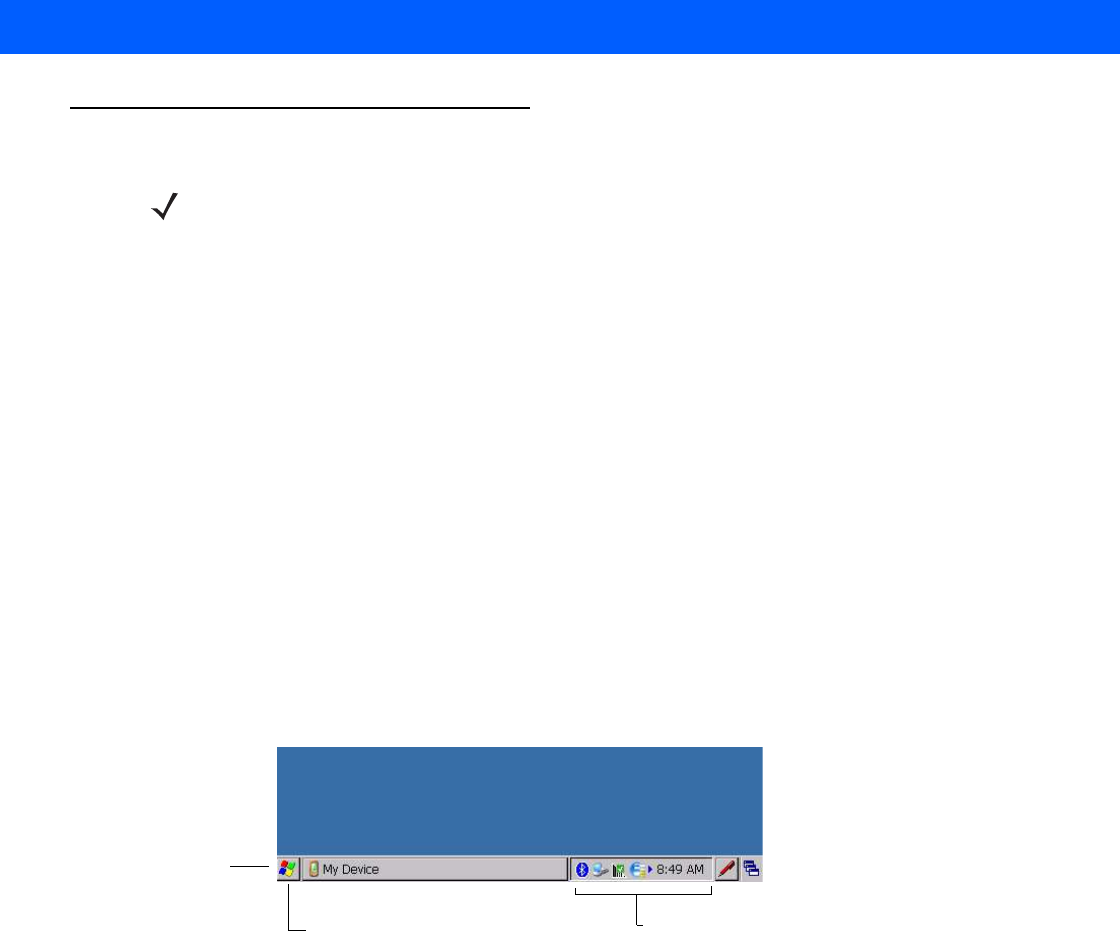
Using the Windows CE Desktop 5 - 3
Windows CE 7.0 Desktop
The following paragraphs describe the Windows CE 7.0 desktop. Depending upon the customer’s
configuration of the MC18, the desktop may not be available.
Status Icons
The Taskbar at the bottom of the window displays the active programs, battery status and communication
status. The taskbar (at the bottom of the screen) displays the Start button, active programs, battery status and
communication status. The taskbar icons are described in Table 5-2. The taskbar icons display the function
status, indicate what programs are active and indicate the battery charge status. The Taskbar buttons are used
to access menus, select/deselect functions or to change display windows.
•
Active Programs Icons: The active applications icons are displayed on the taskbar. If more than one
program is active, icons can be used to toggle between the open programs (applications). Touch on a
taskbar application to maximize the application.
•
AC Power/Battery Status Icons: The AC Power/Battery Status icons are shown in the taskbar to indicate
the present power supply status of the MC18. The battery status icons provide the battery status in 10%
increments from 10% to 100%.
The Taskbar is shown on the lower part of the MC18 screen. To set the properties of the taskbar, see
Properties on page 5-6.
Figure 5-2
Taskbar
NOTE The Windows CE 7.0 desktop may not be visible because the App Launcher application is active. To view
the desktop, close all running applications.
Start Button Status Icons
Task b a r
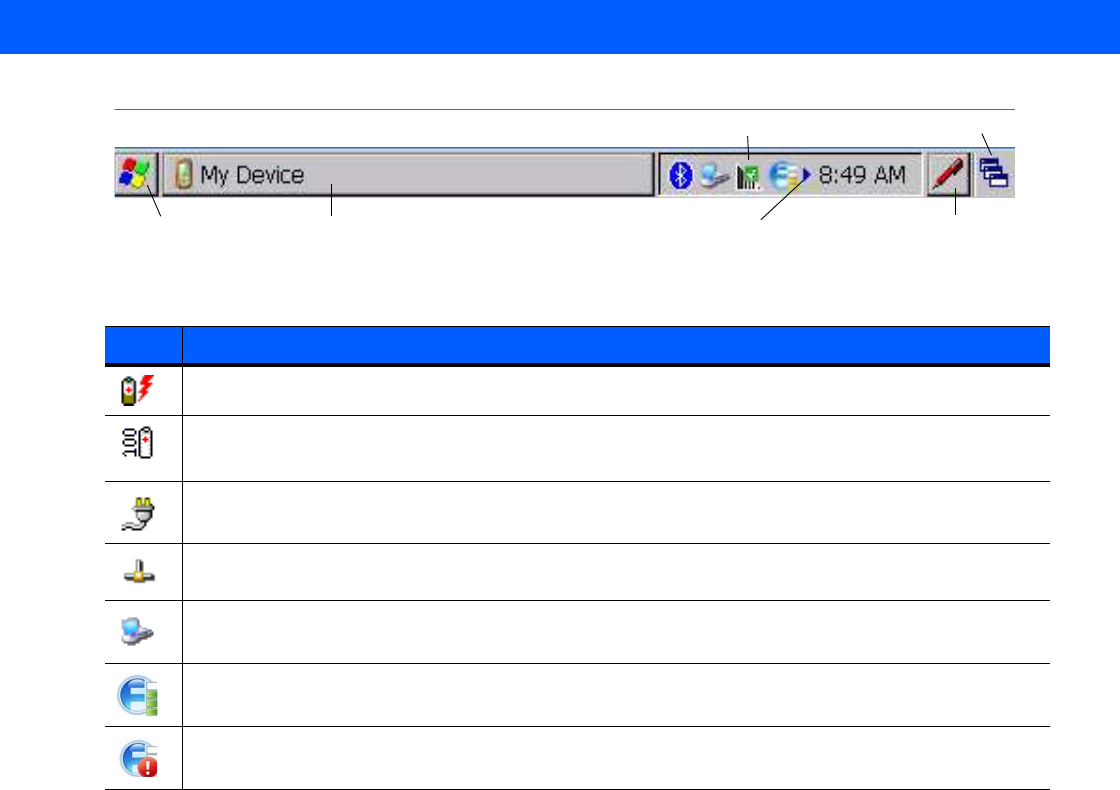
5 - 4 MC18 Product Reference Guide
Figure 5-3
Taskbar
Start Button
Touch the Start button to launch the Start menu.
•
Programs: Use to access available programs.
•
Favorites: Displays files in Favorites directory.
•
Documents: Displays files in Documents directory.
•
Settings: Accesses the Control Panel, the Network and Dial-up Connections and the Taskbar and Start
menu.
•
Help: Accesses the Windows CE Help.
•
Run . . . : Runs a program or application.
•
Suspend: Places the MC18 in the suspend state.
Table 5-2
Taskbar Icons
Icon Description
Indicates that the battery is charging.
Indicates that the battery is fully charged (100% charged).
The battery status icons provide the battery status in 10% increments from 10% to 100%.
Indicates that the battery is fully charged and the MC18 is running on external power.
Indicates IP status. Only displays when the MC18 is in emulation mode.
Indicates that the Sync application is running.
Indicates that the wireless application radio is connected to a wireless LAN network with excellent
signal strength.
Indicates that the wireless application radio is not connected to a wireless LAN network.
Start Button
Task Bar with Status Icons
Keyboard Input Panel Button
Desktop Display Button
Currently Open Programs Scroll Status Icons
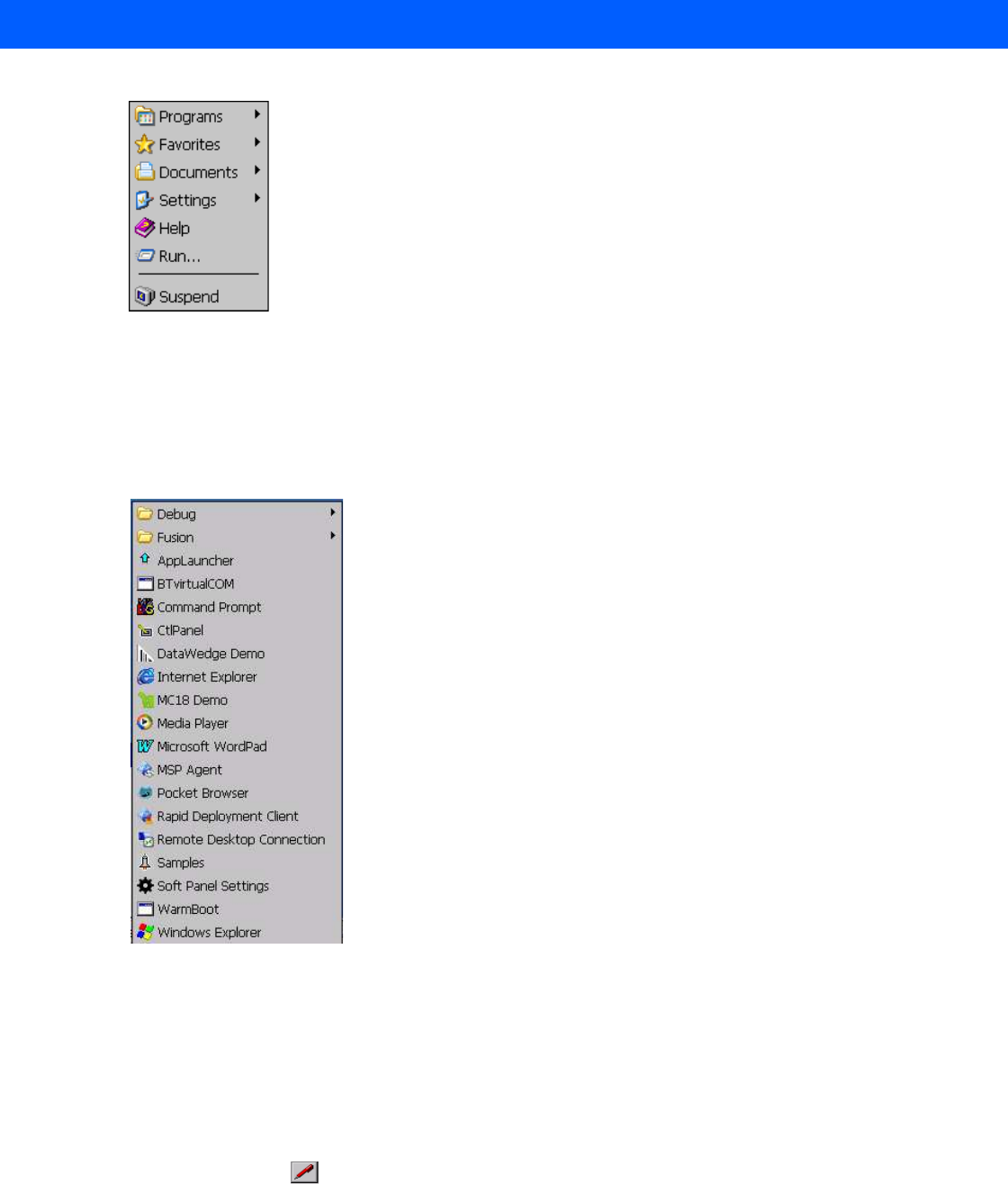
Using the Windows CE Desktop 5 - 5
Figure 5-4
Start Menu
Programs Menu
From the Start menu, click Programs to launch the Programs menu. Refer to the Application Guide for
Symbol Technologies Enterprise Mobility Devices, p/n 72-68901-xx and the Microsoft® Applications for
Windows Mobile and WinCE 7.0 User Guide, p/n 72E-78456-xx for application information.
Figure 5-5
Programs Menu
Desktop Display Button
Use the Desktop Display button to minimize all open programs and display the desktop.
Entering Information Using the Keyboard Input Panels
Use the keyboard input panels (soft keyboard) to enter information in any program. To launch the keyboard
input panel, click the button on the taskbar. Select the type of input panel (Keyboard or XAMLIM). Touch a
key to enter the value. Touch the keyboard input panel button to display or to hide the keyboard input panel.
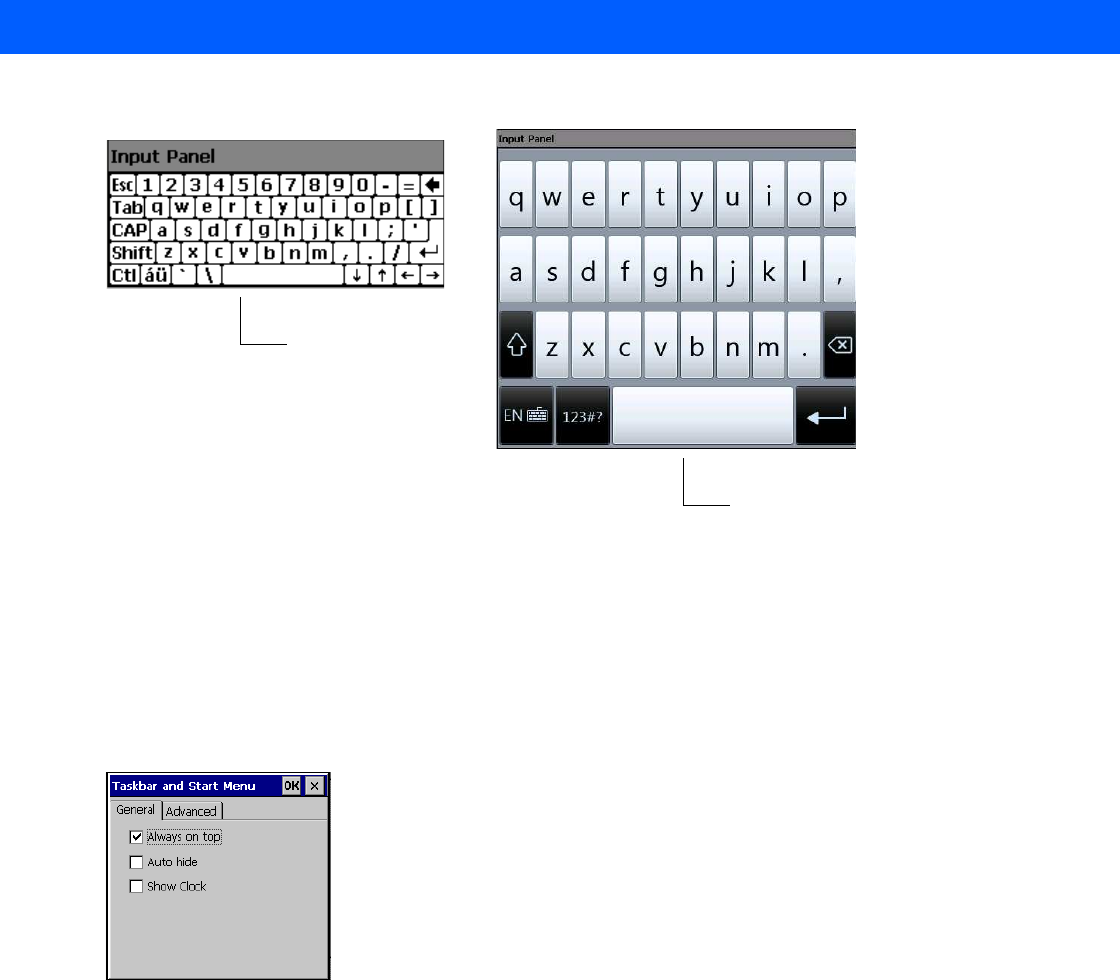
5 - 6 MC18 Product Reference Guide
Figure 5-6
Keyboard Input Panel
Task Bar and Start Menu Properties
Use the Properties functions to set display and clock options.
Properties
1. Touch Start > Settings > Taskbar and Start Menu ... . The Taskbar and Start Menu window displays.
Figure 5-7
Taskbar and Start Menu- General Tab
2. This window provides taskbar options:
•
Check the Always on Top check box to keep the taskbar on top of all other windows.
•
Check the AutoHide check box to make the taskbar disappear, click the bottom of the display to make
the taskbar return.
•
Check the Show Clock check box to display the clock on the taskbar.
3. Tou c h OK to save the settings and exit the window.
Advanced Tab
1. Touch the Advanced tab.
Keyboard
XAMLIM
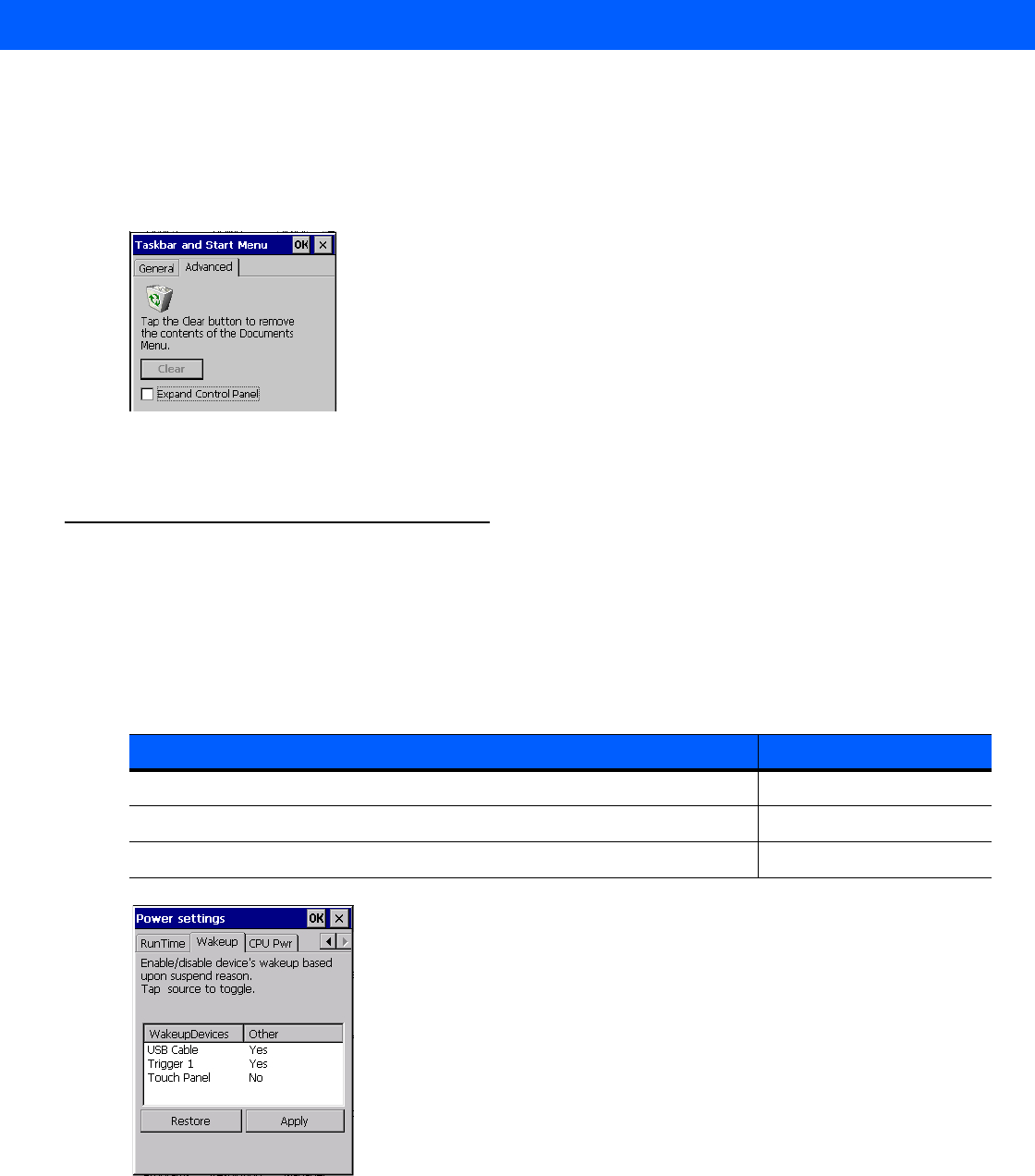
Using the Windows CE Desktop 5 - 7
2. Touch the Clear button to delete all of the documents listed in the Start > Documents entry, see Start
Button on page 5-4. Typically this list is empty, but if there were documents in the list the Clear button
would delete them.
3. Touch the Expand Control Panel check box to display the entire contents of the Control Panel in list form,
rather than icons.
Figure 5-8
Taskbar and Start Menu-Advanced Tab
4. Touch OK to save the settings and exit the window.
Waking the MC18
The wake up conditions define what actions wake up the MC18 after it has gone into suspend mode. The
MC18 can go into suspend mode automatically by control panel time-out settings. These settings are
configurable and the factory default settings are shown in Table 5-3. To set the wake up conditions select Start
> Settings > Control Panel > Power icon > Wakeup tab.
Figure 5-9
Wakeup Tab
Table 5-3
Wakeup Default Settings
Condition for Wakeup Automatic Time-out
Touch Panel (Screen) No
Trigger 1 (Scan key) Yes
USB Cable Yes

5 - 8 MC18 Product Reference Guide

CHAPTER 6 SPECIAL CONSIDERATIONS
Introduction
The chapter provides information for:
•
Using language fonts
•
software development considerations
•
Improving battery charge time
•
Improving battery life
•
Cradle applications
•
MC18 Hardware Diagnostics
Fonts
The MC18 supports the following language fonts:
•
English
•
French
•
Italian
•
German
•
Spanish
•
Swedish
•
Russian
•
Greek (fonts support only)
•
Arabic (fonts support only)
The MC18 supports the installation of font libraries for use with application and web development. Simplified
Chinese, Korean, and Japanese font libraries are available on the Support Central Web site,
http://supportcentral.motorola.com. Other standard UTF-8 encoded fonts are available from third party font

6 - 2 MC18 Product Reference Guide
vendors. Developers should refer to Microsoft and third party vendor documentation for development and
usage details.
It should be noted that installing a language font library will not change the language configuration of the
operating system image, i.e., Windows messages will still be displayed in the language designated in the
factory supplied operating system image.

Special Considerations 6 - 3
Asian Font Installation
The Asian fonts must be installed onto the MC18.
Use this procedure to install Asian fonts onto the MC18.
1. Download the font package from Support Central.
2. Copy the language font files into the Application folder on the MC18:
•
.ttf, .ttc or .ac3 files
•
.reg files (required for Asian fonts)
•
.cpy files.
3. Cold boot the MC18.
After the MC18 re-boots, the installed fonts are available for use.
Refer to http://msdn2.microsoft.com/en-us/library/aa911446.aspx for an explanation of font usage and
installation.
Software Development Considerations
•
Dim or turn off the backlight when the MC18 is idle.
•
Whenever possible use default key code settings.
•
To improve performance, use RAM instead of flash memory.
•
Always lock the cradle after unlocking it.
•
Cold booting the MC18 erases all files in RAM. Be sure to save any critical files in Application folder, e.g.;
Radio profile, time zone setting, license keys etc.
•
User developed applications should provide a method for exiting or launching Rapid Deployment to
enable re-staging the MC18.
•
For detailed information on how to control the cradle LEDs and locking/unlocking the MC18 in the cradle,
refer to the EMDK Help file.
Tips for Improving Battery Charge Time
To improve battery charging time:
•
Avoid unnecessary wireless communication while the MC18 is in the cradle.
•
Use maximum power save mode when setting up the wireless profile. (This greatly improves charging
time since the radio accounts for a large amount of power).
•
Ensure there is a good wireless signal nearby (a poor signal causes the radio to enter high power mode
much more often then normal.)
•
Turn off display while in the cradle.
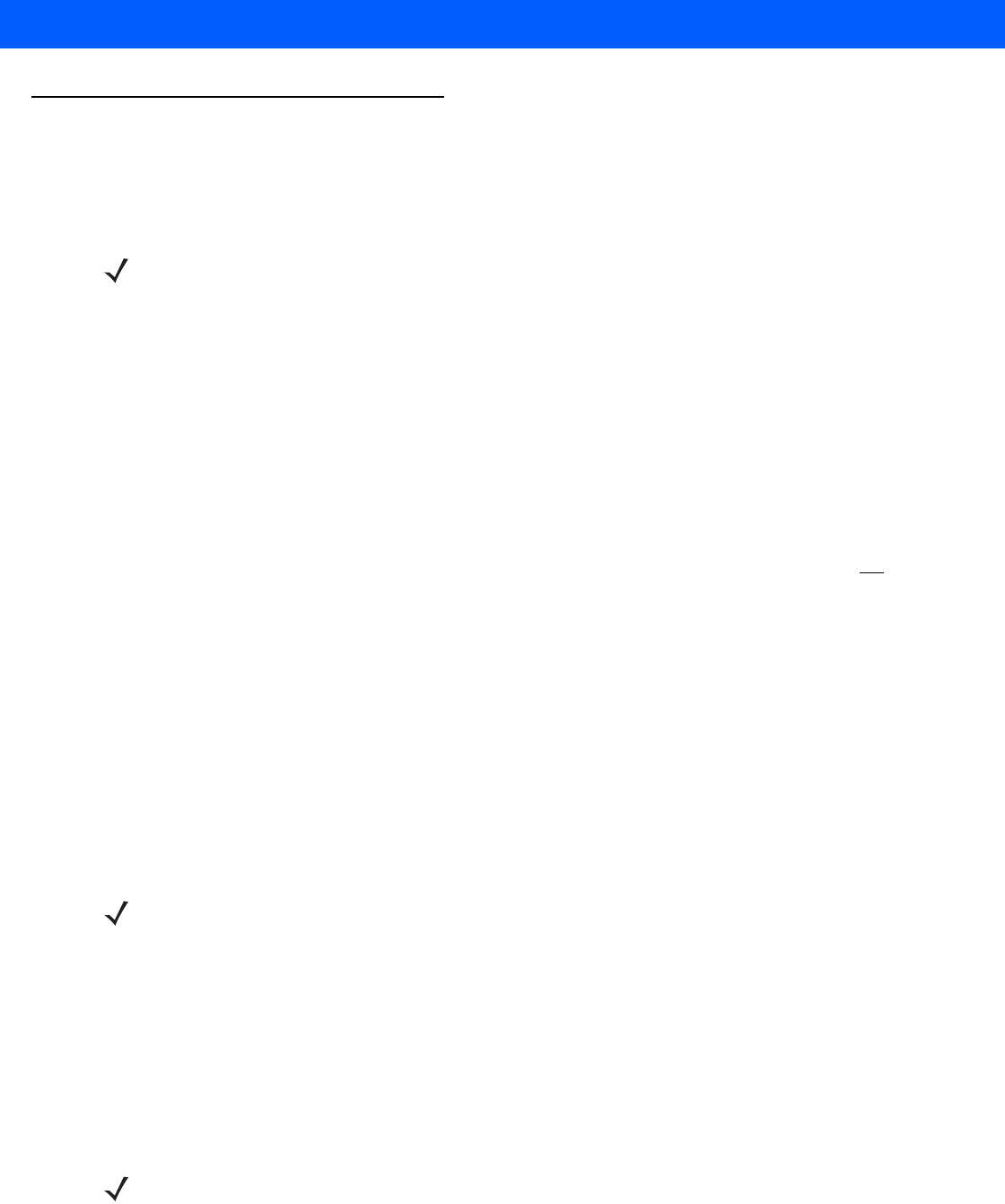
6 - 4 MC18 Product Reference Guide
Tips for Improving Battery Life
The MC18 has many functions to allow server/client applications control over its power management. To
improve battery life:
•
Place the MC18 in a cradle connected to AC power when not in use.
•
After the customer check-out, place the MC18 in suspend mode. This prevents the MC18’s battery from
discharging while sitting at a counter before being returned to the cradle. Once inserted in the cradle, the
MC18 wakes up automatically.
•
If placed in suspend mode, scan key press can be set to wake up the MC18. This can greatly increase
battery life.
•
If the user application does not allow placing the MC18 in suspend mode, turn off the backlight after the
time-out period.
•
Set the backlight brightness to the minimum required by the application.
•
Ensure a good wireless signal.
•
Set the wireless profile to MAX Power Save mode. If CAM mode is selected, the device does not
maximize power savings.
Running time for the MC18 is expected to be approximately 6 to 7 hours with the following profile:
•
2 scans/minute
•
transmitting 32K bytes of data per scan
•
75% display brightness
•
50% On/Off backlight
•
Associate to an access point (AP) with “Good” signal strength and configure the wireless profile to MAX
Power Save mode.
Changing the Power Settings
Use this procedure to set the MC18 to turn off after a short period of non-use:
1. Select Start > Settings > Control Panel > Power icon > Advanced tab.
2. Select the On battery power: Turn off device if not used for: check box and select a value from the
drop-down list box.
3. Select OK.
Changing the Display Backlight Settings
Use this procedure to change the display backlight settings to conserve battery power:
NOTE In suspend mode, the radio cannot communicate with an AP.
NOTE Use remote control software to navigate the operating system. See Chapter 5, Using the Windows CE
Desktop for instructions.
NOTE Use remote control software to navigate the operating system. See Chapter 5, Using the Windows CE
Desktop for instructions.

Special Considerations 6 - 5
1. Select Start > Settings > Control Panel > Backlight icon > Battery Power tab.
2. Select the On battery power: Disable backlight if not used for: check box and select a value from the
drop-down list box.
3. Select the Brightness tab.
4. Select the Disable backlight check box to completely turn off the display backlight.
5. Use the slider to set the brightness of the backlight. Set it to a low value to save battery power.
6. Select OK.
The display backlight value can also be set using a registry setting.
Key Name: [HKEY_CURRENT_USER\ControlPanel\BackLight]
"BatteryTimeout"=dword:00000000 ; timeout set to never
"ACTimeout"=dword:00000000 ; timeout set to never
NOTE By default, backlight is set NOT to time-out on user inactivity – this can be modified using the
Backlight control panel applet.
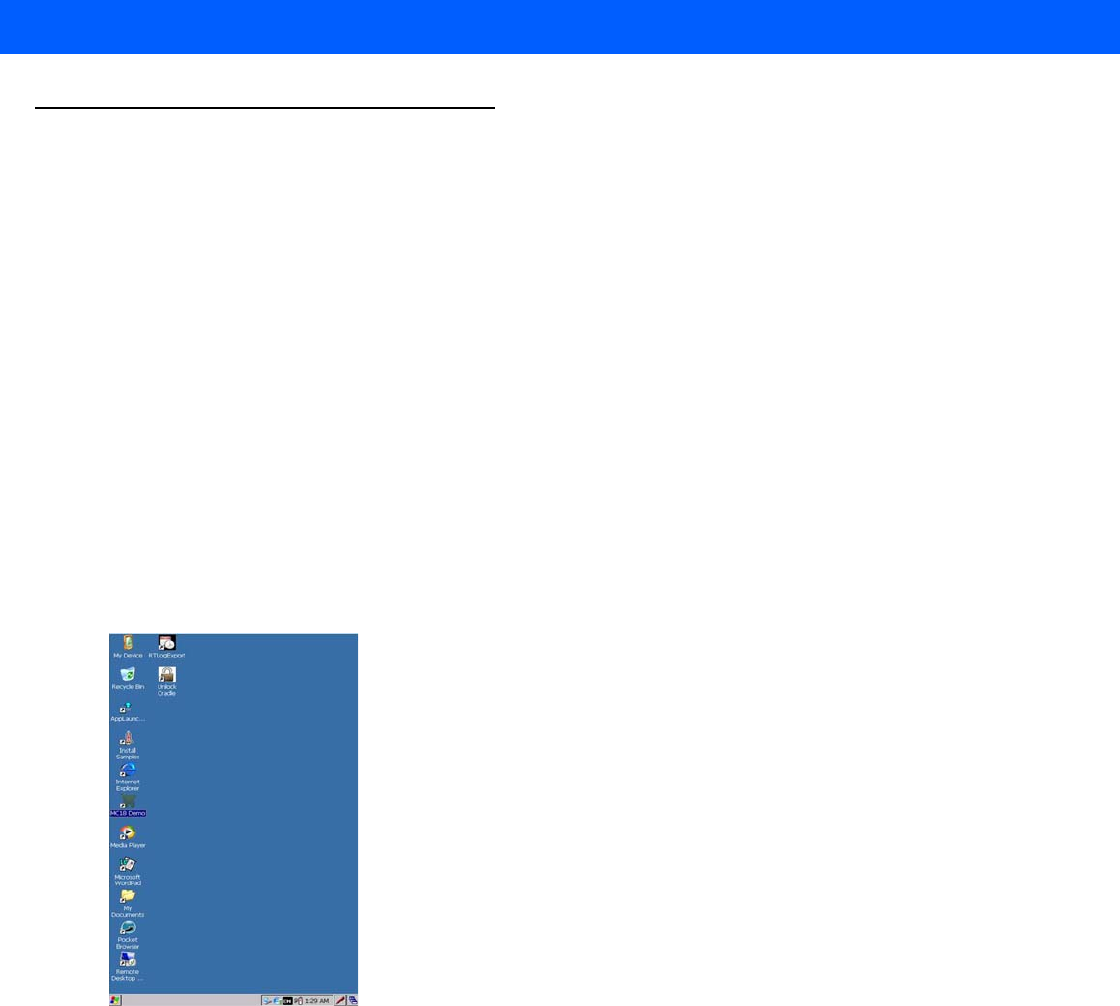
6 - 6 MC18 Product Reference Guide
Cradle Utility
The cradle Utility enables to:
•
Updating the cradle firmware
•
Setting and controlling the cradle
•
Performing cradle diagnostics
•
Viewing cradle information
Cradle Firmware Update
The CradleFWUpdater application allows to manually update cradle firmware using MC18 terminal.
Use this procedure to update Cradle Firmware:
1. Using a synchronization program, copy the new firmware file to the MC18 (see Chapter 4, Sync with Host
Computer).
2. On the home screen of the MC18, double click the AppLauncer icon.
Result: The App Launcher screen is displayed.
Figure 6-1
MC18 Home Screen
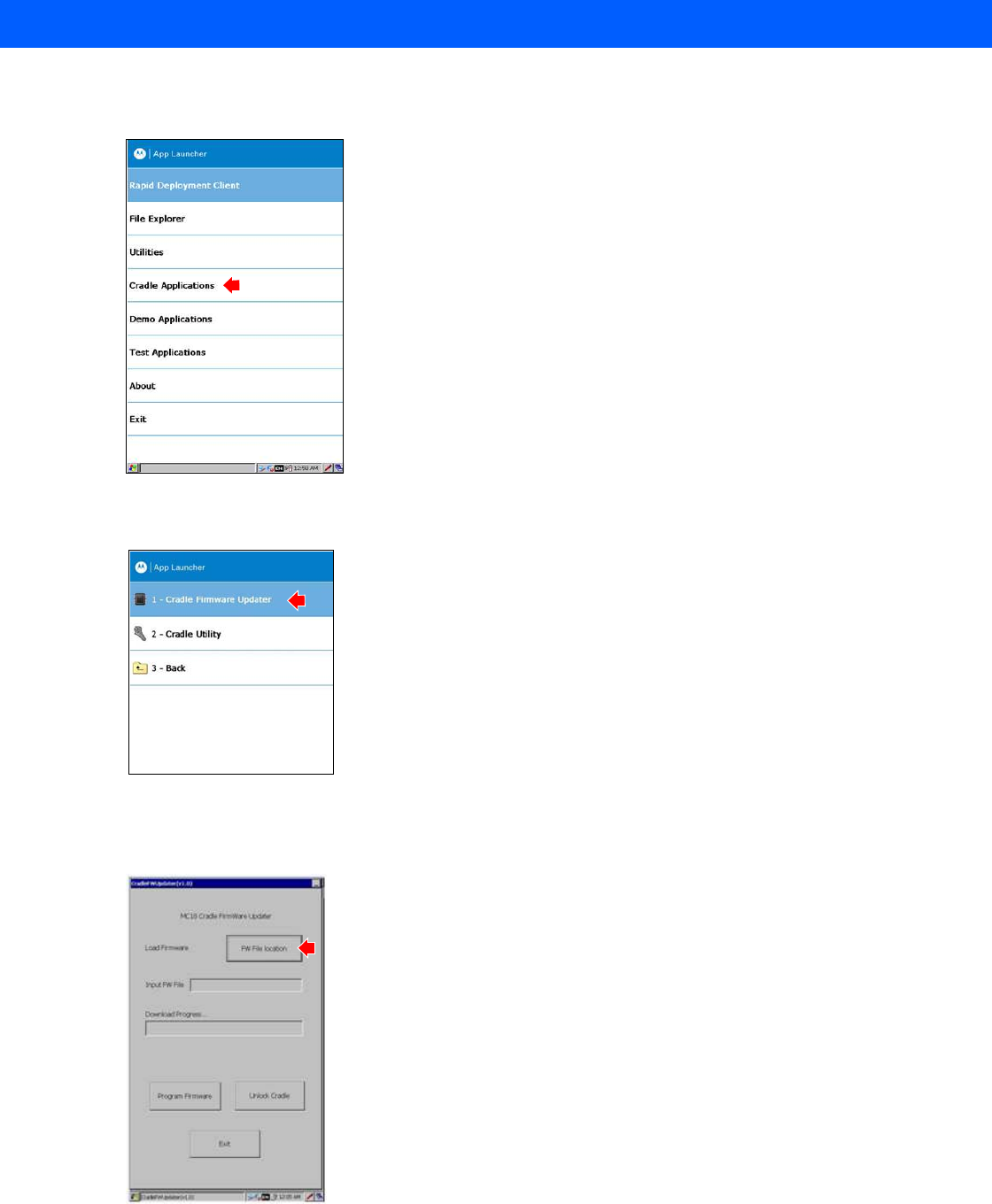
Special Considerations 6 - 7
3. On the App Launcher screen, click Cradle Applications.
Result: The Cradle Applications menu is displayed
Figure 6-2
App Launcher Screen
4. On the Cradle Applications menu, click Cradle Firmware Update.
5. Dock the MC18 inside the cradle.
6. Double click FW File location.
Result: The Select HEX box is displayed.
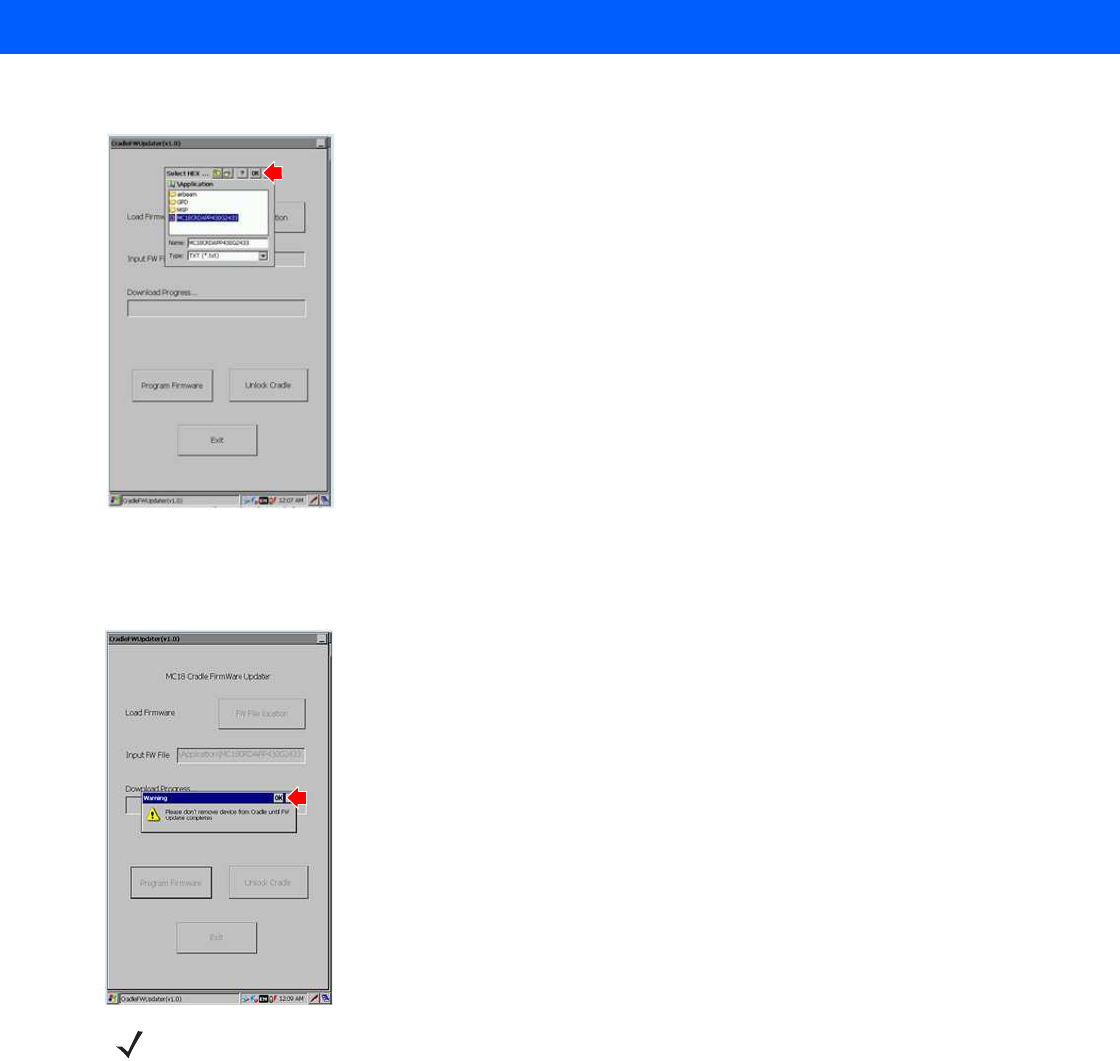
6 - 8 MC18 Product Reference Guide
7. From the Select HEX box, select a firmware file and click OK.
8. Click Program Firmware. A warning box displays Please don’t remove the device from the cradle until
PW Update completes.
9. Click OK to initiate the firmware update process.
NOTE During the firmware initiation process, the application resets the cradle. If the following error box displays:
Please manually rest the cradle and then press “OK” button. The user is required to manually reset
the cradle.
Perform this procedure to manually reset the cradle:
a. Disconnect power from the power supply unit of the cradle.
b. Reconnect power to the power supply unit of the cradle.
c. Click OK before the LEDs on the cradle start glowing, to remove the error message and
continue. Failing to click OK before the LEDs starts glowing will re-display the error message.
If user fails continuously 5 times, the firmware update process stops.
d. If application is successful, it will start downloading process as from step 6.
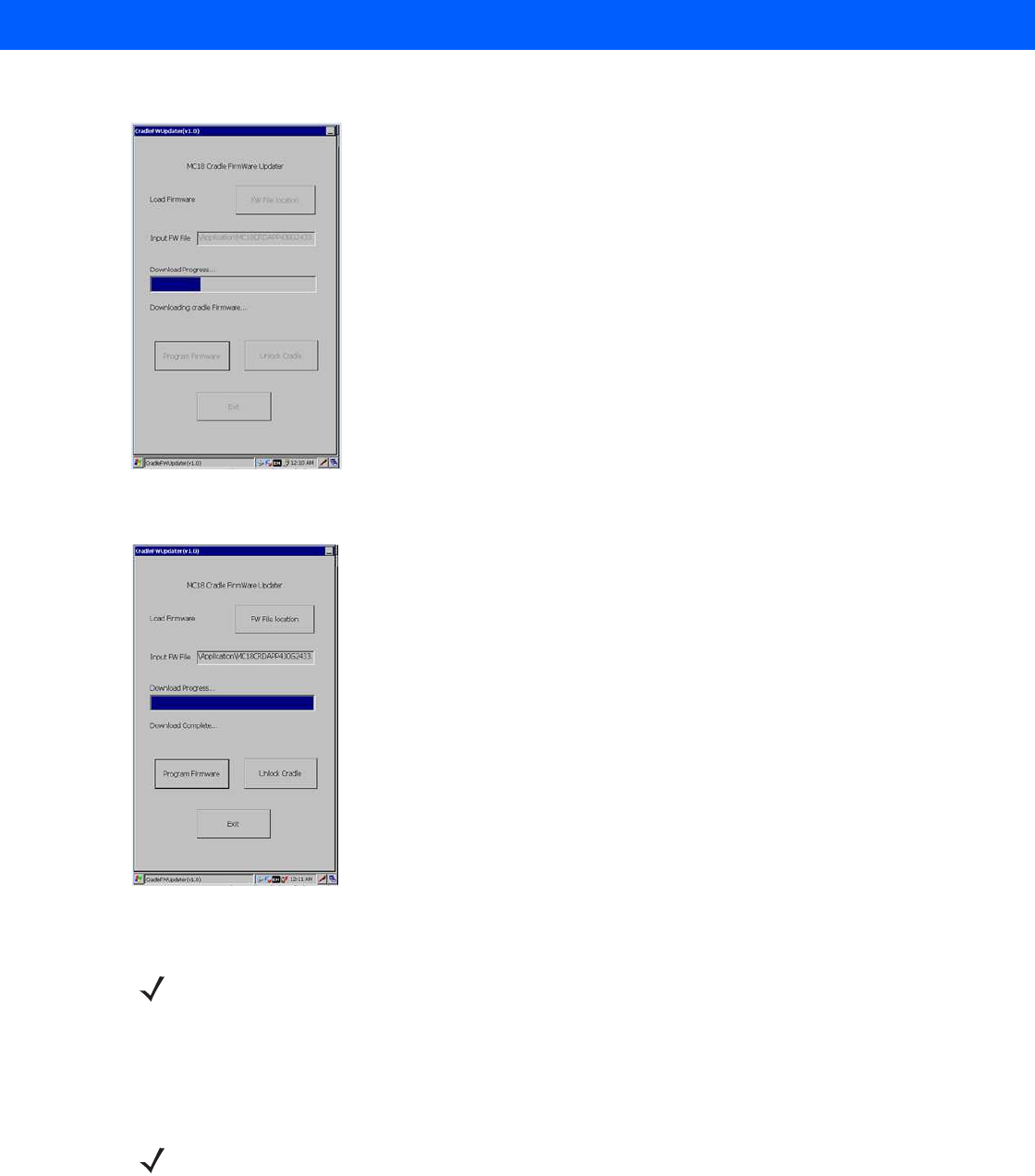
Special Considerations 6 - 9
1. After resetting the cradle, the application starts the firmware download process.
2. When Download Complete is displayed on the screen, the firmware update process is completed
successfully. Click Unlock Cradle to unlock and remove the MC18 from the cradle.
Setting and Controlling the Cradle
The Cradle Utility application allows to manually set and control cradle features.
•
Unlock: enables to set a 10 to 30 seconds time-out delay before the MC18 is releases from the cradle.
•
Cradle Information: Setting or retrieving the cradle ID and location (row, column and dispenser wall).
•
Setting the cradle charging rate: Depending on the cradle installation configuration, the store technician
can configure each individual cradle slots to enable/disable fast charge. Each cradle can be configured
NOTE Setting and Controlling the cradle can also be done through the Pocket Browser application.
NOTE The cradle ID and location information and charge settings is retained across firmware upgrades.
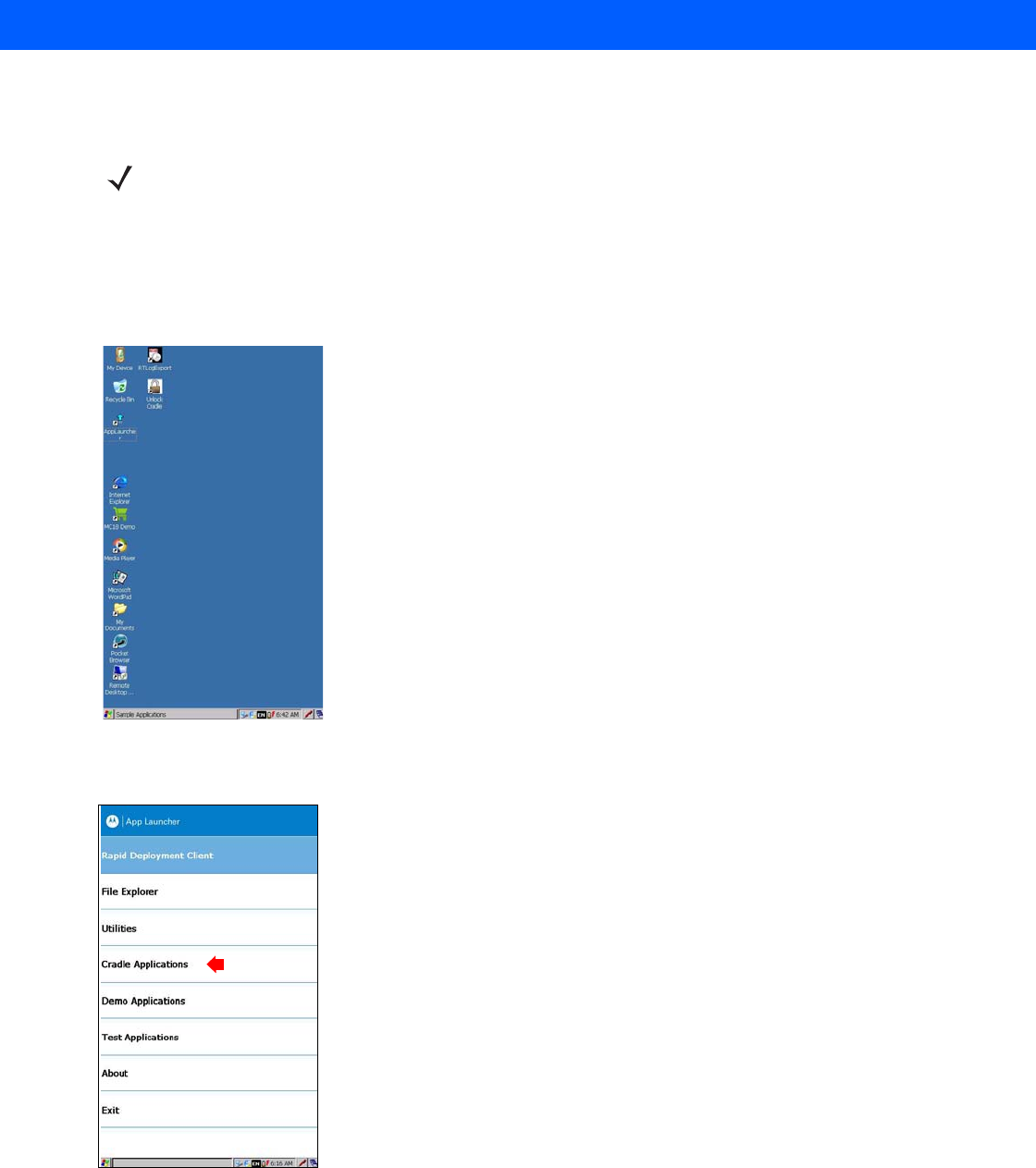
6 - 10 MC18 Product Reference Guide
to charge its docked terminal at 1Ah (normal charging mode - default setting) or 1.5Ah (fast charging
mode).
Use this procedure to set and control the cradle:
1. Dock the MC18 inside the cradle.
2. On the home screen of the MC18, double click the AppLauncer icon on the home screen of the MC18
Result: The App Launcher screen is displayed,
3. On the App Launcher screen, click Cradle Applications.
Result: The Cradle Applications menu is displayed
NOTE The cradle charging rate is retained across firmware upgrades.
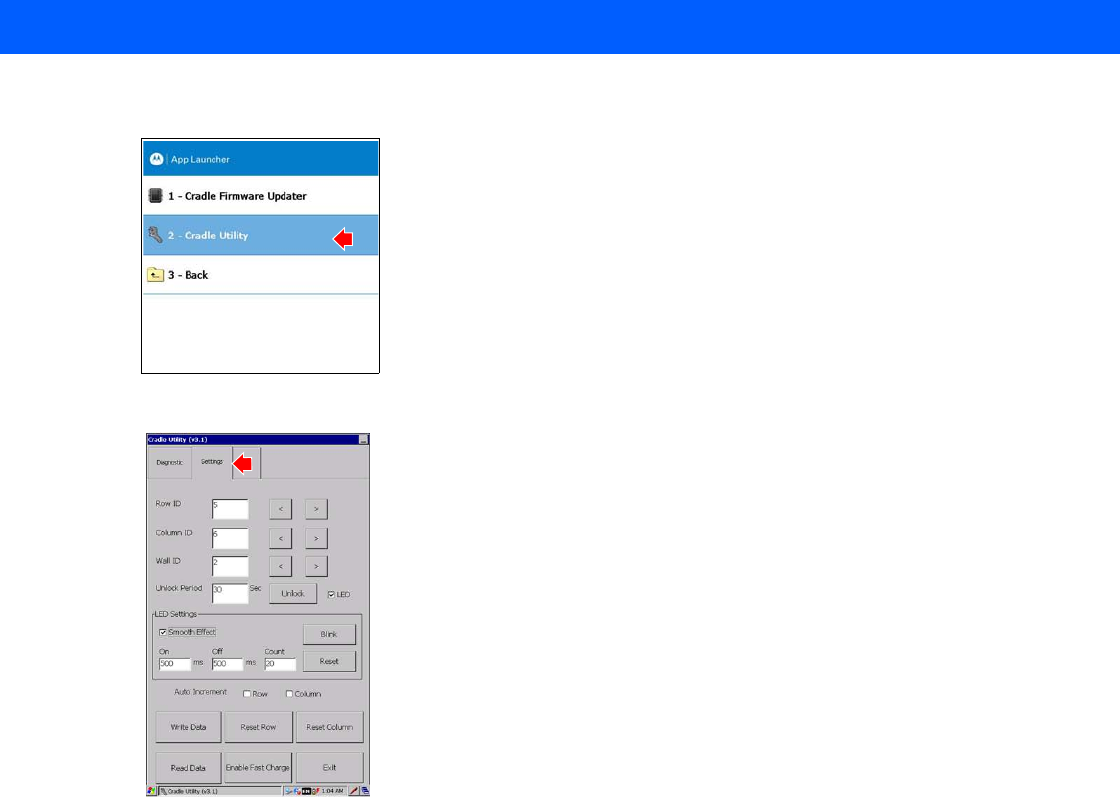
Special Considerations 6 - 11
4. On the Cradle Applications menu, click Cradle Utility.
5. Click the Settings tab to set the cradle information:
a. Row ID: The cradle row number in the dispenser wall.
b. Column ID: The cradle column number in the dispenser wall.
c. Wall ID: The number of dispenser wall where the cradle is positioned.
d. Unlock Period: The number of seconds that pass from the time the unlock signal is received to
unlocking the MC18 from the cradle.
e. Unlock: Press Unlock to manually unlock the MC18 from the cradle.
f. LED: Check the LED box to enable the cradle LED indication.
g. Smooth Effect: Check the Smooth Effect box to enable soft on/off blink of LED.
h. LED Setting > On: The cradle LED is set to blink during unlock. Set the duration that the LED remains
off.
i. LED Setting > Off: The cradle LED is set to blink during unlock. Set the duration that the LED will
remains off during a blink.
j. LED Setting > Count: The cradle LED is set to blink during unlock. Set the number of blinks that the
LED after receiving an unlock signal.
k. Blink: Click to test the cradle LED operation.
l. Write Data: Program the information shown on the screen to the cradle memory.
m. Reset Row: Remove row information from the cradle memory.
n. Reset Column: Remove column information from the cradle memory.
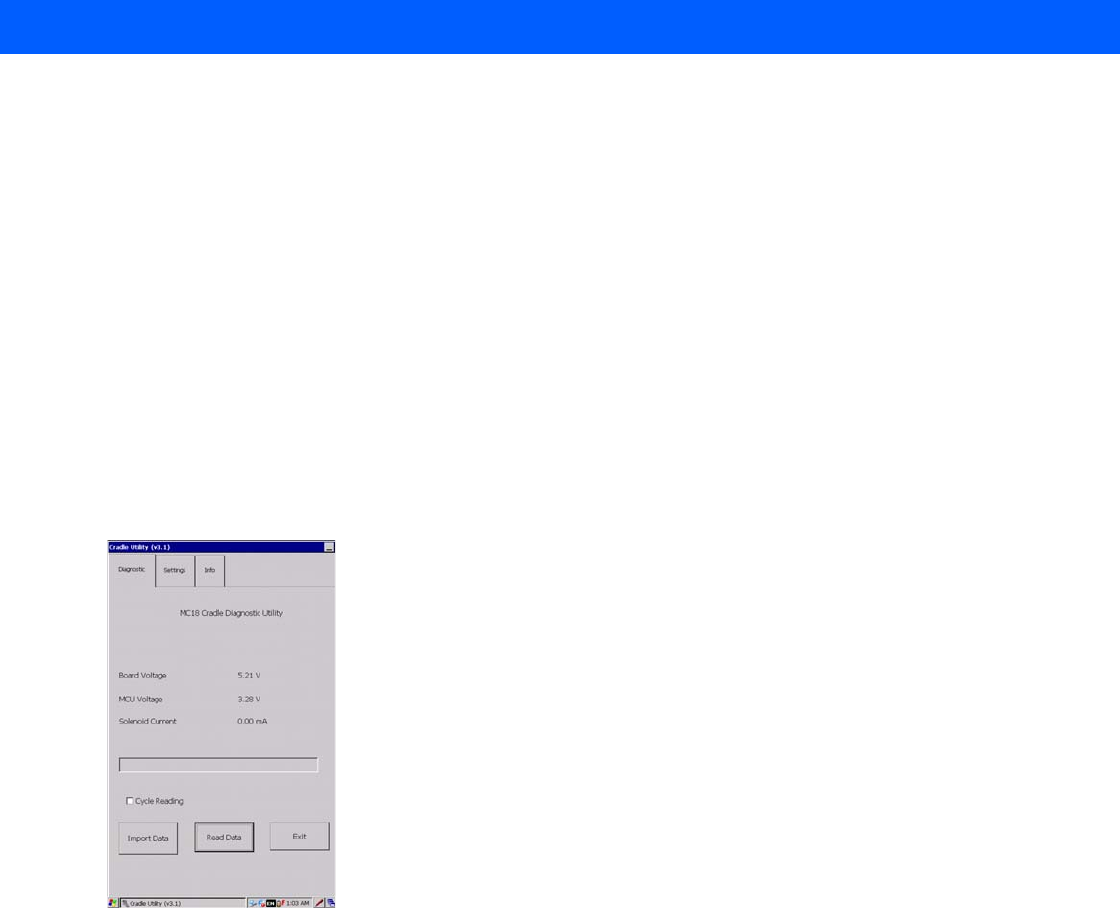
6 - 12 MC18 Product Reference Guide
o. Read Data: Retrieve setting data from the cradle memory and display on the screen.
p. Enable Fast Charge: Enable the cradle to charge the MC18 at a current of 1.5A (default setting is 1A)
q. Exit: Exit the Cradle Applications menu.
Performing Cradle Diagnostics
1. On the home screen of the MC18, double click the AppLauncer icon.
Result: The App Launcher screen is displayed.
2. On the AppLauncer screen, double click Cradle Applications > Cradle Utility.
3. Click the Diagnostics tab to perform the cradle diagnostics:
a. Cycle Reading: Check the Cycle Reading box to perform continues diagnostics and display the
cradle status information. During diagnostics, a progress bar is shown of the screen.
b. Import Data: Click to save the recorded results of the diagnostics on a file.
c. Read Data: Click to start performing diagnostics.
Viewing Cradle Information
1. On the home screen of the MC18, double click the AppLauncer icon.
Result: The App Launcher screen is displayed.
2. On the AppLauncer screen, double click Cradle Applications > Cradle Utility.
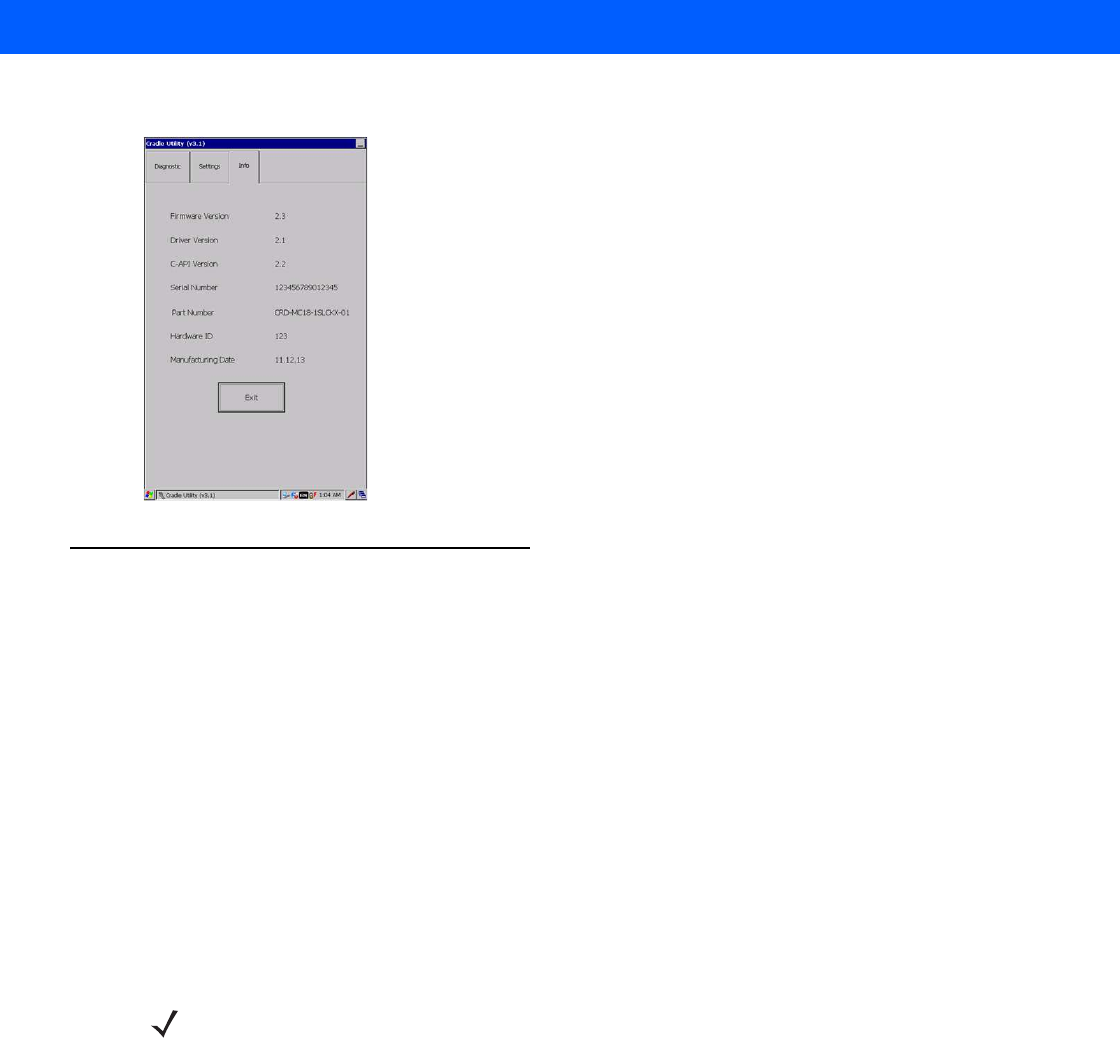
Special Considerations 6 - 13
3. Click the Info tab to read the cradle information:
MC18 Hardware Diagnostics
MC18 has an in built diagnostics engine that test the following hardware sections:
•
Battery health in percentage
•
Battery remaining capacity in minutes
•
Battery remaining capacity in percent (while charging and discharging)
•
Battery manufacturing date
•
Time remaining in minutes to be put in cradle for ‘x’ minutes of shopping trip
•
Time since battery was replaced last
•
Duration in which the battery was charged during the current charge cycle
•
Time since last reboot.
Use this procedure to view hardware diagnostics to the MC18
NOTE Performing hardware diagnostics to the MC18 can also be done through the Pocket Browser application.
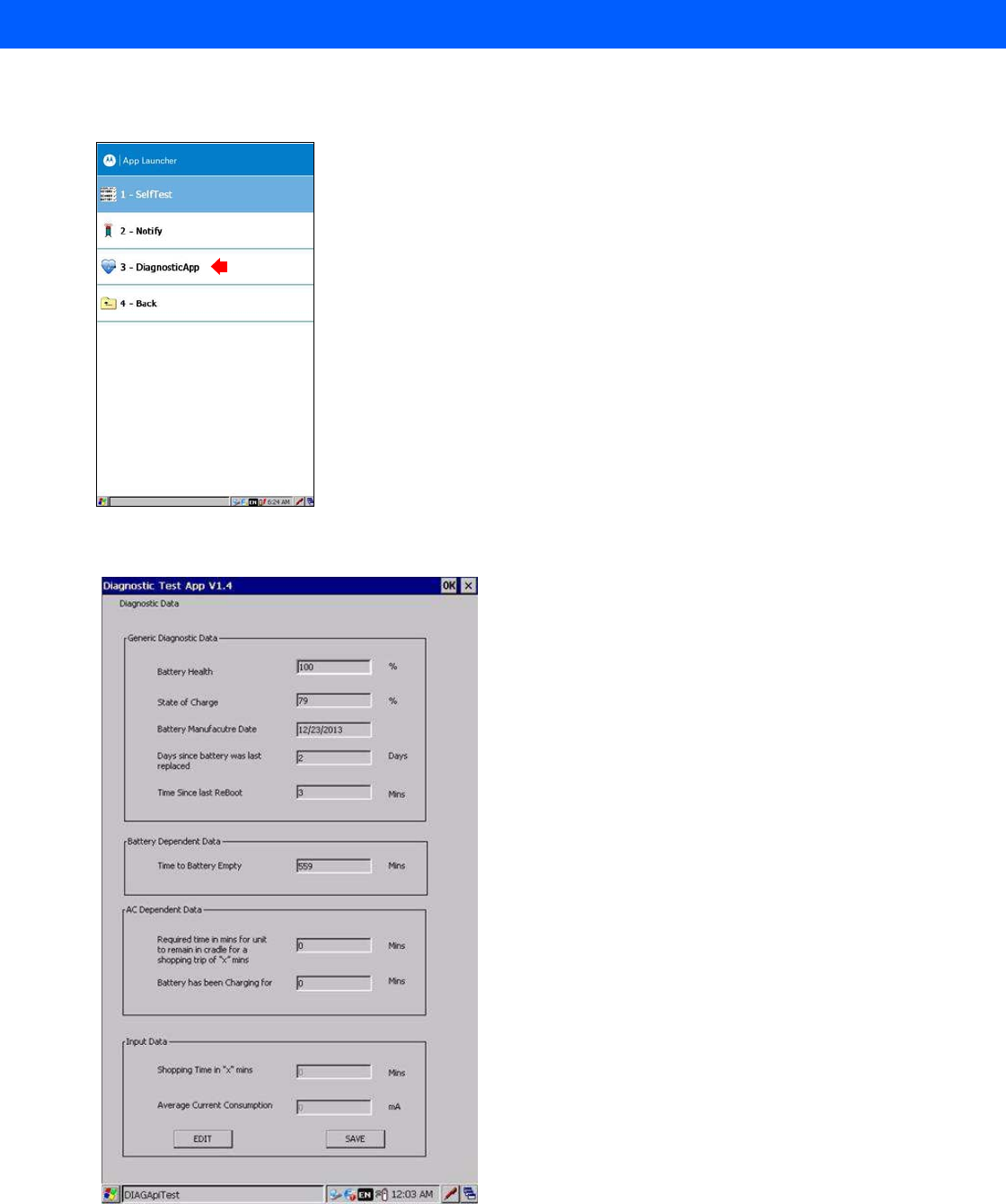
6 - 14 MC18 Product Reference Guide
1. On the App Launcher screen, click Test Applications.
Result: The Test Application menu is displayed
2. Click DiagnosticApp. |
Result: The Diagnostic Test App screen is displayed.
Figure 6-3
Diagnostic Test App Screen
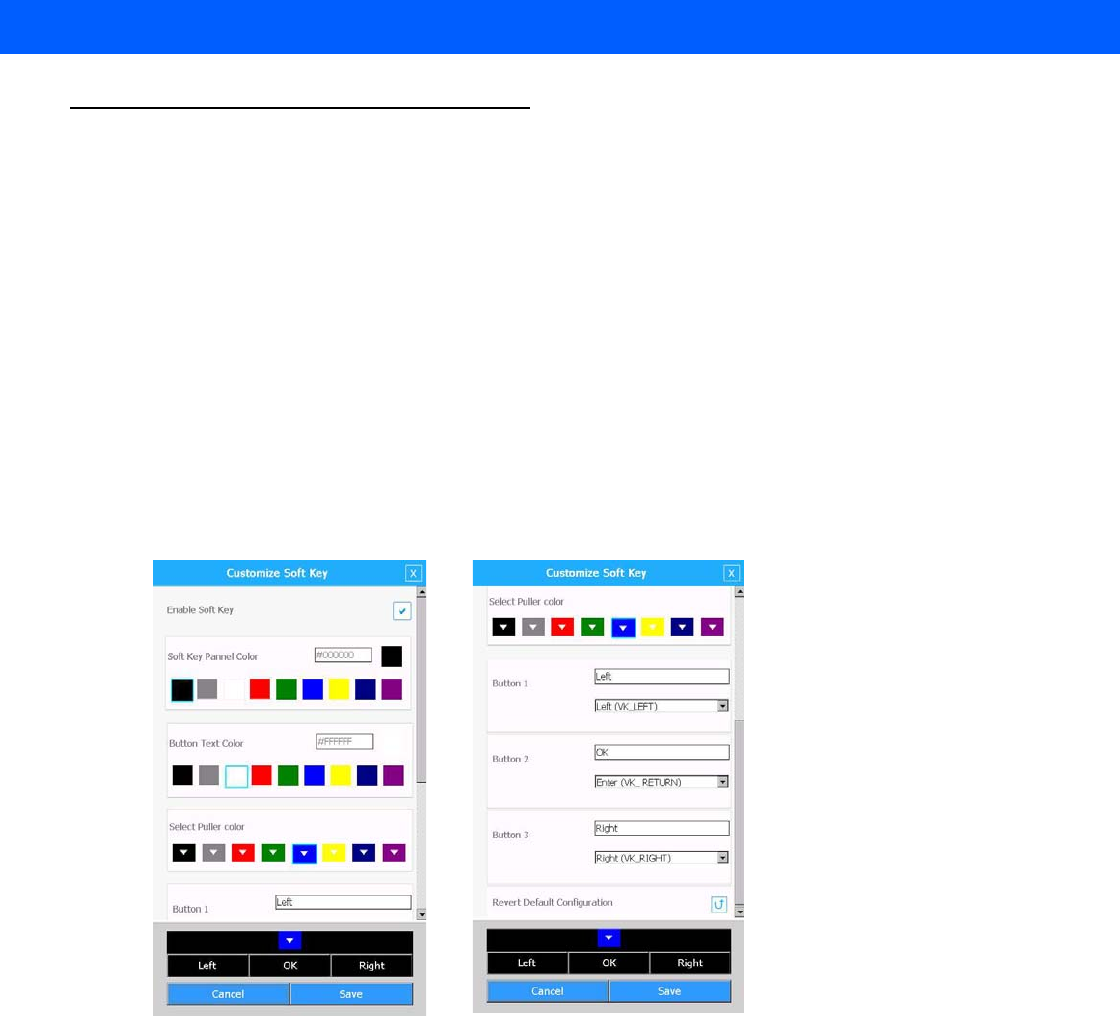
Special Considerations 6 - 15
Soft Button Panel
The Soft Button Panel application enables to create a soft button panel at the lower part of the MC18 screen.
The soft button panel includes three buttons that can be customize to perform the following basic keyboard
operations:
•
Up
•
Down
•
Escape (Esc)
•
Enter
•
Left
•
Right
Use this procedure to create and configure a soft button panel:
1. From the home screen of the MC18, click Start > Programs > Soft Panel Settings.
Figure 6-4
Soft Panel Settings Window
2. Check the Enable Soft Key box to enable settings.
3. Using the provided pallets, select the soft keys panel, buttons and puller color.
4. Scroll to the button of the window and type the text that will display on each button.
5. Use the drop menu to select the operation of each button.
6. Click Save.
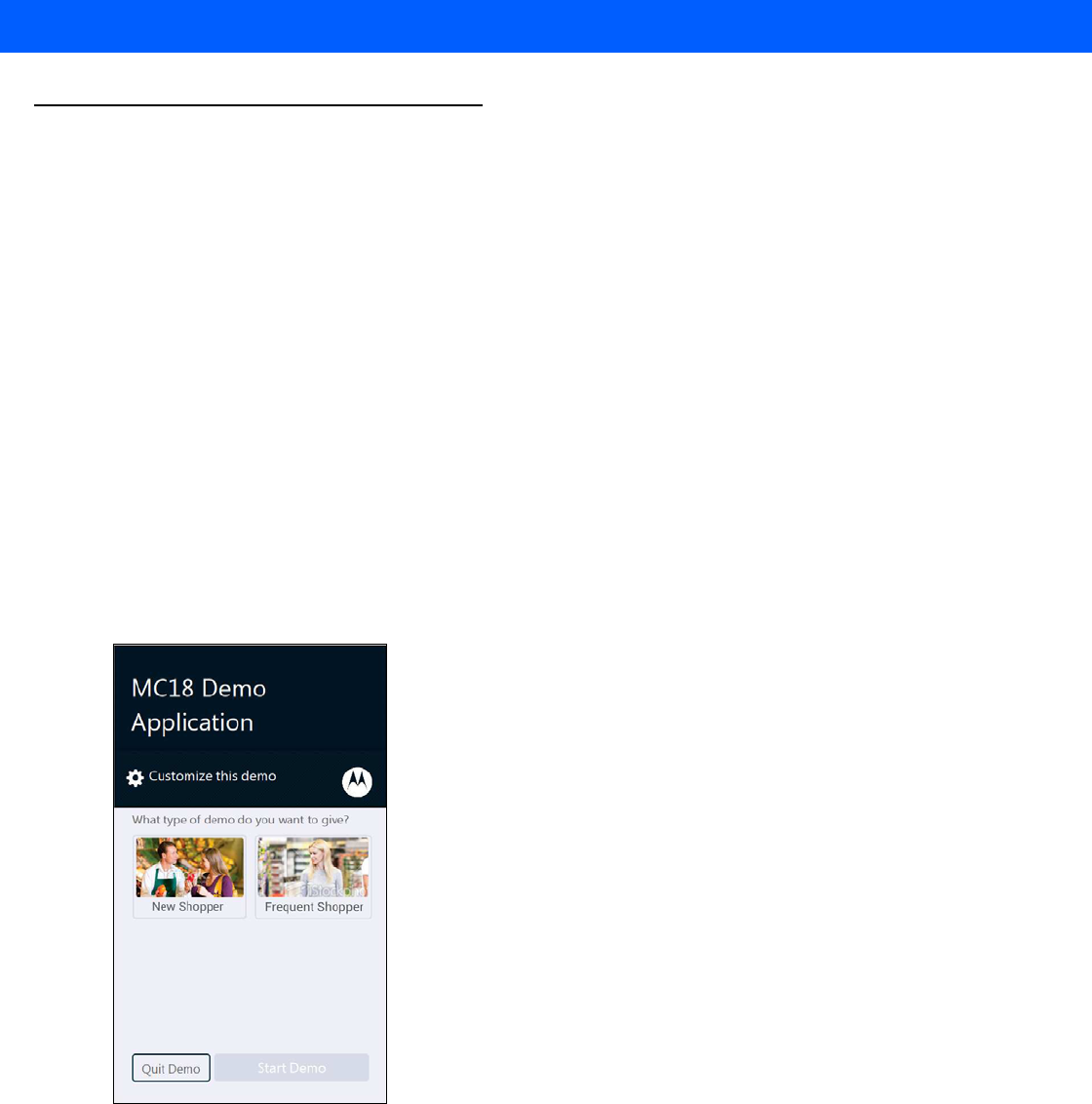
6 - 16 MC18 Product Reference Guide
MC18 Demo Application
The MC18 Demo application enables the customers to develop a self-service shopping assistance application.
The demo application can be custom to reflect your brand name, logo and text colors.
The application provides customers the following:
•
Plan a shopping list(s) at home and follow the list as they shop.
•
Scanning products as they shop, customers get accurate data before they pay.
•
Get total cost and saving information as they shop.
•
Target promotions based on the record of their shopping history.
•
Help find the products they are looking for and suggests related items to complement their primary
purchase.
Demonstrating the Application
To demonstrate the demo application:
1. To start creating a demo application, tap Start > Programs > MC18 Demo - the MC18 Demo Application
start screen is displayed.
Figure 6-5
MC18 Demo Application Start Screen
2. Tap on New Shopper to demo the experience of a new shopper or Frequent Shopper to demo the
experience of a frequent shopper.
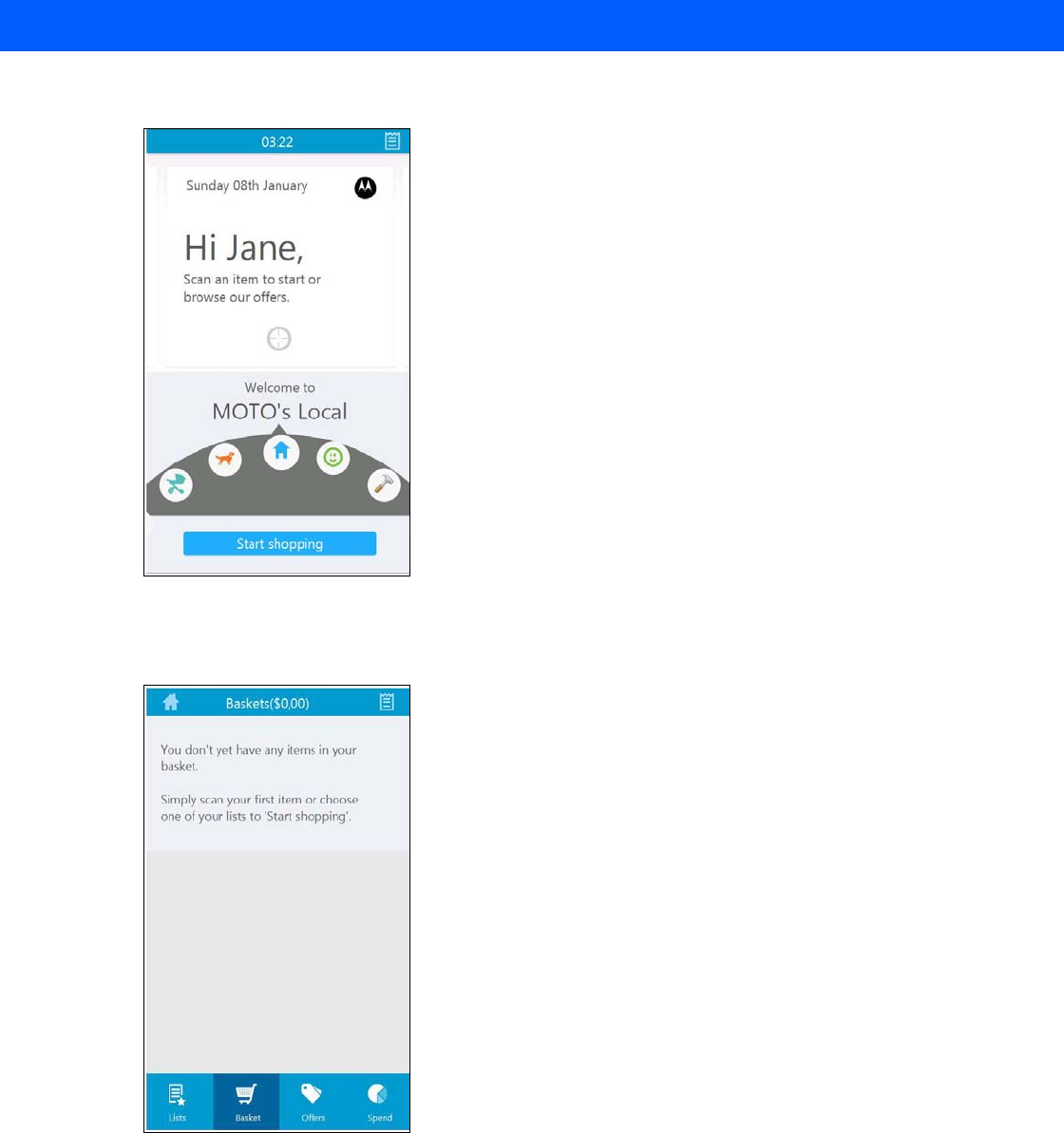
Special Considerations 6 - 17
3. Tap Start Demo to start the demonstration - the Welcome Shopper Screen is displayed.
Figure 6-6
Shopper Welcome Screen
4. Scan a product bar code to start shopping. Alternatively, turn the shopping dial left or right to view and
select offers, tips and social media content or tap Start shopping to see your Basket Screen.
Figure 6-7
Basket Screen
5. On the basket screen, tap a navigation icon to display:
•
Lists: Select a shopping lists with your products. A shopping list created at the customer home will
show and followed shopping.
The status of the products is indicated by the following icons:
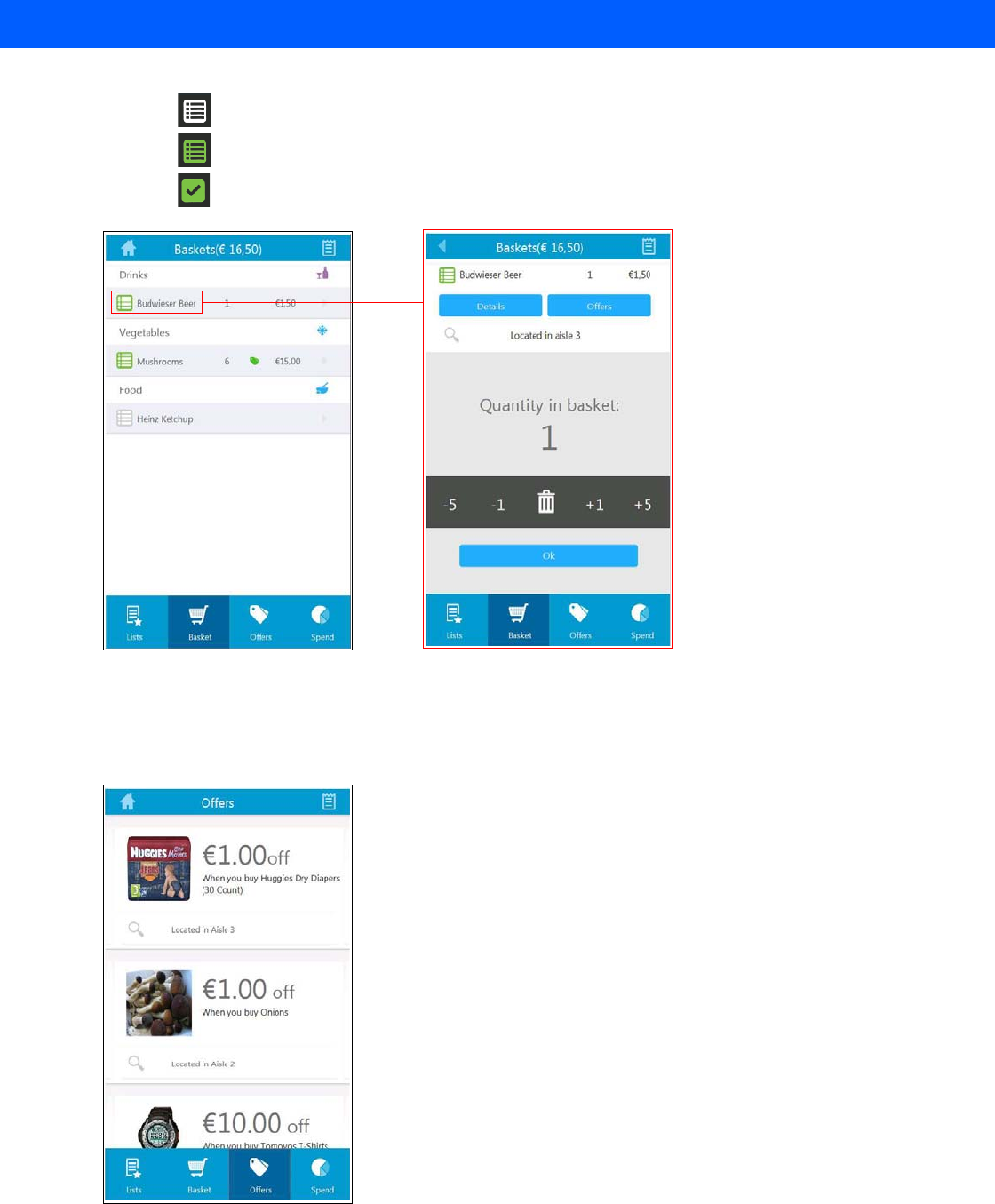
6 - 18 MC18 Product Reference Guide
• : Product on your shopping list that was not purchased yet
• : Product on your shopping list that you have purchased
• : Product you have purchased that was not on your shopping list.
Figure 6-8
Basket Screens
•
Basket: A list of all scanned products in your basket
•
Offers: List of special offers and location of the product on an aisle
Figure 6-9
Offers Screen
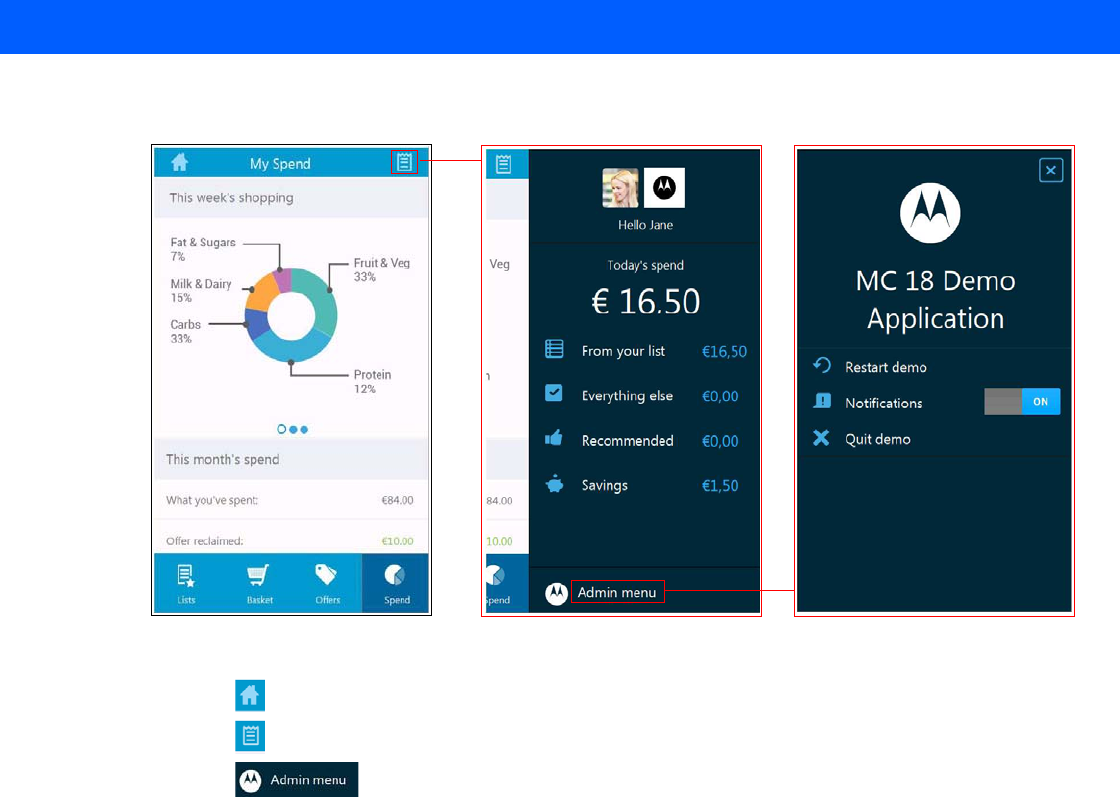
Special Considerations 6 - 19
•
Spend: Weekly and monthly spending information and analysis
Figure 6-10
Spend Screen
• : Tap to return to shopper welcome screen
• : Tap to display today’s spend information
• : Tap to restart, quit or enable/disable notifications
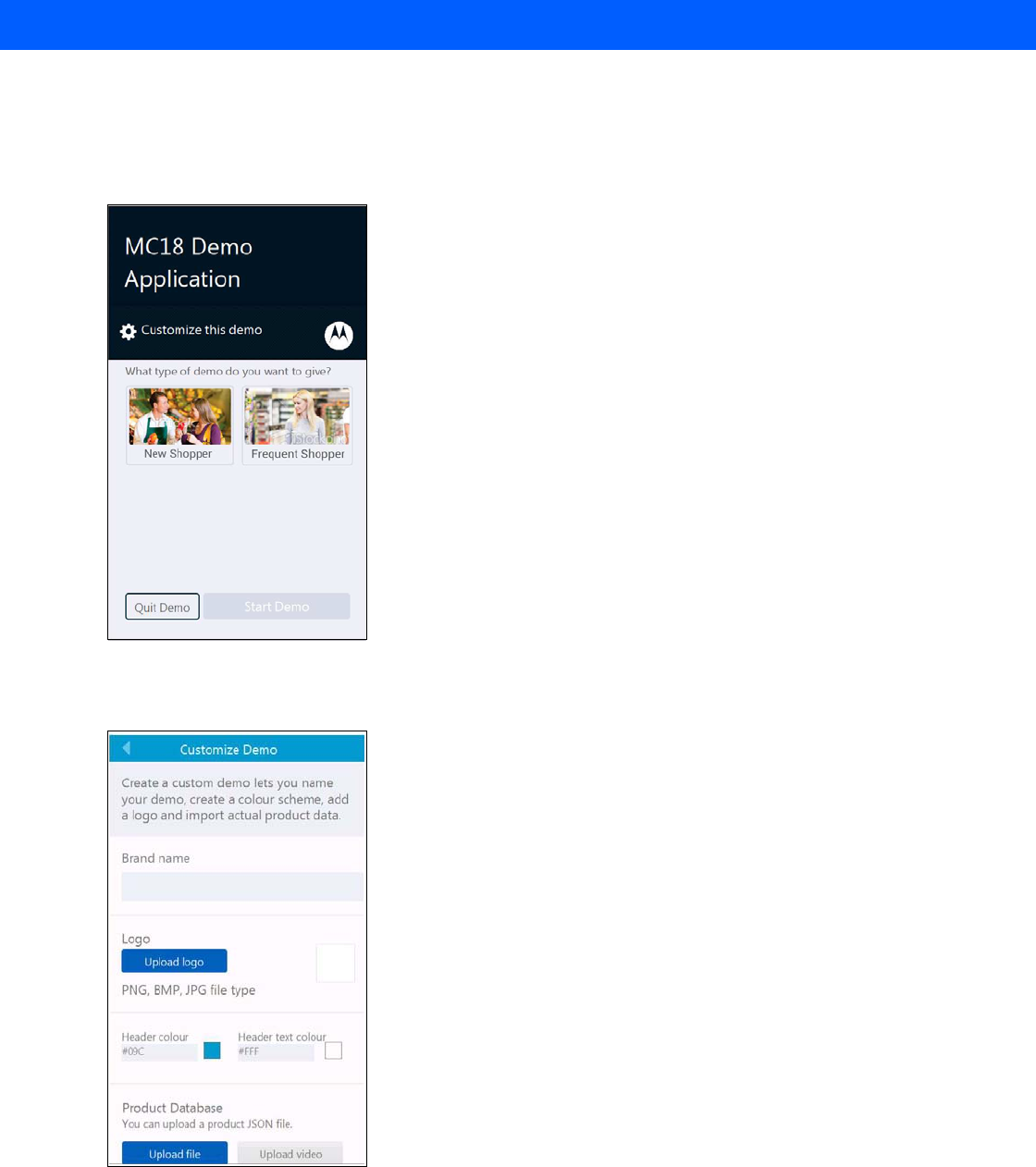
6 - 20 MC18 Product Reference Guide
Customizing the Application
To customize the application:
1. From the MC18 Demo Application start screen is displayed, tab Customize this demo.
Figure 6-11
MC18 Demo Application Start Screen
2. In the Customize Demo screen, enter Brand name, Logo and set the color of header and text.
3. Use the Upload file option to upload a database file in JSON (JavaScript Object Notation) format from the
MC18 or a web location.
4. Use the Upload video option to upload a video file from the MC18 or a web location.